How to write a process essay
- August 25, 2023
Process essays are one of the most common types of essays . It’s simply explaining a process of how to do something.
In this article, we’ll show you how to write a process essay in steps with interactive examples.
Process essay definition
Let’s take a look at the steps outlined below to write a clear and effective process essay.

Choose a topic
You should start by choosing a topic that not only interests you but also attracts your target audience.
Whether it’s brewing the perfect cup of coffee or conquering the art of origami, your topic should be engaging and well-defined. Let’s have a look at topic examples:
- Crafting Exquisite Miniature Bookbindings
- Building a Sustainable Vertical Garden
- Making the Perfect Cup of Coffee
So for this guide, I’ve chosen “Making the Perfect Cup of Coffee”. Now let’s continue with the next steps.
Create a process essay outline
Now that you’ve your topic at hand, it’s time to create an outline to present the steps chronologically. Outline will also help you organize your thoughts and ideas so you won’t get lost during the writing process.
Let’s examine this step with an example of a process essay explaining “Making the Perfect Cup of Coffee”.
Process essay outline example
- Thesis statement
- Provide safety precautions if necessary.
- Address to the reader
- Provide any variations or customization options if applicable.
- End with a memorable concluding thought or call to action.
By presenting the steps in chronological order, your readers can follow the process smoothly.
During this step, just make sure to:
- Expand on each step you outlined earlier.
- Use clear and concise language.
- Make use of bullet points or numbered lists to make the process visually appealing.
After completing the outline, it’s time to write an interesting introduction.
Write an introduction
- Hook the reader's interest with a hook sentence
- Offer a brief overview of the topic and its significance
- Introduce and explain the process with a thesis statement at the end of introduction
Process essay introduction example
Introduction
Now that we have an intro on our hand, you need to tell what materials you need to finish the process.
Write the materials needed for the process
Listing the necessary materials for the process is a best practice for process essays. Typically found just after the introduction, this paragraph is devoted to outlining the necessary materials.
Here, p rioritizing the list is important; the more influential a component is, the higher its position on the list should be.
Example material list for process essay
Body paragraphs
Materials needed
- High-quality coffee beans that align with your flavor preference.
- A grinder for optimal flavor extraction.
- Equipment for brewing methods, such as a pour-over apparatus, a drip coffee maker, a French press, or an espresso machine.
- Fresh and clean water for brewing.
- Optional additives like milk, cream, sugar, flavored syrups, or other preferred elements.
Start writing the process
Right after listing the materials needed, it’s time to start writing the process itself.
When describing your process, be careful not to make it too complicated. To keep your readers on track, use transitional words like “after,” “eventually,” “first,” “then,” and others help you maintain an understandable tone.
Or simply use a 1,2,3, bullet point structure as seen in example below to remind readers of their step during the process.
Body paragraphs - Process writing example
Materials needed ...
- Grind the beans just before brewing for optimal freshness. Use a burr grinder and adjust the coarseness to match your brewing method (coarse for French press, fine for espresso).
- Weigh your coffee grounds using a scale. A standard ratio is 1 to 2 tablespoons of coffee per 6 ounces of water, but adjust to your taste.
- Ensure the water is heated to the ideal temperature, typically between 195-205°F (90-96°C). Water that's too hot or too cold can affect the taste.
- Pay attention to the brewing time. Generally, 4-5 minutes is suitable for most methods, but again, adjust based on your preference.
- After finishing, regularly clean your coffee maker or French press to prevent rancid oils and residue from affecting your coffee's taste.
As seen from the example above, using an imperative language structure is generally preferable. It makes total sense as you’re describing a process in steps and usually don’t need a full sentence structure.
Give tips and supporting details
After explaining the process above, it’s now time to provide tips and supporting details. Here, make use examples, tips, and even warnings if necessary.
In other words, anticipate the questions your readers might have and address them as you go along.
Body paragraphs - Supporting details
Supporting details & tips
- Ensure safe handling of hot water and coffee-making equipment.
- Water that's too hot can result in over-extraction, while water that's too cold won't extract enough flavor.
Write a conclusion
At this step, you simply need to write a conclusion paragraph to end your process essay. First summarize the key points, and restate the process in a concise and short sentence. And finally, finish your process essay by a memorable sentence or a call-to-action.
Process essay conclusion example
Revise and polish your essay.
Now that you’ve written your essay, take a breath, and then come back for some editing. Check for consistency, correct sentence structure, efficient transitions , tense selection , and other linguistic issues that may arise.
If possible, make use of proofreading tools like QuillBot or Grammarly .
- Think about potential reader misunderstandings and address them. If needed, explain what should be avoided.
- Offer explanations for steps that might seem unusual or complicated.
- Define any unfamiliar terms or materials that the reader might not understand. This ensures clarity in your essay.
So you’ve successfully learned how to write a captivating process essay. Remember, practice makes perfect. The more you write, the better you’ll become.
Recently on Tamara Blog
How to write a discussion essay (with steps & examples), writing a great poetry essay (steps & examples), how to write a process essay (steps & examples), writing a common app essay (steps & examples), how to write a synthesis essay (steps & examples), how to write a horror story.
How to Write a Process Essay

The process essay, also known as the "how-to" essay, is commonly written for people or companies that need tutorials or a set of instructional steps. Whether it's building a robot or cooking a chocolate cake, process essays use a similar format for any variations. They follow a step-by-step style, with the initial step influencing the second, which influences the third, and so on. Each step carries its own importance, and a poor explanation of one step can ruin the entire process. It's important to stay concise and efficient. However, before you begin writing your essay, you should do some small preparations. Let's discover them with our research writing service .
What Is a Process Paper?
A process essay is a type of essay that explains a process step by step and gives guidance for a certain process, working mechanism, procedure, etc. Process essays range from very simple ones, such as instructions for how to ride a bicycle, to more complex ones, such as a chemistry lab report of an oxidative reaction experiment. The goal of a process paper is to give its readers guidance and directions.
Feeling Overwhelmed Writing a Process Essay on Your Own?
Simply send us your paper requirements, choose your paper writer and we’ll get it done fast.
A process paper is characterized, first of all, by explaining a process using a description. Some words that are frequently used in process essays are “further”, “then”, “next”, “first”, “last”, “finally”, and “initially”. It is really important to remember that every process essay includes features, such as:
- clear and straightforward narration - the last thing you want to do is to confuse your reader with complex language and an unorganized thought thread;
- chronological order - avoid skipping steps and shifting them around, as it will result in misunderstanding and frustration for the readers;
- transition words - make sure to separate the next step from the previous ones by using transition words;
- descriptions of the steps - make sure your steps are clear and easy to follow.
There are several types of process essays. The first one is directional - it explains the “how to” for something. It can take on a wide range of subjects, such as how to apply for a credit card, how to get your driver’s license, how to plan a wedding, etc. The outcome of the directional essay should be a result. In the cases of the examples above: a credit card, a driver’s license, or a carefully planned wedding. The other type of process paper is informational - it explains how something works. Here are some examples: how a weather forecast is determined, how a space rocket works, how intermittent fasting changes your body, etc. An informational essay explains something to a reader and does not necessarily end up with a result, like directional does.
Another type of essay that is similar to a process essay is a process analysis essay. The biggest difference is that a process analysis essay not only explains the steps, but also analyses them in depth. It has all of the characteristics of a process essay, although goes into more detail about the causes and consequences of every step.
If you need any additional information for process analysis essays, check out our article: HOW TO WRITE A PROCESS ANALYSIS ESSAY
Writing a process essay is not extremely difficult. By following simple rules and a set of steps, a successful, well-structured essay can be guaranteed.
Prepare The Small Stuff
Here we gathered some small general tips and advice combining with process essay examples that you should follow throughout your writing process to make sure that all of the expectations of a process paper are met.
- Determine the Audience's Skill Level. It's important to base the level of complexity of the essay on who the readers will be. For example, if you need to teach a friend how to do a simple fix or create a certain tool, then it would be most reasonable to stick to more basic terminology. However, if you are writing an essay for your astrophysics professor about the creation of a black hole in the universe, use more sophisticated and informative terminology.
- Make a List of Materials. Obviously, the creation of anything comes with some prerequisites. Whether it's items or ideas, the importance of knowing the necessities beforehand and having them ready to go is essential. Make sure to place each item in accordance with its importance. The more impactful a part is, the higher up on the list it should be.
- Write out Each Task. In a step-by-step tutorial, each individual task carries some sort of weight. Since an entire process can not be complete if a step is skipped, it's crucial to write out every single step. However, don't go overboard in your explanations. It's not necessary to bring the tutorial to a microscopic level, but each step should be understandable and competent.
If you still have difficulty writing, you can get essay help online from our service.
Process Essay Topics
Choosing a topic for a process paper can be quite challenging. A good place to start is with your passions. If you pick something you are excited about, you can make it interesting for your readers and fun for yourself to write about. If your professor limits you to write a process essay on something you have very little knowledge of, choose a topic that is intriguing and triggers your interest. Then, conduct enough thorough research to make sure you understand everything perfectly before you go ahead and try to explain it to someone else.

Another very important thing to consider while writing a process essay is your audience. It is highly unlikely that college students are interested in instructions for “How to Get Into Your Dream School” or “How to Pass Your SATs”. Make sure your topic relates to the subject you are studying and you are following your professor’s prompt guidelines.
Here are some ideas that might be of interest for you:
- How to lose weight on a keto diet
- How your immune system fights COVID-19
- How to start selling on Amazon
- How to improve your credit score
- How to decrease your social media usage
- How to apply for unemployment insurance
- How to improve your college performance
- How to open your first bank account
It's important to note that these essay topics are just some common examples used by several college students for their course papers. Feel free to use any one of them if you want, or think of one on your own. Just make sure it's a PROCESS!
Process Essay Outline
Most essay outlines follow the standard scheme: Intro > Body Paragraphs > Conclusion . follow the standard scheme: Intro > Body Paragraphs > Conclusion. A good process essay outline should look like this:

- Introduction — brief your reader on your topic, explain why you have chosen it and how you are planning to approach the explanation of the process.
- Body — the biggest part of your essay that should be divided into paragraphs for easier understanding and structure. Make sure each paragraph is flowing smoothly into the next one with connective words.
Paragraph 1. First step of the process. Explain what the step is, what the best way to perform it is, and how to avoid common mistakes when doing it.
Paragraph 2. The next step of the process (the same as in Paragraph 1). Thoroughly explain what this step is about.
- Conclusion . Here you need to explain why your instructions are valuable. It is your opportunity to persuade your reader(s) that the steps you presented and the process they learned will be useful for them in the future.
Every process is different: some can take a couple of minutes, while others can take months or years to complete. The length of the essay is generally based on the difficulty and number of steps it takes. However, the structure doesn't maneuver.
Introduction
The first thing that you want to do as a writer for your process paper is to help your readers be interested in your individual process. Be descriptive about it, paint a picture for your readers. A joke or a personal reference can be a great attention grabber and can pull your reader right in. For somebody to be keen on approaching your process, they have to express interest in it. Though, it generally goes without saying that many writers ignore this fact. Let's break it down into subsections:
- Give a little bit of historical background. People often want to know the origins of whatever it is that they're working on. Introducing this part of the process helps to intrigue your readers, as well as give them a sense of purpose for the task.
- Create an approximate timeframe. Unfortunately, your readers don't have all day to spend on this one event. In addition to learning about its purpose, people want to know how long the task will take. This way, they can decide how to break up the work. If it's a quick fix, then they can knock it out in one session. However, if it's a large-scale operation, then your readers will obviously have to create their own time schedule.
For example, let’s say that the topic of your essay is “How to Save Money”. You can start the introduction of your process essay by explaining that as a college student, you often find yourself in need of extra money and you are stuck with bad money habits. This will create a good connection with your readers, because almost everyone has been in a situation of needing to be savvy with their finances. Another thing you can mention is the importance of saving money and the multiple opportunities it presents, such as being able to invest it, being able to pay off a credit card debt, or being able to save up to avoid taking out a student loan.
Feeling Overloaded and Stressed?
Our professional writers are ready to help you 24/7!
Body Paragraphs
This is the point in the process essay where you start introducing the step-by-step process your readers will need to take. A lot of the time, it helps to break down each process into subsections. For example, if a step has many parts to it, it would be clever to create a paragraph on its own just for that step. Remember, it's important to keep things smooth and efficient. Break down the body paragraphs in unity with the steps. Let's go into more detail about each step:
Each step should be carefully explained. Every step will vary in length. Think about it: every instruction manual has several steps. Some are more difficult to comprehend or perform than others. For this reason, create your steps and explanations accordingly. You should be able to get a sense of their length and difficulty based on the explanation.
Don't forget to explain the purpose. People don't want orders barked at them aimlessly. Besides just accomplishing a task, people want to learn as they perform.
- Why did they do this?
- What was the purpose of this method?
- Why did we do it this way and not this other way?
To make everything flow smoothly use transitions. Make the steps flow one after another to create a well-structured essay. As you introduce the next step, consider using transition words like “next”, “now”, “then”, “so that”, etc.
Before writing the steps out in full sentences, it is a great idea to create an outline for your body paragraphs. Here is an outline for the body paragraphs of a process essay on “How to Save Money”:
Paragraph 1:
- keep track of your expenses
- organize your collected data
- decide what you can skimp on in your spendings
Paragraph 2:
- create a realistic budget
- check weekly to ensure you are sticking to it
- save 15% of every monthly income
- set a tangible goal for saving, such as a car
These process essay examples use only two body paragraphs, but feel free to include more to ensure a better understanding and cohesive flow for your paper. Although, do not include excessive unnecessary details that clutter your essay and make understanding it even more difficult. While writing your essay, include small brief explanations for each statement. For example, “Even though eating out and grabbing a coffee on your way to class sounds tempting, setting a budget and saving 15% of each of your monthly earnings aside can help you have enough to put down a downpayment on a new car.” Here the reader will understand that there is a direct relationship between each step and the result it is going to give.
Showing the readers that they are learning and not just repeating is one of the most effective ways to lock down their attention and keep them coming back!
After going through every step meticulously and explaining the whole process, a process essay needs a confident conclusion. This paragraph should be short, sweet, and to the point. It's main goal is to accomplish the following tasks:
- Discuss the main result. After the readers have completed the process, they should be left with a final result. It's important that you explain to your readers what the end result will look like, and what can be done with it.
- Restate the process’s general purpose. After completing the task, you obviously would like to know its overall purpose. When your readers feel that they have accomplished a challenge, learned something from it, and have a path to take the result towards, they will be satisfied!
- State your Overall Conclusion. To put a pretty tie around your process essay means that you need to neatly wrap things up! Restate some of the highlightable points as well as the process’s key overall purpose. Make sure that your readers feel accomplished after going through your process, and ensure that you strengthen the necessity of its purpose with a nice concluding sentence!
The conclusion of an essay on “How to Save Money” would explain that the completion of all of the steps will result in saving money that can be used for a specific goal or for rainy day fund purposes. You can mention the importance of every step and briefly repeat some of the key points.
Post-Writing Tips
Here are some final tips to wrap up your writing process. Use them as a checklist for a successful and coherent essay.
- Make sure the work is simple enough to follow. Worst-case-scenario: its author creates a feeling of absolute confusion in the reader’s mind. To avoid this problem, always remember that your readers can be beginners. Do not try to impress them with complicated words or sentences, use simple language to provide clear directions on how to do something. Give as many details as possible, but do it plainly. "Why is he making me do this?" "What was the purpose of this?" "I don't understand this step at all!" If the reader is asking themself these questions, then it's time to do some editing!
- Experiment and try it for yourself or ask a friend. There's no better way to experience success than to actively attempt your process through your own instructions. If everything truly makes sense, then you should have no problem solving the task using your own words. Even better, ask a peer to try it through your words to get an outside point of view.
- Choose the right topic for you and research it well
- Maintain a logical order of steps, make it easy to follow
- Avoid using imperative sentences - you do not want to sound like an Apple TV manual
- Explain terms that are most likely outside of most people’s range of common knowledge
If you have a ready-made essay but need to make significant changes to it, you can use our rewrite my essay service .
Process Essay Examples
Now that you know all about process essays and how to write them, we have prepared some great essay topic ideas in case you are stuck and cannot choose one:
Building a business from scratch is an intricate process that entails a number of steps. Each of these steps should have specific objectives and measurable outcomes.The following analysis gives the basic steps followed when building any business from scratch.
Saving can be defined as a differed consumption or keeping aside a portion of your income for unexpected future uncertainties or plans. Read for reason and actual steps for saving more money
Read also a thesis statement example from our author. In this article, you can learn something useful for yourself.
Still Need Help?
If you still feel like you could use some help with your process essay, do not hesitate to seek help from our writing service. Our writers specialize in a wide range of essays of different types including creative writing essay , process essays, and would be more than happy to assist you with writing, editing, or direction if you are feeling uneasy. Click the button below and college admission essay writer will process your requests fast.

Daniel Parker
is a seasoned educational writer focusing on scholarship guidance, research papers, and various forms of academic essays including reflective and narrative essays. His expertise also extends to detailed case studies. A scholar with a background in English Literature and Education, Daniel’s work on EssayPro blog aims to support students in achieving academic excellence and securing scholarships. His hobbies include reading classic literature and participating in academic forums.

is an expert in nursing and healthcare, with a strong background in history, law, and literature. Holding advanced degrees in nursing and public health, his analytical approach and comprehensive knowledge help students navigate complex topics. On EssayPro blog, Adam provides insightful articles on everything from historical analysis to the intricacies of healthcare policies. In his downtime, he enjoys historical documentaries and volunteering at local clinics.

How to Write a Process Essay?
18 June, 2020
14 minutes read
Author: Tomas White
What is a “process essay”? What makes it different from dozens of other papers you create on a daily basis? What are its main components and what the main goal of this type of writing you need to bear in mind? If you're looking for answers to these questions, you're in luck! You can get them all from our academic guide on how to write a process essay.

Composing a process essay can be rather complicated especially if you are not familiar with this type of writing and do not know what pitfalls and specifications to pay attention to.
That is why our custom essay writing service has created this guide to help you tackle this task. We will answer all these questions in our article below and even provide you with great process essay examples and topics you can write on to stand out. So, if that sounds like something you need right now, read on: we are here to help and equip you with knowledge!
But first things first. Since it is impossible to create an excellent process essay without crystal clear understanding of the term, we will start with the definition. So, let’s dive in!
What is a process essay?
A process essay is commonly written either to explain how something works or to guide a reader through the process of completing a particular task, states the process essay definition.
Process essays also go under the “How-to articles” title and aim to teach the target audience how to achieve certain goals or complete specific assignments.
So, look at it like this. In case of “How to quit smoking” process essay, your primary goal is to provide several helpful ways of quitting this habit. These might be evidence-based recommendations if you have experience in this area, or simply common sense ideas you found while conducting your research.
Now that you realize what you will be working with, let’s look into different types of process essays and practical ways to compose them. Our essay writing guide will walk you through the process essay writing step by step.
Types of process essays
There are two main types of such papers: the ones that explain how something works , and those that show you how to complete a particular task .

1. How to do something.
Though it sounds quite self-explanatory, we’d like to emphasize the importance of clear instructions in case you are writing a process essay.
Your readers must be able to follow your guidance and complete each step successfully. So, split the process into small steps, keep it short and to the point at each stage of crafting a process essay.
For instance, in a “How to quit smoking” process essay , you can split the whole process into seven steps:
- Choose a date for a quit day;
- Imagine life without cigarettes and expect it;
- Have one last cigarette as a “Goodbye!”;
- Be among people to support you;
- Keep your goal in perspective not to give up;
- Don’t fall for substitutes;
- Be accountable.
2. How something works.
By contrast, this is an informative type of writing that aims to achieve one goal – explain the principle of work behind some process. Unlike the mentioned above type, this process essay type does not encourage a reader to take an action and do something step by step.
However, you must make sure that by the end of your essay, the audience will know for sure how something functions.
As an example of this type of a process essay, let’s see how an earthquake happens .
- First, the energy within the earth core builds up due to various moves in the earth crust;
- The energy level grows up and causes tension in the tectonic plates;
- After some time, the pressure radiates outwards by moving the plates from each other;
- The seismic waves shake the earth as they get from the core of the earth to the surface;
- That is when the earthquake takes place.
Before we go any further, let’s look at another example. In case of “How to prepare for a vacation” process essay, your task is to compose a few steps that your readers can take when getting ready for their vacation. In other words, you are describing how to do something.
Meanwhile, “What happens to your brain when you sleep” process essay is merely an explanation of the principle. In it, you are not encouraging readers to take any actions whatsoever. So, here is the fundamental difference.
How to write a process essay?

Getting started with process essay writing
When developing a process essay outline, take some time to answer the following questions:
- Who is your target audience? How deep is their knowledge of the subject? The complexity of your essay depends on their skills level. Thus, for instance, when explaining to your peers how to stretch a dollar to see the world, you can use basic terminology and examples they can relate to. However, your vocabulary should be way more sophisticated if you are writing a process essay on how to improve the overall quality of higher education in your state to the City Council.
- How can you divide the process into small steps? You do not want to bore your audience to death with unnecessary details in a process essay. Yet, you cannot afford to skip valuable steps if they are crucial to the overall understanding of the subject of your process essay. So, try to find the golden cut and figure out the most suitable amount of steps.
- What sources will you use for the task? It goes without saying that you can only use reliable sources to support your argument in a process essay. These sources should be all mentioned in the end of your essay. And remember about proper in-text citation styles. Read the materials carefully and take only the information that will add value to your essay and helps make it shine.
How to write a process essay outline
Finally, let’s look into the process essay structure. Needless to say that you must start with something that will grab readers’ attention, or in other words, “a hook.”
It is true for any essay, and process essay writing is not an exception.
The structure of your essay regardless of the process essay topics should consist of:
- A powerful introduction.
- Main body paragraphs.
- An interesting conclusion.
Related Post: Essay outline | Research Paper outline
Sounds simple, yet there are several things you should not forget about process essay writing.
How to write an introduction to a process essay
Once you compose a hook, mention why you believe that readers should use your approach to solve a problem even though there are dozens of other ones. We know two effective ways to achieve this in your process essay:
- Show how much time this task will take . People don’t have all the time in the world to tackle just this one task. So, you’ll really help them by stating how much time completing something using your approach will take and underline that with your approach described in a process essay it will take less time than if they opt for a different one. “Writing can be tough, especially if you always felt that it is not exactly your suit. However, Michael D. Pollock, a credible expert in this area, has recently presented 10 effective tips that will help you learn writing fast and make you able to craft a 1000-word article in 30 minutes. So, keep reading to find out how you can write this fast too.”
- Introduce your audience to the historical background of the approach (if any) you’re using in a process essay. Let them see the roots of your solution. Here is what a good introduction of a process essay should look like: “Giving a speech with lots of eyes concentrated on you is not an easy task. No wonder so many students dread this task. However, speech can be a powerful tool, and we can teach you how to give them right. Steve Jobs is known as one of the best public speakers of our time. People were sitting on the edge of their seats when he spoke. And we’ll teach you how to grab attention like he did using just five simple tricks he applied.”
At last, compose an engaging thesis of a process essay. Many students consider it a scary part. But it all goes down to this.
Your thesis statement should reason why your way is the best and why readers looking for answers should search no more and give your solution a chance.
It’s easier than you think. Here is a good thesis statement example:
“With more than 580 million tons of household waste produced all over the world, Every tiny effort you make to become eco-friendly counts. And if you don’t want to spend extra money on sustainable products but want to save the environment, use our guide on ten simple eco-friendly steps you can do daily without even noticing it!”
This is what a thesis statement for a process essay on how to be eco-friendly would look like. Yours can be different, but you get the idea!
How to plan main body paragraphs
- Dedicate one body paragraph to one point you want to bring to light.
- Provide enough details on each step including the ultimate goal of this step and reasons why this method was chosen for its achievement.
- Keep it short and to the point.
How to write a conclusion
Now is that time you reminded the readers about the purpose of a process essay, reasons why you chose this particular approach, and briefly mentioned steps needed to accomplish the task.
Besides, you can call your audience to action but only in case you are writing an essay that shows how to do something. Otherwise, it will be inapplicable.
Finally, help them set their expectations right: what results can they count on in the end? How long will it take them to achieve those results after reading your process essay and applying its tips?
How to use transition words in a process essay
Transition words can help you create a seamless reading experience. You can take readers smoothly from one step to another. And what is more you can help them immerse into the process!
Therefore, begin each new paragraph with a transition word, add one in between examples you provide, and summarize your instructions with them, too.

Think of transition words as of bridges that connect paragraphs and sentences. They make smooth communication between the two possible. And with them in your process essay, no reader feels irritated or frustrated with your writing style, as they have to stumble upon every other sentence in your piece.
Good process essay topics
It is not enough to just know the theory to create a good process essay. One should also come up with a topic that will be both interesting and useful to his readers. Here’s a list of our suggestions on process essay ideas:
- How to choose a perfect future career.
- How to survive college and stay sane.
- How to eat healthy on campus.
- How to balance your social and academic life.
- How to pay out a student loan while still at college.
- How to improve your public speaking skills.
- How to see the world with only $100 in your pocket.
- How to learn a foreign language.
- How to renovate your apartment and not go bankrupt.
- How to start your own business.
- How to prepare for your first interview.
- How to get volunteers to help you clean the neighborhood.
- How to write a life list.
- How to set boundaries in the relationship.
- How to study overseas for free.
Related Posts: Argumentative essay topics | Compare&Contrast essay topics
Process essay writing tips
Wrapping up, we would like to introduce you to a couple of vital recommendations on process essay writing:
- Your process essay subject cannot be too broad or too narrow. Look out for the golden cut!
- Introduce your readers to possible complications of the process. After all, forewarned is forearmed.
- Create a short vocabulary your audience can use in case they are not familiar with the terminology essential to the general understanding of the process essay in question.
- Develop a list of resources your readers will need as they deal with certain tasks. This way you will have them prepared to put your recommendations to action right away.
- Always write a process essay using Active Voice!
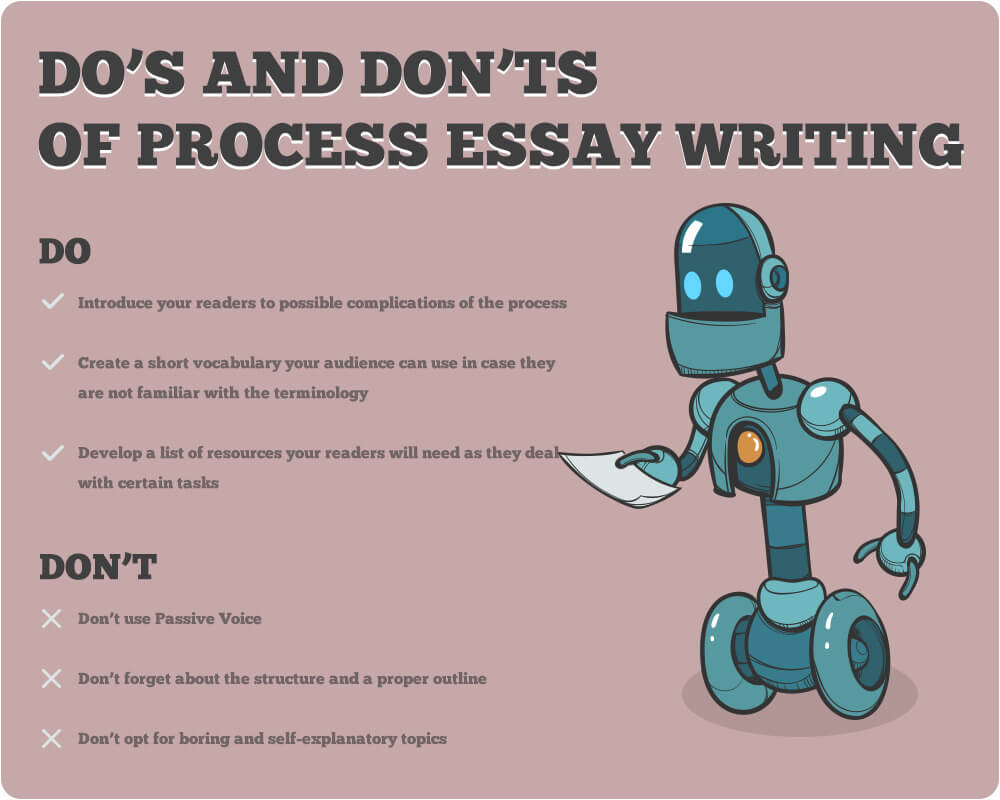
Need help with your process essay writing? Handmadewriting is here for you to help. Drop us a line to get our professional essay writers to develop an excellent piece for you!

A life lesson in Romeo and Juliet taught by death
Due to human nature, we draw conclusions only when life gives us a lesson since the experience of others is not so effective and powerful. Therefore, when analyzing and sorting out common problems we face, we may trace a parallel with well-known book characters or real historical figures. Moreover, we often compare our situations with […]

Ethical Research Paper Topics
Writing a research paper on ethics is not an easy task, especially if you do not possess excellent writing skills and do not like to contemplate controversial questions. But an ethics course is obligatory in all higher education institutions, and students have to look for a way out and be creative. When you find an […]

Art Research Paper Topics
Students obtaining degrees in fine art and art & design programs most commonly need to write a paper on art topics. However, this subject is becoming more popular in educational institutions for expanding students’ horizons. Thus, both groups of receivers of education: those who are into arts and those who only get acquainted with art […]
5 Process Essay Examples

Chris Drew (PhD)
Dr. Chris Drew is the founder of the Helpful Professor. He holds a PhD in education and has published over 20 articles in scholarly journals. He is the former editor of the Journal of Learning Development in Higher Education. [Image Descriptor: Photo of Chris]
Learn about our Editorial Process
A process essay is a type of essay that explains a process in detail. Good process essays don’t just explain the process but provides details about common mistakes to avoid as well as tips and methods to achieve success. Below are some example essays:
Process Essay Examples
#1 how to bake a chocolate cake.
1337 Words | 4 Pages

Thesis Statement: “The purpose of this essay is to guide readers through the enjoyable and straightforward process of baking a chocolate cake, highlighting the essential steps and tips to ensure a delicious and successful outcome.”
#2 How to Write a Resume

Thesis Statement: “This essay aims to provide a comprehensive guide on crafting an effective resume, detailing each step from gathering relevant information to finalizing the document, while offering practical tips and common pitfalls to avoid, ensuring a polished and professional presentation of one’s career achievements and qualifications.”
#3 How to Train for a Marathon
1508 Words | 5 Pages

Thesis Statement: “This essay provides a comprehensive guide to marathon training, detailing a strategic approach to building endurance, strength, and speed, coupled with essential advice on nutrition, hydration, and mental preparation, to equip runners of all levels with the knowledge and tools necessary for successfully completing a marathon.”
#4 How to Prepare for a Job Interview
1309 Words | 5 Pages

Thesis Statement: “This essay outlines a comprehensive strategy for job interview preparation, encompassing in-depth company research, personalized response formulation, professional presentation, and logistical planning, to equip candidates with the tools necessary for making a compelling and confident impression in their pursuit of career opportunities.”
#5 How to Write an Essay
1473 Words | 5 Pages

Thesis Statement: “This essay outlines a comprehensive, step-by-step approach to essay writing, from understanding the prompt to the final stages of revision and editing, providing essential tips and strategies to enhance writing skills and ensure the creation of a well-structured, persuasive, and effectively communicated piece.”
How to Write a Process Essay
The following template provides an overview of a process essay structure:

Grab this process essay template here.
Instructions: To write a process essay, start by introducing the process and its significance, ensuring the reader understands the purpose and value of the instructions. Next, present the preparation and materials required, before outlining each step of the process in a logical order, offering detailed explanations, tips, and potential pitfalls to avoid, ensuring clarity and ease of understanding. Conclude by summarizing the main steps and reinforcing the benefits or results of completing the process, leaving the reader with a clear understanding and the confidence to undertake the task.
How to Write a Thesis Statement for a Process
To write a thesis statement for a process essay, identify the process you’re explaining and clearly state the purpose or goal of the essay. Concisely outline the primary steps or stages involved in the process, ensuring clarity and direction for the reader. The thesis should be informative, indicating what the reader can expect to learn and achieve by following the essay.
💡 AI Prompt For Writing a Process Essay Thesis Statement “Create a thesis statement for a process essay on [TOPIC] that clearly identifies the specific process being explained. The thesis should state the purpose of the essay and briefly outline the main steps or stages involved in the process. Ensure that the statement is concise, informative, and guides the reader on what they will learn and achieve by reading the essay.”
Read Also: 101 Thesis Statement Examples
Suggested Process Essay Topics
For Grades 4 to 8:
- How to Organize a School Backpack.
- Steps to Create a Simple Science Fair Project.
- The Process of Planting and Caring for a Vegetable Garden.
- How to Write a Book Report.
- Making a Handcrafted Greeting Card.
For Grades 9 to 12:
- How to Prepare for the SATs.
- Steps for Conducting a Basic Scientific Experiment.
- Crafting an Effective Persuasive Essay.
- Planning and Executing a Community Service Project.
- The Process of Creating a Personal Budget.
For University/College:
- How to Conduct a Literature Review for a Research Paper.
- Writing a Successful College Application Essay.
- The Process of Developing a Mobile App.
- How to Create a Comprehensive Marketing Plan.
- Steps for Conducting a Qualitative Research Study.
- Preparing and Delivering an Effective Oral Presentation.
- The Process of Writing a Business Plan.
- How to Analyze a Case Study in Business School.
- Crafting a Dissertation or Thesis Proposal.
- Developing and Implementing a Personal Fitness Plan.
Ready to Write your Essay?

Take action! Choose one of the following options to start writing your essay now:

- Chris Drew (PhD) https://helpfulprofessor.com/author/chris-drew-phd-2/ 10 Reasons you’re Perpetually Single
- Chris Drew (PhD) https://helpfulprofessor.com/author/chris-drew-phd-2/ 20 Montessori Toddler Bedrooms (Design Inspiration)
- Chris Drew (PhD) https://helpfulprofessor.com/author/chris-drew-phd-2/ 21 Montessori Homeschool Setups
- Chris Drew (PhD) https://helpfulprofessor.com/author/chris-drew-phd-2/ 101 Hidden Talents Examples
Leave a Comment Cancel Reply
Your email address will not be published. Required fields are marked *

- JCTC Learning Commons
- Learning Guides
- Writing and Research Process
Writing Academic Essays
- Process Essay
- Introduction
- Classification Essay
What is a process essay?
Transitions, topic selection.
- Compare and Contrast Essay
- Cause and Effect Essay
- Argumentative Essay
- Reaction Essay
- Grammar This link opens in a new window
- More Resources
Get in Touch

Available Mon - Thurs 10am - 6pm Friday 10am - 2pm
Try Our FAQs
Learning Commons Quick Links

Tutoring - Writing, math and more
Learning Guides - Quick learning
Hours - Find out when we're open
Library Search - Find materials
Databases - Articles and more!
InterLibrary Loan - Request books
Books - Recommended books
eBooks - Thousands of free eBooks
Streaming Video - Learn by watching
Use the Library Search to find books, eBooks, articles, and more!
You can find Learning Commons information, book recommendations and so much more on JCTC's social media.

A process essay is a step-by-step guide on how to do or make something. It is important to include every step of the process, even if something appears self-explanatory. Your audience might not be as familiar on the topic as you are.
What may be equally important, and is often overlooked, is what not to do. For example, the process of making caramel is deceptively simple. The sugar mixture needs to be swirled to prevent burning. However, stirring the mixture will cause the molecules to agitate, making the syrup crystalize into a solid unusable lump. So, when writing a process essay on caramel it is equally important to define swirling and to caution against stirring.
Since a process essay is a series of instructions, transition words are an important component. Transitions establish connections between ideas. They can be a single word that imparts a logical order or sequence to your writing, or it could be an entire sentence that connects one paragraph to the next.
Transition Words
| Time or Order | Addition | Generalization | Cause and Effect |
|---|---|---|---|
| Next | And | In general | Therefore |
| During | In addition to | Generally | So |
| While | In the same manner | Overall | Thus |
| Following | Furthermore | On the whole | Because |
| After | Moreover | In short | Owing to |
| Firstly | Equally important | Accordingly | |
| Lastly | Also | Consequently | |
| Secondly | Likewise | Hence | |
| Later | At the same time | Subsequently | |
| Then | In fact | For this reason | |
| To begin with | |||
| Contrast | Illustration | Emphasis/Persuasion | Conclusion |
| On the other hand | For example | Clearly | In conclusion |
| But | As an example | Obviously | To conclude |
| Nevertheless | Such as | Importantly | To sum up |
| Despite | For instance | Chiefly | Finally |
| However | To demonstrate | In particular | |
| Except | Specifically | Especially | |
| Otherwise | Actually | ||
| Yet | |||
| Whereas | |||
| Alternatively | |||
| In spite of this |
If you have not been given a topic, choose one that you feel confident in explaining to your audience. Refer again to the introduction section of this guide to find information on progression and organization. Brainstorming and creating an outline will help you avoid missing any steps or directions. Here are a few topic suggestions for a process essay:
- Car Mechanic
- Cellular Structure
- Applying for a Green Card
- << Previous: Classification Essay
- Next: Compare and Contrast Essay >>
- Last Updated: Jan 23, 2024 2:52 PM
- URL: https://jefferson.kctcs.libguides.com/Essay
- PRO Courses Guides New Tech Help Pro Expert Videos About wikiHow Pro Upgrade Sign In
- EDIT Edit this Article
- EXPLORE Tech Help Pro About Us Random Article Quizzes Request a New Article Community Dashboard This Or That Game Happiness Hub Popular Categories Arts and Entertainment Artwork Books Movies Computers and Electronics Computers Phone Skills Technology Hacks Health Men's Health Mental Health Women's Health Relationships Dating Love Relationship Issues Hobbies and Crafts Crafts Drawing Games Education & Communication Communication Skills Personal Development Studying Personal Care and Style Fashion Hair Care Personal Hygiene Youth Personal Care School Stuff Dating All Categories Arts and Entertainment Finance and Business Home and Garden Relationship Quizzes Cars & Other Vehicles Food and Entertaining Personal Care and Style Sports and Fitness Computers and Electronics Health Pets and Animals Travel Education & Communication Hobbies and Crafts Philosophy and Religion Work World Family Life Holidays and Traditions Relationships Youth
- Browse Articles
- Learn Something New
- Quizzes Hot
- Happiness Hub
- This Or That Game
- Train Your Brain
- Explore More
- Support wikiHow
- About wikiHow
- Log in / Sign up
- Education and Communications
- College University and Postgraduate
- Academic Writing
How to Write a Process Essay
Last Updated: December 6, 2023 Fact Checked
This article was co-authored by Jake Adams . Jake Adams is an academic tutor and the owner of Simplifi EDU, a Santa Monica, California based online tutoring business offering learning resources and online tutors for academic subjects K-College, SAT & ACT prep, and college admissions applications. With over 14 years of professional tutoring experience, Jake is dedicated to providing his clients the very best online tutoring experience and access to a network of excellent undergraduate and graduate-level tutors from top colleges all over the nation. Jake holds a BS in International Business and Marketing from Pepperdine University. This article has been fact-checked, ensuring the accuracy of any cited facts and confirming the authority of its sources. This article has been viewed 169,360 times.
A process essay, otherwise known as a how-to essay, tells a reader how to perform a particular task. The best process essays follow a clear step-by-step organization. Start by providing your reader with a time estimate and general summary of the task. Then, move on to a more detailed explanation of each and every necessary step. When you are finished with your essay, read it over carefully to ensure that you haven’t left anything out.
Getting Ready to Write

- For example, a process essay intended for professional chefs could probably skip a description of how to chop carrots and just say, “Finely chop the carrots,” instead.

- You could also include a comprehensive “Things You’ll Need” section at the beginning of the paper. Or list the materials needed after the introduction.
- If an item on the list is a bit unusual, such as a particular type of hand tool, then make sure to clearly introduce it within the text. For example, “The pin hammer has a finer tip than a standard hammer, making it suitable for more detailed work.” You can also include a picture of the item, particularly if the essay will be published online.

- If you are writing an essay about how to cook lasagna, your initial outline might just state, “Mix in basil.” Before you start writing, you could expand your outline to say, “Briefly mention taste differences between dried and fresh basil.”
- Note that the more specific your article or essay topic, the more specific your details needs to be.
Crafting an Introduction

- For instance, you might write, “The process of preparing lasagna has a rich heritage all of its own.”

- If your process essay focuses on a cooking task, this is where you might advise your readers to consult the ingredients or materials list and put every item on the counter.
- For example, you might write, “This recipe requires 30 minutes of active preparation time, along with 45 minutes of baking time.”

- For example, your thesis might be, “This essay will explore how to create a complicated lasagna dish in a short period of time by preparing the noodles and sauce in advance.”
Writing Your Body Paragraphs

- Be especially careful with items that contain multiple steps. Make the transitions clear and acknowledge prior steps regarding a particular item, if applicable.

- For instance, when making pasta, consider writing a paragraph on how to boil pasta and another paragraph on how to make the sauce. This separates the ideas for easy clarification.

- For instance, you could write, “Next, place the pot on the stove,” to move from one paragraph to the next.

- For example, you could write, “This essay shows…” instead of “I’ll show.”

- For example, you might caution a reader to, “Cook the meat until it is no longer red in the center.” This advice will help them to avoid a foodborne illness.
Wrapping It Up

- In the case of the recipe, you could write something like, “You now have a bowl of boiled pasta and finished Bolognese sauce. Serve up plates of pasta and sauce to your family, topping them with parmesan, if desired. You can serve garlic bread or a side salad with this dish, too.”

- A simple example for our newly-made dinner might be, "And there you have it! A delicious yet quick meal fit for the entire family that you can make over and over again without complaint. Next time, experiment with different herbs and spices to find your own spin on this classic dish."

- Look to see if there are places where you can eliminate steps or condense your instructions. A reader is more likely to finish directions that they can easily skim through.
- Ask someone to read through the essay to see if they can understand the process. If possible, pick someone from your intended audience demographic.

- Don’t rely on spell-check alone, as it cannot account for context and doesn’t catch every error.
Expert Q&A

- If there are alternative ways to do a particular step in the process, make sure to mention these as you go along. Thanks Helpful 0 Not Helpful 0

- Give your readers pacing instructions as well. If they need to go slowly while performing a certain task, tell them early on. The same rule applies if a task requires speed for success. Thanks Helpful 0 Not Helpful 0
You Might Also Like

- ↑ Jake Adams. Academic Tutor & Test Prep Specialist. Expert Interview. 20 May 2020.
- ↑ https://www.grammarly.com/blog/essay-outline/
- ↑ https://www.georgebrown.ca/sites/default/files/uploadedfiles/tlc/_documents/hooks_and_attention_grabbers.pdf
- ↑ https://courses.lumenlearning.com/atd-clinton-englishcomp/chapter/2-the-process-essay/
- ↑ http://www.butte.edu/departments/cas/tipsheets/style_purpose_strategy/procress_paper.html
- ↑ https://www.grammarly.com/blog/readability-scores/
About This Article

To write a process essay, begin by writing an introduction that grabs the reader’s attention so they’ll want to keep reading. Then, end the first paragraph with a thesis statement presenting a problem for which you are offering a solution. Next, explain the process, making each step its own paragraph, and using transitions like "next" or "then" to move from one task to another. As the final step, let the reader know what to expect from the finished product and what to do with it. Finally, close your essay by reiterating why the process is helpful to the reader. For tips from our Education reviewer on how to proofread for common errors in a process essay, read on! Did this summary help you? Yes No
- Send fan mail to authors
Reader Success Stories
ChinaTeacherAlan
Dec 2, 2018
Did this article help you?
Juliana Kim
Jan 8, 2017
Nov 19, 2016
Hasan Hasan
Dec 16, 2016
Dec 11, 2018

Featured Articles

Trending Articles

Watch Articles

- Terms of Use
- Privacy Policy
- Do Not Sell or Share My Info
- Not Selling Info
wikiHow Tech Help Pro:
Level up your tech skills and stay ahead of the curve
How To Write A Process Essay: Essay Outline, Tips, Topics and Essay Help
Throughout the course of education, you’ll need to write all sorts of papers. Some of them are well-known e.g. argumentative essays, or expository essays, while others are relatively unknown. Process essay belongs to the latter group. While the essay itself is something you’ve come across on multiple occasions, students don’t get to work on this assignment frequently. That’s why getting this assignment can be a huge source of stress. This guide helps avoid those stressful times with easy tips and tricks that you need for a good grade.
A process essay is a typical “how-to” paper that describes some process or workflow, hence the name. The primary idea behind this type of essay is to give a step-by-step explanation of a process that leads to a planned or expected outcome. The paper may revolve around a concrete or precise and an abstract process.
We can divide process essay into two major types:
- Directional – provides step-by-step instructions on how to get something done
- Informational – analyzes or explains a process
Benefits of Writing a Process Essay
Even though it’s not something we usually think about, every essay has its role that goes beyond the arguments or processes you discuss. We are talking about a greater purpose, the impact this essay will have on your skills. Believe it or not, every assignment in school or college has a goal to improve or develop some valuable skills and process essay is not an exception. Here are some skills you can develop with process essay:
- Analytical skills – every course of action is logical, has its own flow, and your goal is to represent that. In order to write this essay, you need to think analytically. That’s the best way to describe the dynamic of some process and keep the reader’s interest. Of course, you can transfer this skill to many other aspects of your life and future employment
- Prioritizing – essays require precise expressions, and vague language impairs the quality. While researching you’ll come across different info and resources, but not all of them can nor should be included in your paper. In order to make things work, you need to prioritize one piece of information over the other. That way, you’ll include valuable info only, without tainting your essay with unnecessary things
- Following instructions – every process has its beginning, middle, and end. Each step is equally important. The ability to describe every part of the process in a suitable manner improves your capacity of following instructions; which can come in handy in every aspect of your life
- Attention to detail – seemingly unimportant details play a huge role in every process or course of action. While writing the process essay, you need to pay attention to these details, in order to provide clear instructions or step-by-step guides, explanations, etc. At the same time, you’re sharpening this skill which can be practical at work (or any other part of your life) later on
The process of writing a process essay is often daunting for many students. But the good news is – you can order an essay online from professionals who can write it for you in a matter of hours. With the help of this essay, you will be able to explain the process of doing something in a clear and understandable way.

Finished papers
Customer reviews

Areas of Interest
Everything that happens in this universe (or beyond) is a process. The world is comprised of processes and each of them can be described in an essay. Therefore, your process essay can be about:
- Interpersonal communication
- Social media
Process Essay Outline
Wondering how to write a process essay if you’ve never worked on this assignment before? Or maybe you want to learn how to improve the structure of your paper for a better grade. This outline can help you:
- Hook – the first sentence that grabs the reader’s attention
- Identification – brief intro to the subject that will be discussed
- Thesis statement – announcement of the process (or its aspect) you will explain
- Support (topic) – every paragraph should focus on a specific part of the process and start with a clear indication of a factor you’ll discuss
- Explain – self-explanatory, you need to explain how it works, what to do with it, and other important info
- Evidence – like other types of essay, this type of paper requires using evidence to back up the info you used
- Discuss – more information about some particular part of the process, its importance, how it fits into the overall subject, etc.
- Conclusion – your conclusion should contain a brief summary of the thesis and the main parts of the process
Writing Tips
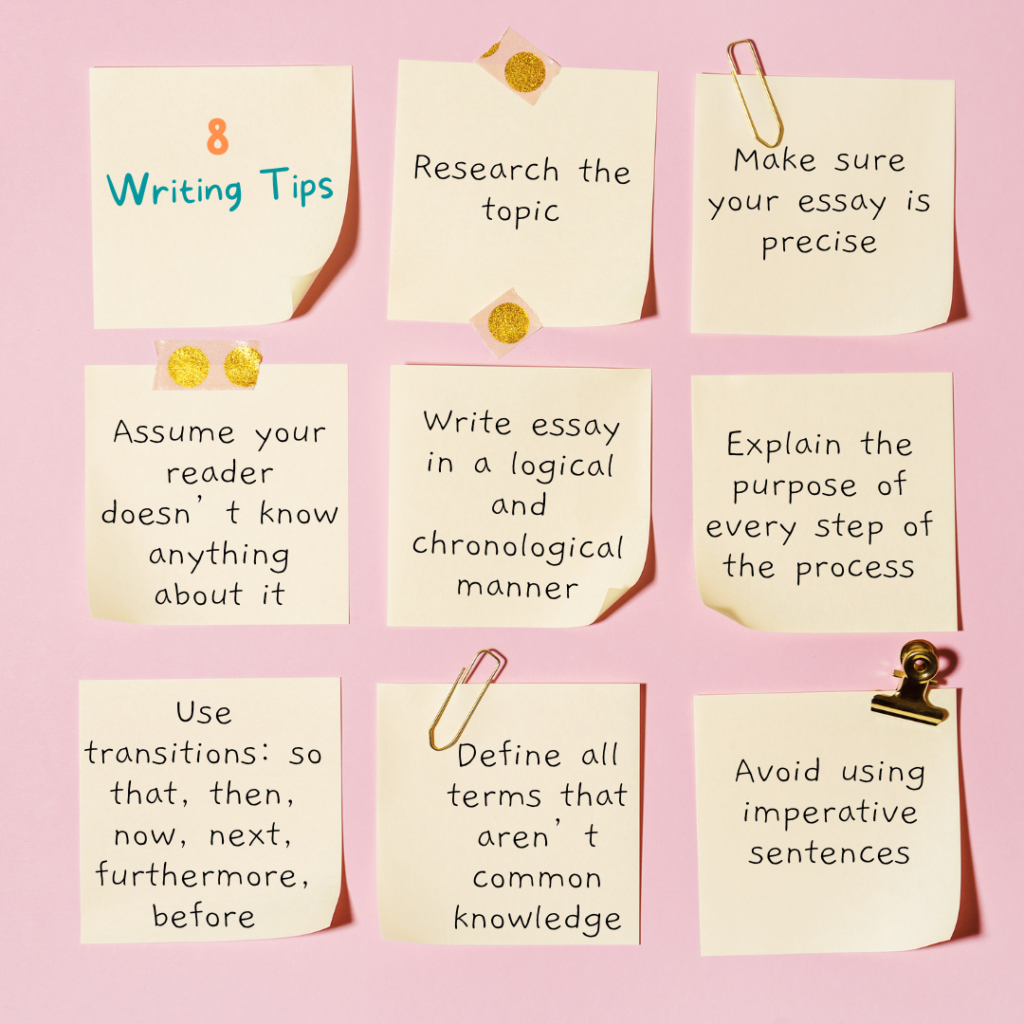
While writing the process essay you can imagine like you’re working on a manual (regardless of the topic). The goal of that manual is to explain how some process works for a person who isn’t informed about it. Here are some tips that will help you:
- Before you start writing, research the topic thoroughly and take notes
- Make sure your essay is precise and coherent, but still features details that enhance its quality
- Assume your reader doesn’t know anything about it, otherwise, you’d skip important details because you think others know it already
- Write the essay in a logical and chronological manner, as one step leads to another
- Explain the purpose of every step of the process, the reader wants to know WHY it happens
- Use transitions such as: so that, then, now, next, furthermore, before
- Define all terms that aren’t common knowledge
- Avoid using imperative sentences because your essay would resemble an instruction manual rather than a proper essay
- An easy way to make a great first impression every time
- Becoming a registered nurse
- Breaking from bad habits
- Car manufacture process
- Changing major at college
- How and why to change Facebook privacy settings
- How to become a real estate agent
- How to conduct a census
- How to finish all school assignments and still have time to for fun
- How to get an A without losing your mind
- How to look like a fashionista every day
- How to lose weight in a healthy manner
- How to overcome insomnia
- How to prepare for emergency disasters
- How to quit smoking
- How to take an amazing selfie
- How to train your husky
- Introduction to Bitcoin and how to get started
- Risk management process
- Simple strategy to get over your ex
- Simple tips to play Minecraft
- The budgeting process
- Tips to master League of Legends
- Writing a book review
The process of writing a process essay involves extensive research that is designed to provide the reader with a comprehensive understanding of the topic. Therefore, it is important to find a reliable and experienced writer who can write an assignment in a relevant way and add new information to the text.
Most students are used to writing argumentative, persuasive, and other types of papers and process essays may make you nervous, especially if you’ve never had this assignment before. First of all, it’s natural to be nervous. It shows you care! There’s a lot you can do to feel better and complete this assignment successfully. You just need the right tools such as:
Essay Topic Generator
You have the freedom to choose your own process essay topic? That’s fantastic! You can write about anything you’d like, but to come up with your topic quickly, you can use Edusson Magic Essay Topic Generator. The platform comes with thousands of essay topics that are going to inspire you, for sure. Just visit the website, enter a keyword or search for topics based on category or alphabet.
Essay Examples
The secret to a high-quality essay and good grade is consistency and practice. The practice doesn’t just involve writing process essays to sharpen your skills, but reading someone else’s paper at the same time. Why? This helps you identify the strengths and weaknesses of some essays in order to create your paper effectively. You get to avoid common mistakes and focus only on those parts that matter. Edusson Essay Examples is an amazing source of essay examples. It’s impossible not to learn or feel inspired when you have hundreds of essays to read. Essay Topic Generator Look for topic View more
Essay Checker
After you finished writing the essay, you need to edit and proofread it. Some students prefer doing everything on their own, but the problem is that many mistakes are overlooked. Now it doesn’t have to be like that. Essay checker called Robot Don enables you to analyze and submit 100% error-free paper. Robot Don evaluates plagiarism, sentence structure, readability, word choice, the frequency of words used, and other aspects of your process essay.
Essay Writing Service
Edusson essay writing service is ideal for students who want to have a custom-made essay sample and for those who don’t have enough time to write it on their own. An amazing team of skilled, experienced, and talented native English speakers is here to help you out. All you need to do is to make your order and choose the writer. Edusson is fully transparent and all essays are written from scratch.
Essay Editing Service
Essay editing service at Edusson is ideal for students who wrote the process essay (or some other paper) and just need help with the editing and proofreading process. Edusson gathered a team of talented editors and proofreaders who make sure your essay has no typos and grammar mistakes while improving style, formatting, and organization, among other things.
Related posts:
- How to Write an Abstract for a Research Paper
- How to Write a Cause and Effect Essay
- How to Format Essay. Example MLA, APA Essay Format
- Best 25 Travel Blogs for Students 2023
Improve your writing with our guides

Writing a Great Research Summary and where to Get Help on it

How to Write a Synthesis Essay

How to Write Essay or Motivation Letter for Internship
Get 15% off your first order with edusson.
Connect with a professional writer within minutes by placing your first order. No matter the subject, difficulty, academic level or document type, our writers have the skills to complete it.
100% privacy. No spam ever.

- Custom Essay Writing
- College Paper Writing
- Do My Assignment
- Essay Editing
- Our writers
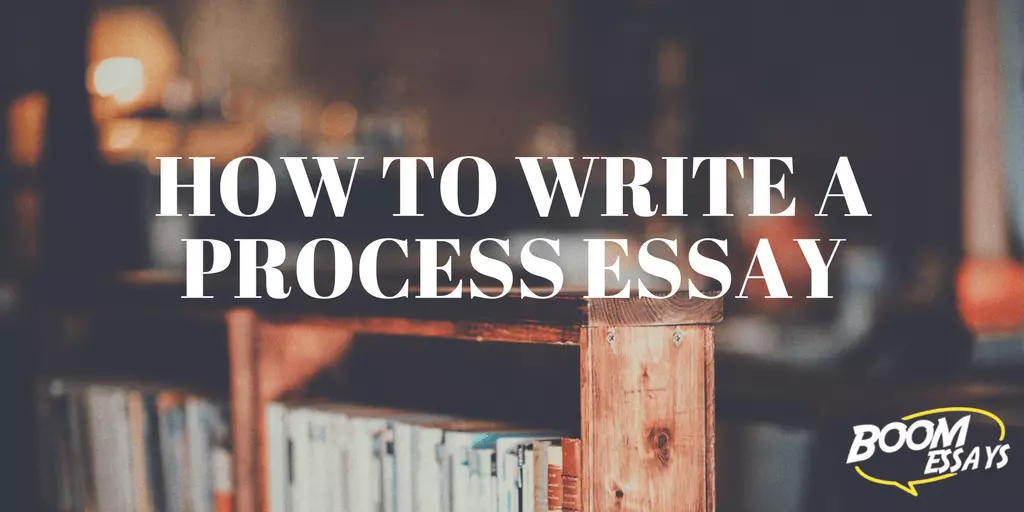
Posted: 06 June, 2017
Process Essay: How-To, Structure, Examples, Topics
Process essays aren't as common as other essay types at university, but they are still assigned. If you've been assigned to write one, this guide will have everything you need to get started.
Table Of Contents
What is Process Essay?
Process essay structure, how to write process essay, process essay topics, process essay examples.
A process essay can be one of two things. It can be an essay that explains how to do something, or it can be an essay that explains how something works. It'll be more common if you study a subject that follows linear protocols, such as the sciences.
The essay structure for a process essay is one of the simplest ones around. The goal of the essay is to explain the process itself, so you'll break it down into different steps. Your essay should look like this:
- Introduction: Introduce the process you're going to explain, and talk about why it's important to the reader.
- Main body: Each section in this part will take on a different topic, or step in the process. Remember to include all the steps that are needed.
- Conclusion: You'll wrap up your explanation, but won't include anything new at this stage.
To write your essay, here's every step you'll need to take.
- First, research the process you're going to be explaining. Make sure you have all the information to hand. These kinds of essays aren't as reliant on evidence, but you still will need some to prove your points.
- Now, you'll need to write your outline. Use the structure above for guidance. This outline will ensure that you miss nothing out of your explanation.
- Once you have your outline, sit down to write. The outline will give you the guidance you need, making the writing process easier. Remember to leave lots of time to write my essay for me request, or you could rush it and make mistakes.
- Finally, proofread and edit your essay. This will ensure that no mistakes were made and that it's ready to hand in.
The topics you could be given in this genre of essay writing can vary wildly. You could be asked to write about how to draw a cow, or set up an email account. Whatever topic you're given, you'll be expected to write a full and thorough account of how to undertake that activity. Remember, you need to write so someone else could follow your steps and get the right result.
If you want some practice at writing your own process essays, here are some example topics:
- How to train your dog to sit.
- How to send a text message.
- How to start a small business online.
- How to change the oil in your car.
If you don't know how to do any of these things, you'll need to research first. Make sure you don't miss out any important steps!
Now you know how to write the perfect process essay. Use this guide when you next need to get one written.

- Customer Reviews
- Extended Essays
- IB Internal Assessment
- Theory of Knowledge
- Literature Review
- Dissertations
- Essay Writing
- Research Writing
- Assignment Help
- Capstone Projects
- College Application
- Online Class
How to Write a Process Essay: A Complete, Step-by-Step Guide
by Antony W
February 16, 2023
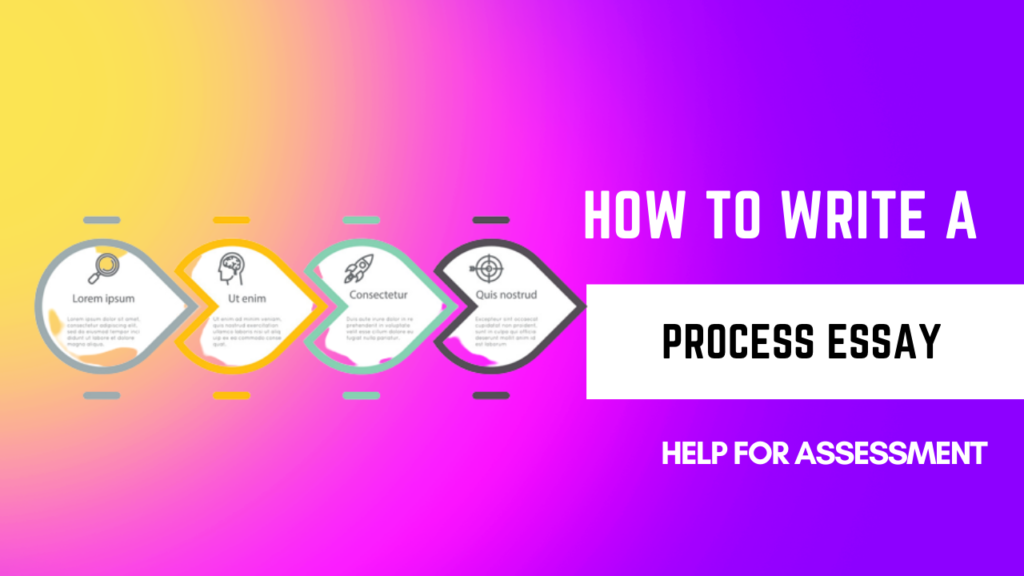
A process essay, also known as “how-to-essay”, is a common type of paper that informs the reader how something is done. Being able to write a process essay is about talking the reader through a set of instructions or step-by-step guide on how to do something such as performing an experiment, preparing a meal, or carrying out a specific process.
Writing a process essay should involve enough details to lead the reader successfully to the desired goal.
You need to follow the step-by-step process until the reader has achieved what you’re leading them to do.
Any missteps or poor explanations at any point can cause bad mistakes or even ruin the entire project, so process essays need to be highly detailed and instructional.
This guide will show you how to write a brilliant and effective process essay and be sure of that A-grade.
Pre-Writing: Planning Your Process Essay
The first requirement if want to write a good process essay is preparation.
Preparing the small stuff goes a long way in ensuring you deliver the best of the report.
Some of the things to look into for an essay that meets expectations include;
Understand the Target Audience
Before you start writing, you have to understand your target audience and their expectations from the essay.
The target audience determines the language to use and the general complexity of the essay.
Ask yourself about the education level of the audience on the topic. Understand if you have to explain basics for them to understand.
I t’s also essential that you the language and terminologies best suited to the audience.
Create a List of Materials Needed
Anything that involves creating something new will require materials.
The same applies to writing a process essay which details how a thing is done. Before you start writing, create a list of all the materials and tools the reader will need for the whole process.
Place each item either in the order of use or importance. The more impactful or useful a tool is, the earlier it comes on the list.
Create an Outline
Once you have understood your audience and listed the needed tools, it’s time to note what you want to include in the content.
It is easy to forget important things that you need to include in your essay, but an outline creates a structure that you can flesh out with details.
Note down every step, detail the important all the important steps, and try to make your ideas flow clearly .
You don’t have to go into a detailed explanation at this point. Just have the steps down with the important tools.
Structure of a Process Essay
Introduction.
The introduction is where you get to draw in the reader and get them interested in the essay.
You can talk to them about why the particular process they are about to undertake is important without jumping ahead of yourself.
You can also mention briefly what the essay will cover, thus creating anticipation for what is to come.
Another tactic is to d raw the reader’s interest by giving some historical background of whatever you are working on. It also helps to refer to the timeframe so that they prepare well in advance.
Body Paragraphs
The body paragraphs are where you introduce the step-by-step guide to your the readers.
Let the readers understand why they each step in the process is important and why they need to take it instead of alternative methods.
The length of the paragraphs depends on the complexity of the whole process. Every section should have enough details such that the reader would complete the process properly.
Be sure to mention what equipment and tools will be necessary for the procedure. Also, let the reader know of possible troubles and other difficulties to expect during the process.
Ensure the smooth flow of everything by using transitions. The transitions make the Essay easy to read and follow. Use terms like then, so that, next, now, and others.
Your process essay's conclusion is where you can go through the expected results of the process.
It summarizes everything about the guide and provides the reader with a reinforcement of the procedure’s significance.
Explain to the readers the result.
State what it looks like and what follows, whether there are other processes or its final. Ensure your read is accomplished by the end of the essay.
Process Essay Writing Tips
There is more to writing a process essay than identifying the audience and using the right format.
1. Focus on Simplicity
As a guide on doing something, most probably for the first time, a process essay should be easy to follow and understand.
Use simple language with clear directions on how to perform all the processes.
The choice of words and the construction of sentences must meet the reader’s understanding.
2. Choose the Right Topic.
Your choice of topic is crucial when it comes to process writing.
Choosing a technical topic might not resonate with the audience, as you can also have little to write about.
Common issues are also hard to write about as you never seem to be helpful. Look for the readers’ probable needs and solve them.
3. Proofread the Essay
Once you are done writing, revisit the whole of your work to ensure everything is in place. Revise the work with the reader in mind.
Ensure the language resonates with the target audience. Pass the work through checkers for plagiarism-free work .
Ensure your work is well detailed with all the necessary guidelines. Include all the steps while you eliminate anything unnecessary.
Only hand in your work once you have achieved a desirable result.
4. Seek Help For Your Process Essay Assignment
No matter how much you have mastered the art of writing a process essay, you can never be all-knowing.
Do not shy from seeking help from a friend or professional to help you through the writing and proofreading.
Working with a professional team like Help for Assessment helps in creating high-quality work for assured high grades. Our essay writing experts are experienced in delivering top-notch papers on various topics.
Related Reading
- This Guide Will Help You to Write an Opinion Essay
About the author
Antony W is a professional writer and coach at Help for Assessment. He spends countless hours every day researching and writing great content filled with expert advice on how to write engaging essays, research papers, and assignments.
Verify originality of an essay
Get ideas for your paper
Cite sources with ease
How to Write a Process Essay: Excellent Guide with 10+ Examples
Updated 20 Aug 2024

Process essay explains how to do something. This is a kind of tutorial that describes a process step by step.
For example , you need to cook a pie or draw a picture. In this case, you will need to follow step-by-step instructions. Each preceding step influences each subsequent one.
As we have vast experience in writing this type of papers, we would like to share several tips with you so you don't have to wonder who can help to write my essay for me . It’s important to make a good paper to understand the details of this procedure better. Let's follow the tips from professionals at our trustworthy essay writing service and get to know how to write a process essay with us!
What is a Process Essay?
In order to understand how to write it, firstly you need to learn what it is. Therefore, let’s start with the definition. This paper explains the process of making something. The numerical order is used when writing a process essay. This type is written in a descriptive manner. It has qualities of technical documents. Words, such as “later”, “next”, “finally”, “eventually” are often used to describe the process.
The following features characterize a process paper:
- The chronological order of described events
- Description of repeated steps to follow
- Fixed order
- Clarity of narration
- The presence of transition words.
Process Essay Outline
The structure of this paper is similar to any other assignment, meaning that it comprises of introduction, main paragraphs and conclusion. You need to create an outline to ease the procedure of writing process essay. Use bullet points not to forget the essential ideas you would like to deliver.
In your process analysis essays , it is important to create a detailed outline that includes all the essential steps and descriptions.
For instance , if you’re creating a process essay about making excellent sushi, in your outline you may state the following: “Add fish”. Further, you could add the following description: “Add salmon, shrimps or eel”. The more details you add to it, the better.
Need more writing assistance?
Connect with our top writers and receive a paper sample crafted to your needs.
Introduction of Process Essay
So, how to write a process essay? The introduction is the first part of the text exposed to readers. Therefore, it should grab their attention from the first lines. A colorful description can help to fulfill this task. This method is inherent to creative essays also, so if you've written this type before, it'll be a big plus for you.
For example , if you are describing a receipt of sushi, you may wish to start with the following words: “Japanese sushi is a well-known dish which is loved all over the world for many years.” By keeping a lively and vibrant language, you can stimulate people to continue reading.
Further, you need to let readers know how much time they should to cook sushi because we are living in a world where every single minute is precious. They will be thankful to you if you help save their time. It is essential to provide people who read with the exact time estimate from the beginning to the end. Let them know the materials or tools that help reduce the amount of time spent on cooking sushi. You may share advice related to preparations and making a list of all ingredients to shorten the cooking time.
For example , you may write in your process paper: “Making sushi takes 30 minutes of preparation time and 10 minutes of cooking.”
The next action is to write a thesis statement. It is one sentence that describes the research problem to be considered in the paper. It can be the last sentence of the introduction.
For example , a great thesis may sound like: “This assignment explores how to create sushi at home quickly by preparing necessary ingredients in advance.”
Get plagiarism-free papers in just 3 hours
- Zero AI - 100% human-crafted content
- Tailored to your writing style
- Sourced from the latest, reliable sources
Guaranteed Turnitin success ✌️

Body Paragraphs of Process Essay
Before starting to compose the main part of your process essay, consult your outline. Follow your outline closely and create appropriate headlines to divide your paper into smaller pieces. Pay attention to clarity and order of paragraphs. Be careful with items that contain many steps. Use different words to maintain flow. Make clear transitions and acknowledge previous steps regarding particular items.
The process essay outline may look as follows :
- Make a list of ingredients
- Cook rice
- Prepare fish and cheese
- Prepare ginger
- Prepare soy sauce
- Prepare tools to make sushi (sushi rug)
- Make this sushi
- Serve sushi
As a rule, this paper has three or more paragraphs in the body section. You need to use enough details when writing a process essay, but don’t overload it with unnecessary details not to confuse your readers. Your paper must be clear and coherent to deliver core ideas without excessive details.
By adding transition words, you can encourage people to read. You should use the words “then”, “next” and “now” to add coherence. Use of these words gives you an opportunity to make your paper more cohesive.
For example , if you don't know how to start a phrase in process essay, use “next” to switch from one step to another: “Next, prepare your fish.”
Further, using first-person pronouns like “I”, “me”, “mine”, “we”, “us” or “ours” is not a good idea. It would be better to narrate from the second or third person (“it”, “they”) to make your readers trust your instructions more. For instance, it is better to write as follows: “This paper describes...” rather than “I shall describe”.
You should mention any cautionary notes if any to warn your readers about actions they should skip. You can discuss these actions either in the main text or in the conclusion part of your essay. This is important if your task can cause harm.
For example , caution a reader if the food may be spoiled: “Make sure salmon is of good quality because raw fish is used in sushi”.
You should also mention when writing process essay what people need to do with the final product. By describing what this product looks like you will give the idea of what readers should expect from it. You may also specify how to use the product because potential users do not necessarily know how to do it.
If you’re explaining how to make tasty sushi, you could write the following: “Now you need to serve the table to eat sushi. Propose plates of sushi, soya sauce, and ginger to your friends or family members.”
The Conclusion of Process Essay
In conclusion, you can restate the importance of the topic discussed. Try to end your paper positively Remind people why they spent a lot of time to complete this task. Praise your readers and encourage them to follow your directions.
An example of a proper conclusion can be: “We finished! A delicious and quick meal that is good for the whole family is ready to be served now. Next time, do experiments with different filling for sushi.” In this way, you will encourage your readers to track your upcoming publications.
Final Steps
After finishing, you need to edit and proofread the text:
- First, read your text and evaluate whether it is easy to understand. It is better to read it aloud because you can hear stylistic and grammar mistakes.
- Picture each detail of your text in mind, check all phrases for coherence and feel confident that your descriptions match images. Also, ensure all paragraphs are placed in the right order.
- Do not rely on online spell-checkers too much when checking mistakes and typos because they don’t take into account the context of your assignment.
- Check if your instructions are clear and detailed enough so readers can understand them.
- Give your text to a friend for reading and ask him if he understood instructions. If possible, choose someone from your target audience.
How to Write a Process Essay: Composing Tips
The procedure of creating this paper reminds of creating a manual. Its objective is to explain the process of doing something in details to someone who had never done this before. These tips will help you while writing:
- Choosing topics for process essay – 50% of the success of your future paper depends on the choice of topic.
- Gather as much information as possible about the issue of your research, study your subject well.
- Research your topic thoroughly before starting to write and take notes.
- Make a coherent essay featuring precise and relevant comments to enhance its quality.
- Assume that your readers are not aware of the topic under discussion and explain all details of the procedure.
- Observe flow and maintain logical order when you want to tell about the next step.
- It’s crucial to explain each step of the action you’re describing because everyone needs to know the reasons behind each action.
- Use specific words when switching to another activity (furthermore, then, before, that, etc.)
- If you use terms that don’t belong to common knowledge, you need to explain their meaning.
- Using imperative sentences is not a cool idea because in this case, your work will remind a manual rather than an essay.
When you finished this paper, check phrases for consistency and run your paper through an online plagiarism checker .
Advantages of Writing Process Essays
Each type helps develop certain skills. For example, a comparison paper helps improve different skills and find similarities and differences between two events or actions. Process essay helps expand the following abilities:
Analytical – when composing a process paper, you need to switch logically and represent events in order. Aiming to write this essay, you need to be able to think analytically. Also, you need to keep the interest of everyone and describe the action in dynamics. One of the benefits is that you can transfer these analytical skills into other areas of your life. For example, you can use your skills at work when performing complicated tasks.
Information prioritization – when you are writing a paper, use precise phrases because vague expressions reduce the paper quality. On the stage of research you have to analyze a great number of resources and choose several of them that add value to your work. You need to include only valuable information and exclude unnecessary information.
Complying with instructions – when you’re trying to do something in compliance with guidelines, you’re learning to follow the procedure of smooth transition to another step. Gradually you learn how to reach a goal. This skill can be used in each aspect of your life as well.
Keeping an eye for details – details are very important when you're writing a process essay. Just try to scrutinize each word and phrase to present value for your readers. This is particularly important when you need to complete this paper because your readers will follow you little by little. Attention to details is essential in any workplace.
Don't risk a zero grade!
Hire our experts to proofread, polish, and check your work for accuracy. Just $7/page. Zero AI.
Conclusion of the Article
We hope that our article was useful for you and you can start right now. If you think you’re not creative enough to start independently or maybe you don’t have enough experience, you can always apply for our service to buy nothing day essay examples or just order the best process essay using our writing agency.
In our agency, we provide reliable service at a reasonable price, so you can easily pay for essays online . Our support team is available 24/7, and our professional writers are capable of writing high-quality essays online on time. Each of them is the author of a big number of academic papers. Besides, we offer a money-back guarantee if you’re not satisfied with the quality of the final work. Also, a review of your article review paper is available if you have any suggestions regarding the improvement of the work. Therefore, don’t hesitate to apply for professional article review writing service help and save your time. Use our agency to get better results and be your school's best students!
Was this helpful?
Thanks for your feedback.

Written by Jamie Wallace
Jamie Wallace, editor and freelance writer, specializes in Philosophy, Literature, and Art. His interdisciplinary background and passion for critical analysis enable him to assist students in crafting compelling and well-researched papers.
Related Blog Posts
100 fantastic process essay topics for students.
Writing different essays on different topics requires different processes. While it is a simple concept, it is not always so easy to know how to ge...
How to Write Winning Scholarship Essays: Prompts, Tips, and Strategies
What is a scholarship essay? Before we explore what to write in a scholarship essay, let’s specify the definition of this term. It is a written ...
How to Introduce Evidence in an Essay: Steps & Tips
Using evidence effectively in an essay is crucial for building a strong, compelling argument. If you create research, persuasive, or analytical wri...
Join our 150K of happy users
- Get original papers written according to your instructions
- Save time for what matters most
Process Essay
Definition of process essay, transition in a process essay, examples of process essay in literature, example #1: community re-discovered (by heidi ramirez).
“In any community , there are several and varying ways in which residents fulfill a sense of community: participating in intramural sports, attending farmers’ markets, walking with neighbors, attending political meetings, helping the elderly, visiting the library, and volunteering for youth groups. It’s knowing the people in these interchanges, not just being familiar with faces, that build strong community. Unfortunately, when this basic engagement is overlooked, communities can begin to disintegrate.”
Example #2: A Homemade Education (by Malcolm X)
“I was so fascinated that I went on—I copied the dictionary’s next page. And the same experience came when I studied that. With every succeeding page, I also learned of people and places and events from history. Actually, the dictionary is like a miniature encyclopedia. Finally the dictionary’s A section had filled a whole tablet—and I went on into the B’s. That was the way I started copying what eventually became the entire dictionary. It went a lot faster after so much practice helped me to pick up handwriting speed. Between what I wrote in my tablet, and writing letters, during the rest of my time in prison I would guess I wrote a million words.”
Example #3: Perspectives on “Borders” (by Luis Valdez)
“Let’s go back to the Popol Vuh. We’re talking about borders now . There is a border that defines the human being as a material and spiritual being. We have all learned that we’re Homo sapiens, wise monkeys. The monkey is a symbol of intelligence in the Popol Vuh, and in the classic Chinese novel Monkey. The wise monkey is a symbol for humanity. Now let me offer you another symbol for our human being—the feathered serpent. You are a feathered serpent that is evolving and crawling out of the seeds of your being. And once in awhile you get caught up in the dead skins of your life. You know biologically we go through a complete cellular change every seven to nine years. We’re totally renewed. So in one sense, biologically, you crawl out of a dead skin. You evolve out of yourself. The feathers are necessary because they represent our spiritual being.”
Function of a Process Essay
Related posts:, post navigation.
- Translators
- Graphic Designers
Please enter the email address you used for your account. Your sign in information will be sent to your email address after it has been verified.
How to Write the Perfect Process Analysis Essay (With a Sample Essay)

A process analysis essay is a kind of expository essay that explains the process or actions someone needs to take to complete a task. You can think of it like a recipe, stating all of the necessary ingredients and steps, allowing the reader to follow along in logical order.
A process analysis essay can be written about a wide scope of topics, from highly technical processes to cleaning and organizing your closet. Writing a process analysis essay forces you to slow down and consider every tool and step involved in completing a task, and then explain what's needed in logical order for your reader to do the same.
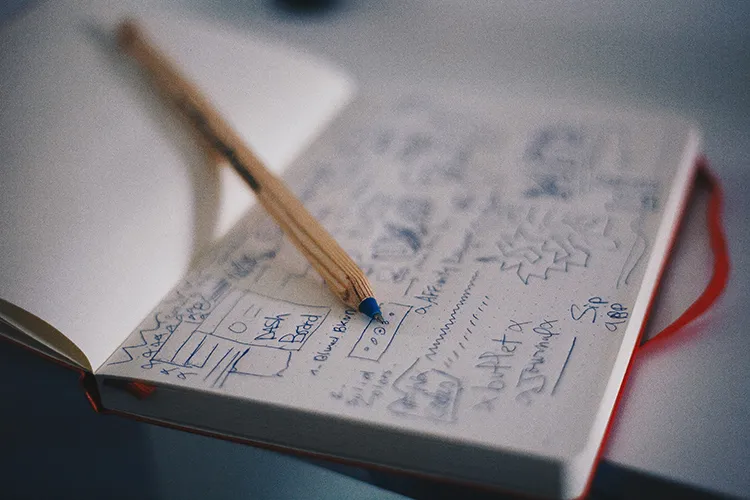
Format of a process analysis essay
For this type of essay assignment, you will not be following the traditional five-paragraph essay outline. There is still an introduction and body to your essay, but your conclusion is more like the "analysis" part and the essay will end when you've completed explaining the steps involved in a process. Below, we'll break down exactly what should be included in each of these parts. Also keep in mind that you can still create an outline before beginning writing your process analysis essay, although it might look more like a list of bullet points rather than a traditional five-paragraph essay outline.
Introduction
The introduction to your process analysis essay will include information about the process you are analyzing and why it is important. This will likely be the shortest part of your essay. If there is a unique history to the process you'll be analyzing, the introduction is where you might mention that. You basically want to use this paragraph as a brief introduction to your reader of 1) what process you'll be analyzing and 2) how or why that process might be useful information to know.
The body of your process analysis essay will mention any prerequisites, materials, or instruments needed to complete the process. It should also mention any risks or warnings involved that are relevant to the process. It's important to include everything that the reader will need to complete the process, and even extra tools that might help the process go smoother but are not necessary. For example, in the sample process analysis essay provided below on how to make apple butter, I included a spoon to stir the butter as part of the list of tools that will be needed. Additionally, I mentioned that a food processor will make the apple butter cook better and have a more butter-like consistency, but it's not necessary to have as a tool to cook apple butter.
Following these sections, you'll write the actual process in sequential order required to complete the task. Make sure you include transitional words within and between paragraphs, as these are required to show the sequence of the process in logical order. Your analysis will likely be across several paragraphs, so make sure each paragraph describes a separate part of the process to avoid confusion for your reader.
Sample process analysis essay
To show you how a process analysis essay might look, we've provided a sample essay that includes the separate sections discussed above. Notice that the introduction paragraph is short, providing basic information about the process that will be discussed, while the remaining paragraphs are longer and more detailed.

Sample essay
Apple butter is similar to apple sauce but is different in that it is highly concentrated and used more often as a butter-like topping on bread or crackers. It's cooked long and slow, allowing the sugar in the apples to caramelize and turn it a deep brown color.
To make apple butter, you will need a slow cooker, food processor, cutting board, peeling knife, large spoon, apples, sugar, and spices for the desired flavoring (usually cinnamon and nutmeg). You might also want to use an apple slicer, which cuts down on the preparation time. Note that when you begin cooking your apple butter, the more minced the peeled apples are, the smoother the final product will be. If you want your apple butter to have a true butter-like consistency, mince the apples well in the food processor before cooking.
Now, let's look at the process of cooking apple butter. To begin, prepare a large, clean space for cutting and processing the apples. Five to six cups of fresh apples will likely only result in a few cups (at most) of apple butter, so depending on how much butter you want to make, you could be peeling and preparing apples for several hours. Each apple will need to be sliced, peeled, and minced in a food processor for maximum butter-like consistency.
Next, add the minced apples to a slow cooker and place the slow cooker on "high". You will notice that the top of the mixture is watery, once the larger pieces settle. Add sugar and spices until you reach the taste you want for the apple butter. Keep in mind that apples vary in sweetness, depending on what type of apple you are using, and sugar can be added slowly throughout the cooking process. Be careful not to add too much sugar at first, as the butter will get sweeter as the apples cook down. In fact, you might even choose to not at sugar at all at this stage of the cooking process, especially if you want a final product that is not too sweet. The spices can also be added as the apple butter cooks or not at all (if that's your preference). Be sure to stir every 10-15 minutes during the first hour as the apple butter is cooking on high and let it cook uncovered.
After one hour of cooking on high, turn the slow cooker to low and cover it. Depending on the type of apple you have used, it should cook for 8-10 hours, until there is no water left at the top and around the sides of the slow cooker. During this slow cooking time, stir occasionally (once per hour should be fine). This is also when the apple butter makes your kitchen smell amazing!
Finally, when the apple butter has reached the consistency and taste you want, remove it from the slow cooker. If you choose to can the apple butter, you can do that immediately or keep the apple butter in the refrigerator until you are able to can it.

Process Essay
Process essay generator.
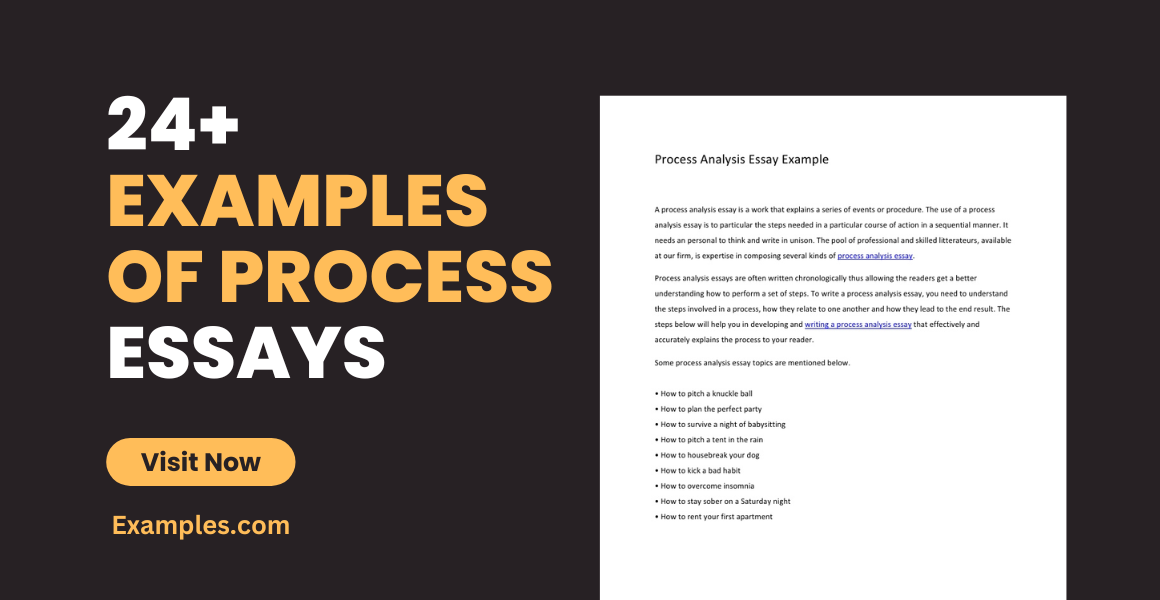
Do you know all those YouTube do-it-yourself (DIY) tutorials that they post online? When you consider posting that other than a process essay, it usually attracts more viewers and generates more subscribers on your YouTube channel as people these days are considered more visual in terms of learning new skills or facts. But process essays are just more than how-to videos or DIY videos, an accurate description of a process essay is that it simply describes a procedure. You may also see a short essay .
- 22+ examples of free essays .
- 10+ Essay Writing Examples
This kind of essay provides a step-by-step explanation of a process that leads to an expected or planned outcome. What people do not know that the aforementioned process may either be concrete or abstract. Simply put, there are two types of process essays: directional process essays (give instructions in steps on how to accomplish a specific task), and informational process essays (explains or analyzes a process). You may also see self-introduction essay
Student Process Essay Example
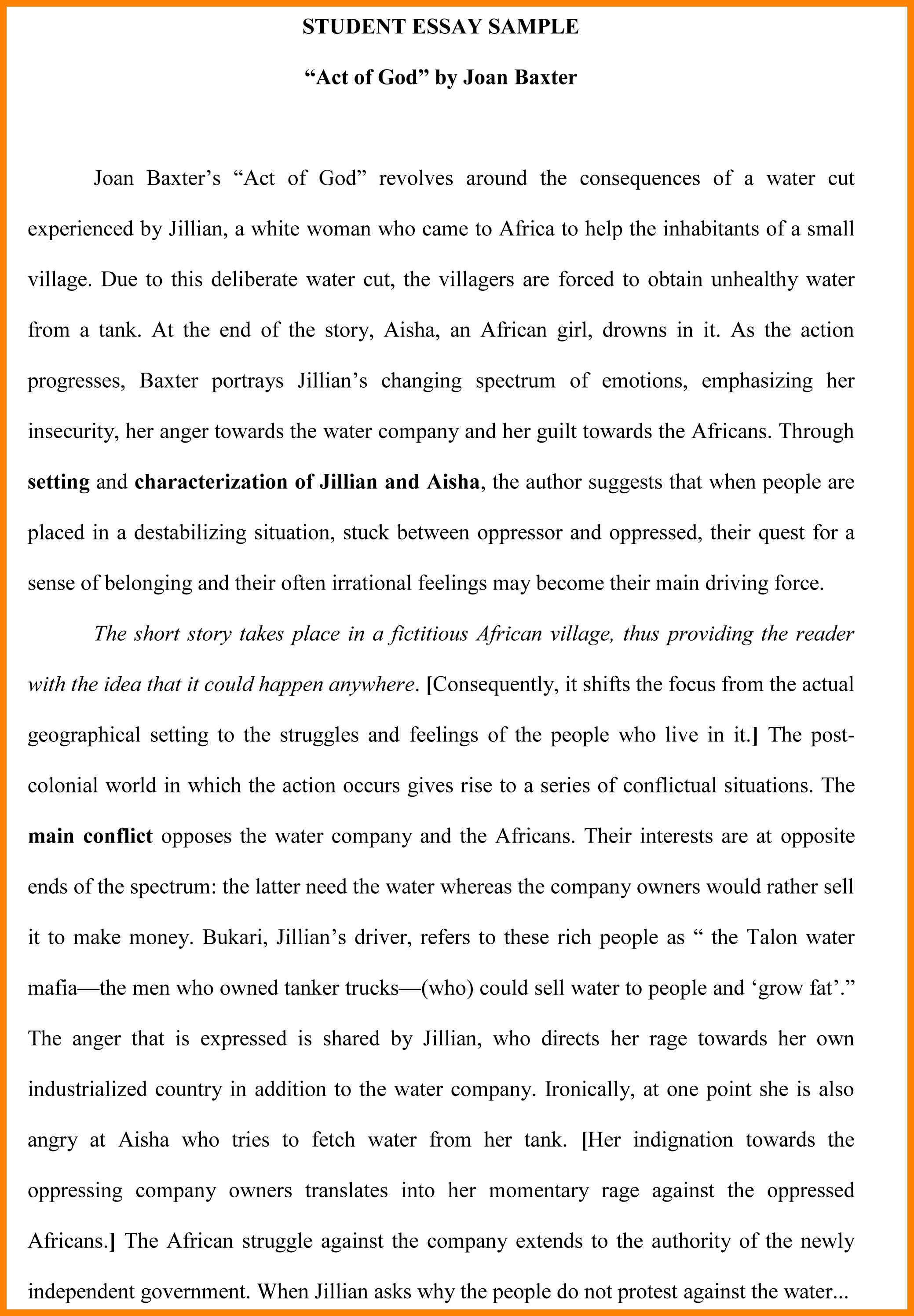
Size: 615 KB
Process Analysis Essay Example
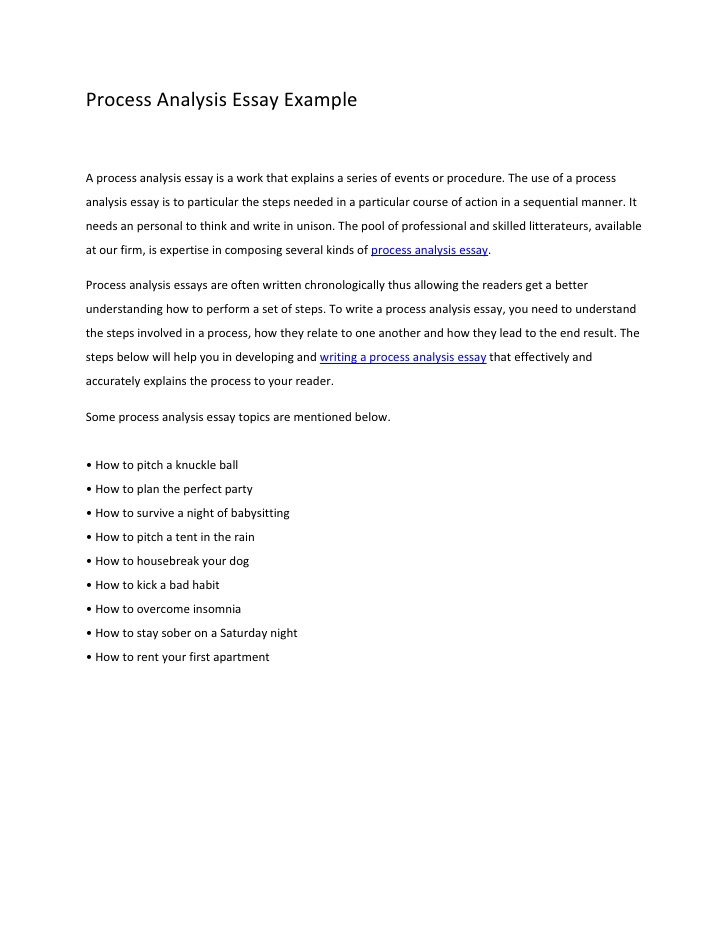
Size: 66 KB
Plain Process Essay Example
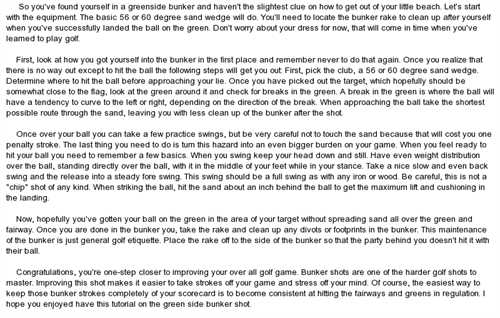
http://degregoristore.com/
Size: 53 KB
Preparation in Writing a Process Essay
1. assess your audience’s skill level.
Before you begin, you need to first take your audience’s skill level into consideration. In a lot of DIY videos and how-to videos that you see in numerous TV shows, you can see that the hosts will often make use of very simple language so that the people who decide to subscribe on their YouTube channels and watch those DIY videos will be able to understand them very easily. Another thing that you should assume is that everyone who decides to check out your videos or read your process essay has little to no knowledge of the said topic, depending on the content you decide to release or publish. Before you even begin to write your essay, you have to understand the parts that comprise an essay .
For example, a process essay intended for professional chefs could probably skip a description of how to chop carrots and just say, “Finely chop the carrots,” instead.
2. Make a list of the materials needed
If you already have an idea on what kind of process you are going to release or publish, the next thing to do would most probably be to draft a list of the materials or ingredients that your audience or viewers might need so that they can follow along. It may be easier to do so in your own DIY or “How To” videos, as it is more visual and that the viewers could clearly see as to what these products look like should they get confused, but for process essays, it is a bit tricky. One tip that you could follow would be to include a comprehensive “Things You’ll Need” section at the beginning of the paper or simply list the materials needed after the introduction so that the readers of your essay will prepare the materials needed beforehand to save precious time. There are moments in your life that you will be asked to draft up self-introduction essays as part of a class assignment.
There are times that an item on the list would seem very unusual for a person to procure. Should that be the case, such as a particular type of hand tool, be sure to clearly introduce it within the text. For instance, “The pin hammer has a finer tip than a standard hammer, making it suitable for more detailed work.” If at all possible, make sure to include a picture of the said object you are planning to use if you intend to publish the said essay online. You may also see a formal essay .
3. Create an outline of the task
In order to make things simpler for you on your end, it would be best if you created an outline that can help you create the flow of the process essay that you are working on. Keep in mind that the outline simply acts as the guide for the essay and is not the essay itself. Outlines are normally made with bullet points and at least 1 to 2 sentences per point. Creating an outline will be most helpful to especially informational process essays. Keep in mind that the more specific your article or essay topic, the more specific your details need to be. Here are some examples of how different people would write their essays .
- If your essay happens to be about cooking lasagna, you may want to begin your initial outline by saying, “Mix in basil.” Before you start writing, you could expand your outline to say, “Briefly mention taste differences between dried and fresh basil.”
- When writing an informational process essay outline about how journalists write a news report, you can include some details about journalists select a news story and the criteria they would use to determine a story’s newsworthiness.
Simple Process Essay Example
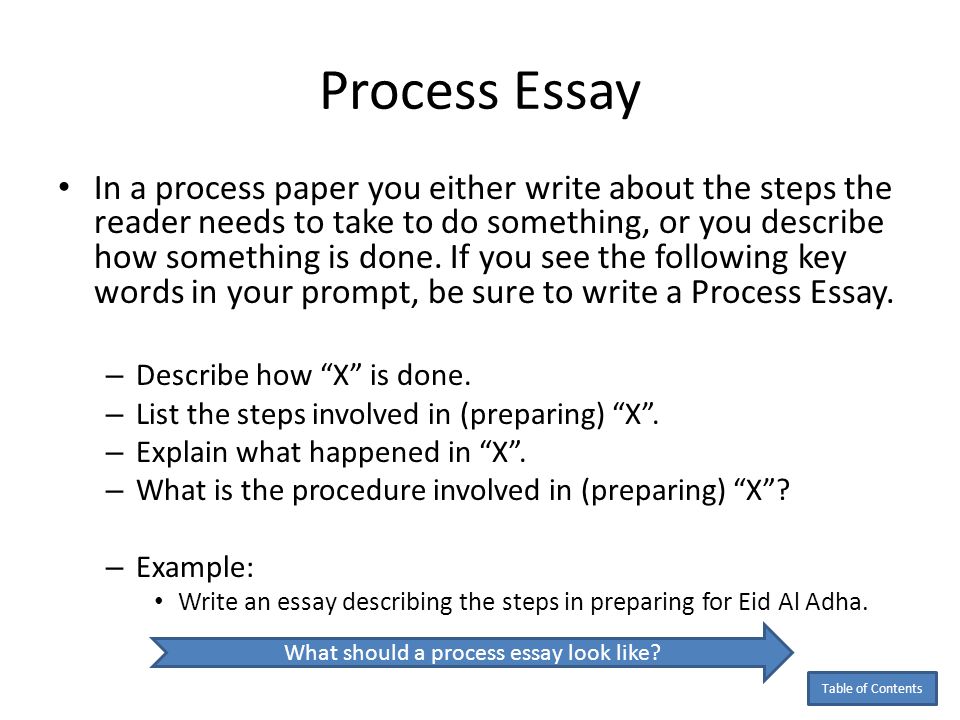
Size: 96 KB
Process Essay Example from Kool-Aid
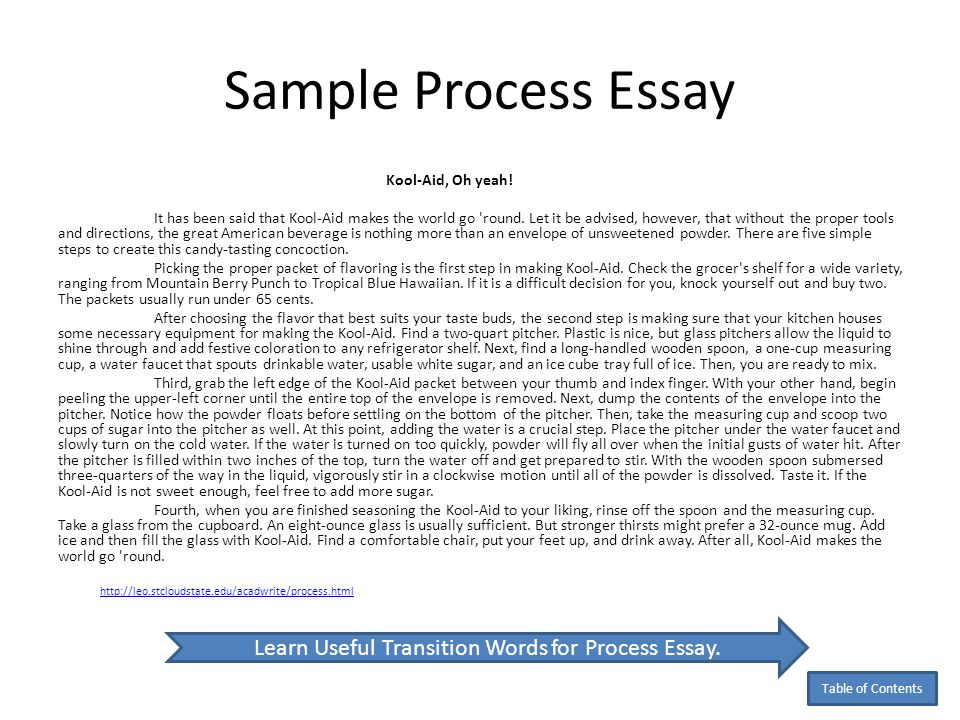
Size: 159 KB
Scanned Written Process Essay Example

Size: 76 KB
Golf Process Essay Example
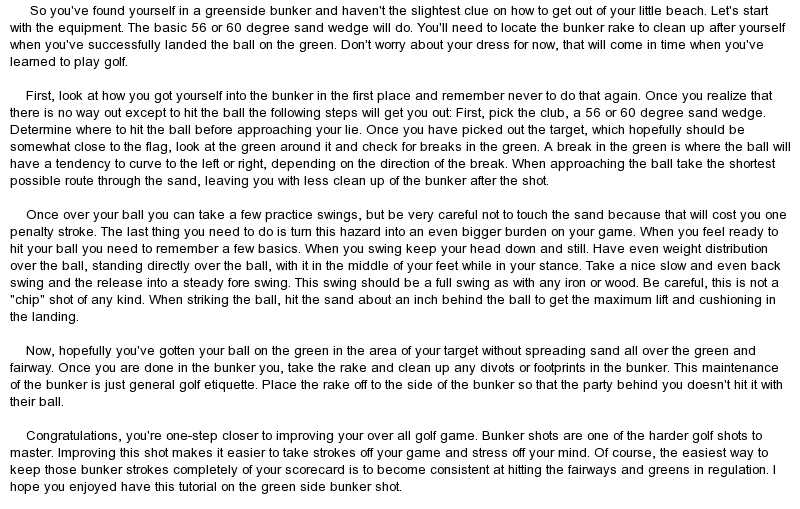
Size: 138 KB

Process Essay Example in Making Popcorn Balls
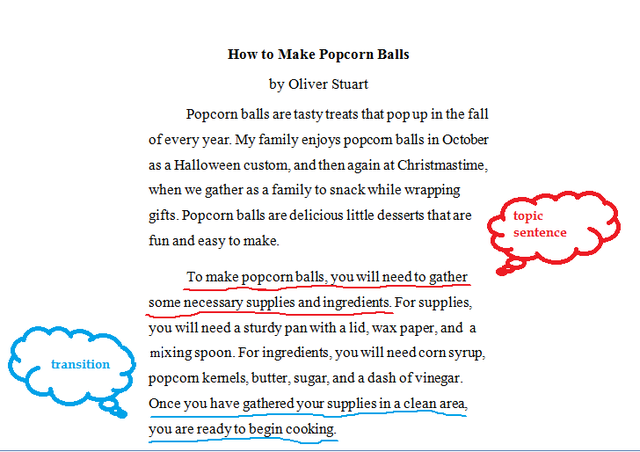
Size: 130 KB
Crafting Your Introduction
1. Grab your reader’s attention within the first 1–2 sentences. Today’s readership has a very short attention span. You see books being made into movie adaptations. Some books are being even made into TV shows for a longer and more detailed story line. Although there are some people who also prefer reading compared to watching, there are people who can tell a good book just by the first few paragraphs of the first page alone. You get that right, then you would have gained new readership. DIY and “How To” videos may be easy to create and draft a new introduction, but essays, not so much. It is usually the make or break stage for the essay. They say that when you start strong, it is just as important and vital to end strong as well. Leave the audience wanting to do more of your DIY projects or videos in the near future. Should you be interested in writing a reflective essay , you may want to click on the hyperlink on this sentence.
For instance, you might write, “The process of preparing lasagna has a rich heritage all of its own.”
2. Provide a general time estimate. Providing time estimates are very essential especially in writing these process essays as everyone might have some other plans other than doing the DIY video or following the process essay they happen to be reading. In cooking or baking, time is considered very critical. An example would be when the participants of MasterChef are asked to cook one of Gordon Ramsay’s signature dishes to avoid elimination. Even when cooking something as simple as scrambled eggs, one of the steps that Gordon suggested would be to stir over medium heat until the eggs start to cook.
The next step would be to remove the egg mix from heat and then continue stirring eggs for about 30 seconds. Return to heat, continue to stir eggs until they start to clump. He suggested that it is important to keep it “on and off” from the heat, otherwise, the eggs might be overcooked which as a result becomes watery. You would not want that to happen to your eggs, would you? Should you find yourself in need of writing an analytical essay , you may want to refer to the hyperlink found on the sentence.
3. If your process essay focuses on a cooking task, this is where you inform your audience to have some sort of clock or timer nearby for them to keep track of the number of minutes that have passed by and to place all the ingredients on the table beforehand.
4. Present the thesis statement as a problem. A thesis statement focuses your ideas into one or two sentences. It should present the topic of your paper and also make a comment about your position in relation to the topic. The thesis statement is considered to be the most important sentence of your paper as it informs the reader not only which problem you will be examining, but it should give them an idea as to how you will be able to solve the issue at hand. Your thesis statement should tell your reader what the paper is about and also help guide your writing and keep your argument focused. The thesis statement should be the last sentence of your introductory paragraph. Here are some examples of short essays that might serve as a reference in case you need assistance in formulating one.
5. You can start off your thesis statement like this, “This essay will explore how to create a complicated lasagna dish in a short period of time by preparing the noodles and sauce in advance.”
The Writing Process
Size: 25 KB
Pros and Cons of Adoption Essay Sample
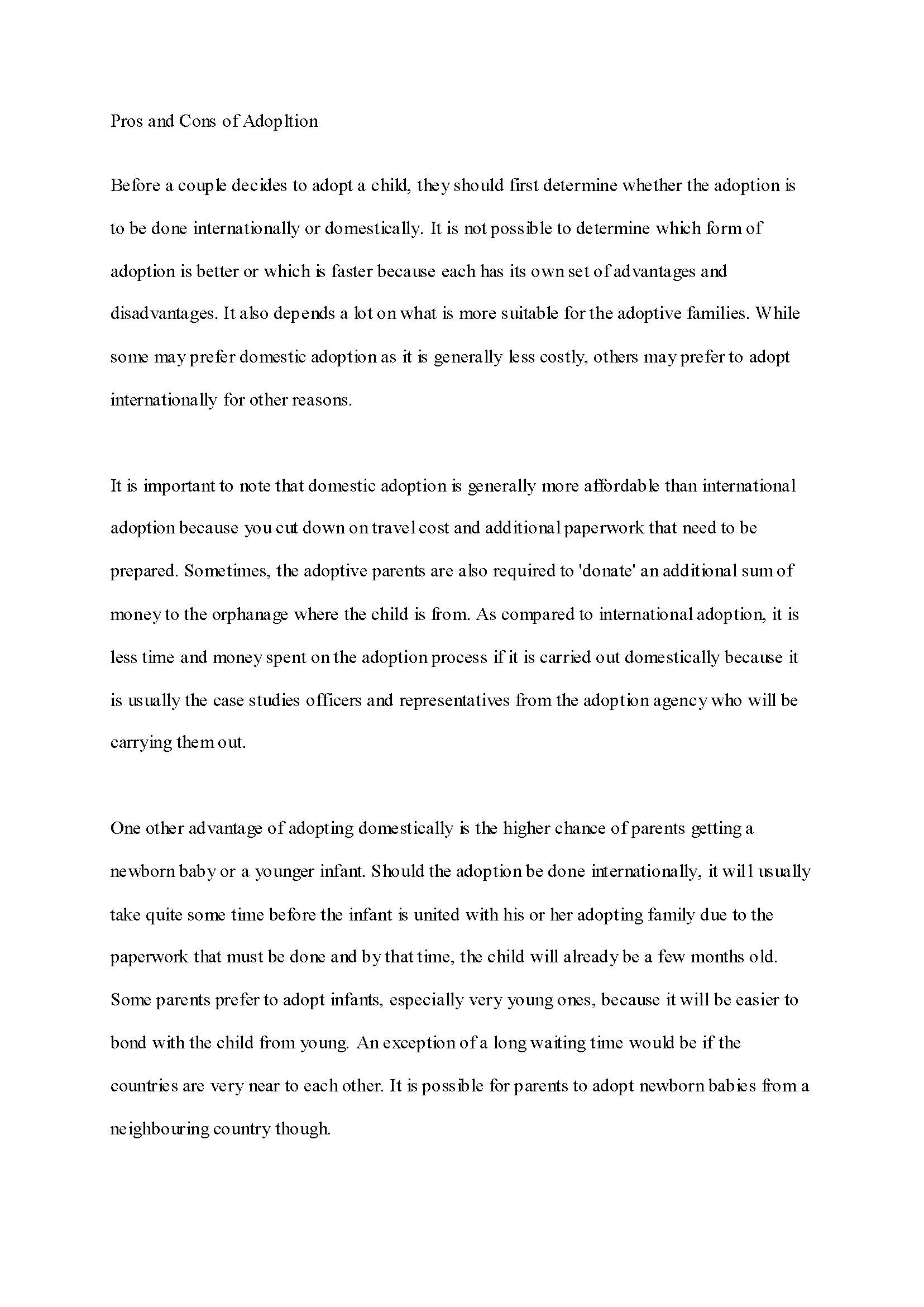
Size: 342 KB
Process Essay Example about Bathing Your Dog
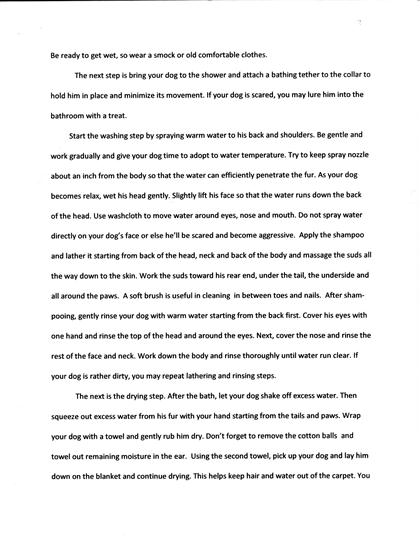
s3.amazonaws.com
Size: 45 KB
Basic Process Essay Example

Size: 756 KB
Writing Your Body Paragraphs
1. consult your outline.
People have the tendency to be sidetracked, especially when making their own stories or novels or any written work for their personal use or for their schoolwork. From time to time, it is best to try and consult with the outline that you have made as not to get lost and personally confused to where you currently are in your essay making process. As aforementioned, outlines are considered an excellent way to draft the flow of your speech or essay should you ever get lost somewhere in the middle of your essay writing. Always refer back to your bullet points if ever your point was not made somewhere in the body of the paragraph. The outline is not always right, it is merely temporary. The possibility of not following your outline might not actually exist if you have happened to draft a better one. For more ways to help start up your essay , you may refer to this hyperlink.
Try to be very careful with items that consist of multiple steps. Make the transitions clear enough and acknowledge prior steps regarding a particular item, if at all applicable.
2. Structure the body of the essay in paragraphs
The outline simply serves as the guide for your essay and is not really the speech itself. Since you have already given some thought into making the outline, now is high time to formulate the body of your essay. As much as possible, when you decide to do the initial draft of your essay, keep it in paragraph form. Bullet points may be simpler, but it is first and foremost an essay. For instance, if your process essay is about making the best shepherd’s pie, try drafting a paragraph on how to make the filling below and another paragraph on how to create good mashed potatoes on top of the lamb filling below. This, in turn, separates the two ideas for easy clarification.
Scholarship essays are normally written by applicants who wish to get their education at a lesser price, considering they uphold to the following conditions.
3. Add transitions in between steps
And since it is a process essay, it is very important that you place transitions on the steps to allow your readers to help identify as to what is Step 1 and what is Step 2. These transitions make it easier for the readers to help proceed to the next step without worrying they might have missed something on the previous step. Examples of some transitions would be the words next , first , later , then , finally , before , afterward , etc. For some examples of formal essays , you may refer to the hyperlink.
For instance, you could write, “Next, place the pot on the stove,” to move from one paragraph to the next.
4. Avoid using first-person pronouns
Including I , we , us , me , mine , our , and ours within your writing can make it seem less declarative and authoritative. In a process essay, this can make a reader less likely to trust your instructions. Instead, stick with a second and third-person perspective by using words, such as it or they . Here are some examples of argumentative essays for your reference.
For example, you could write, “This essay shows…” instead of “I’ll show.”
5. Mention any cautionary notes
Some people would normally forget to add that at the end of the process essay. This is perhaps one of the worst things that the author will not bother doing since he or she did not think that the reader will go to that extent of not following what was written. As someone who has written the process essay in the first place or a notable DIY star on YouTube, please mention some of the mistakes or actions that people tend to do when performing the said task. By doing so, you might actually save a life when you warn people beforehand. These cautionary notes serve as a warning to people as it might have already happened to some unfortunate people already. So when you are warned not to microwave your electronic devices for the sake of fun, just do not. For reference in writing personal essays , you can go through our website to find out more.
For example, you might caution a reader to “Cook the meat until it is no longer red in the center.” This advice will help them to avoid foodborne illness.
Process Essay Example about Hosting the Pre-Homecoming Dance Dinner
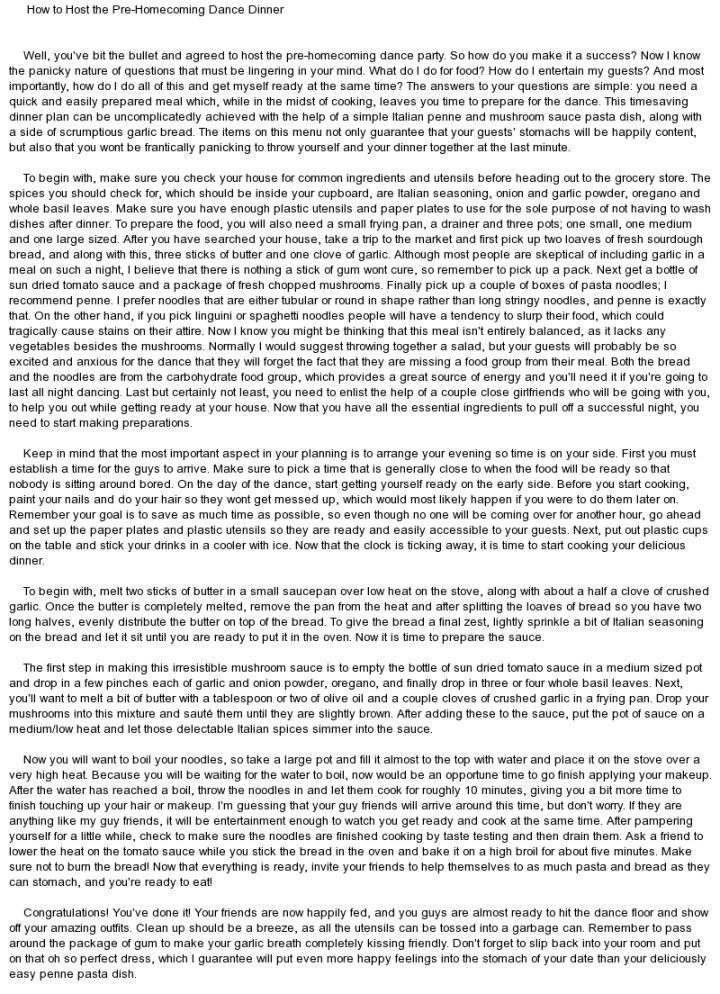
Size: 262 KB
Process Essay Writing Example
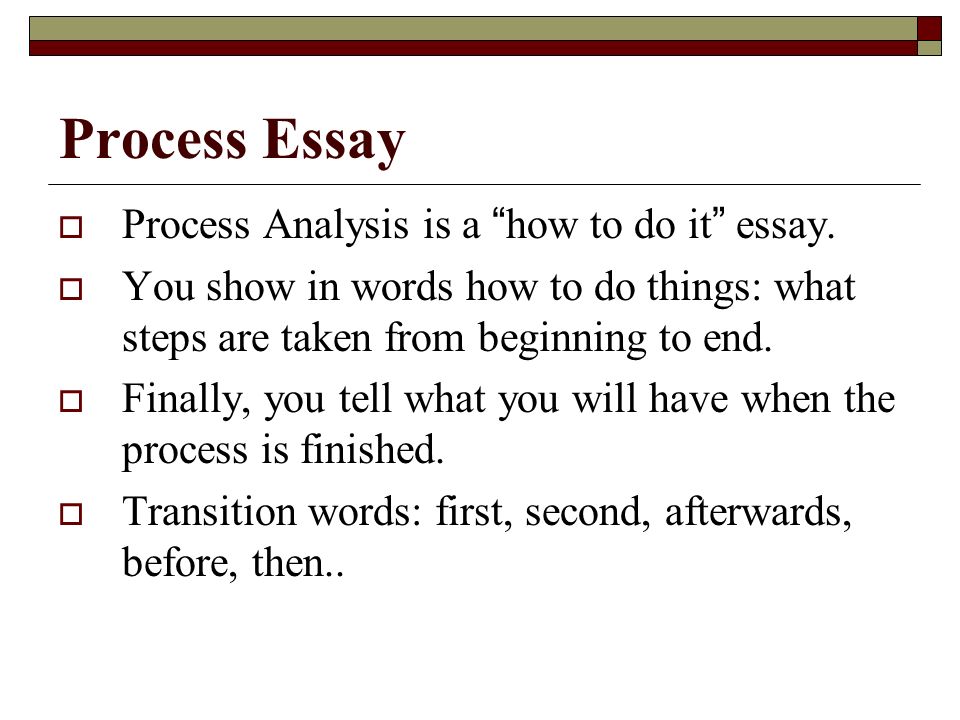
Size: 79 KB
Sample Outline of a Research Article
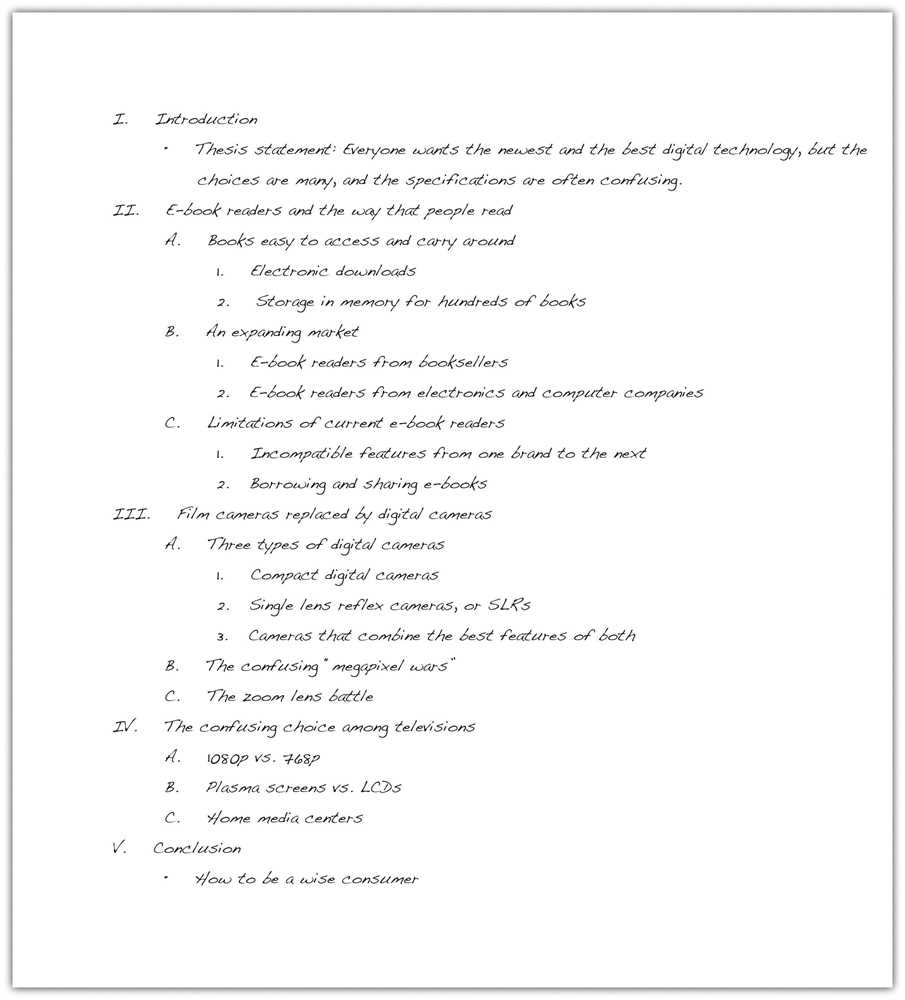
Size: 78 KB
Process Analysis Essay Writing Tips

Size: 95 KB
Odor Nuisances Sample Essay
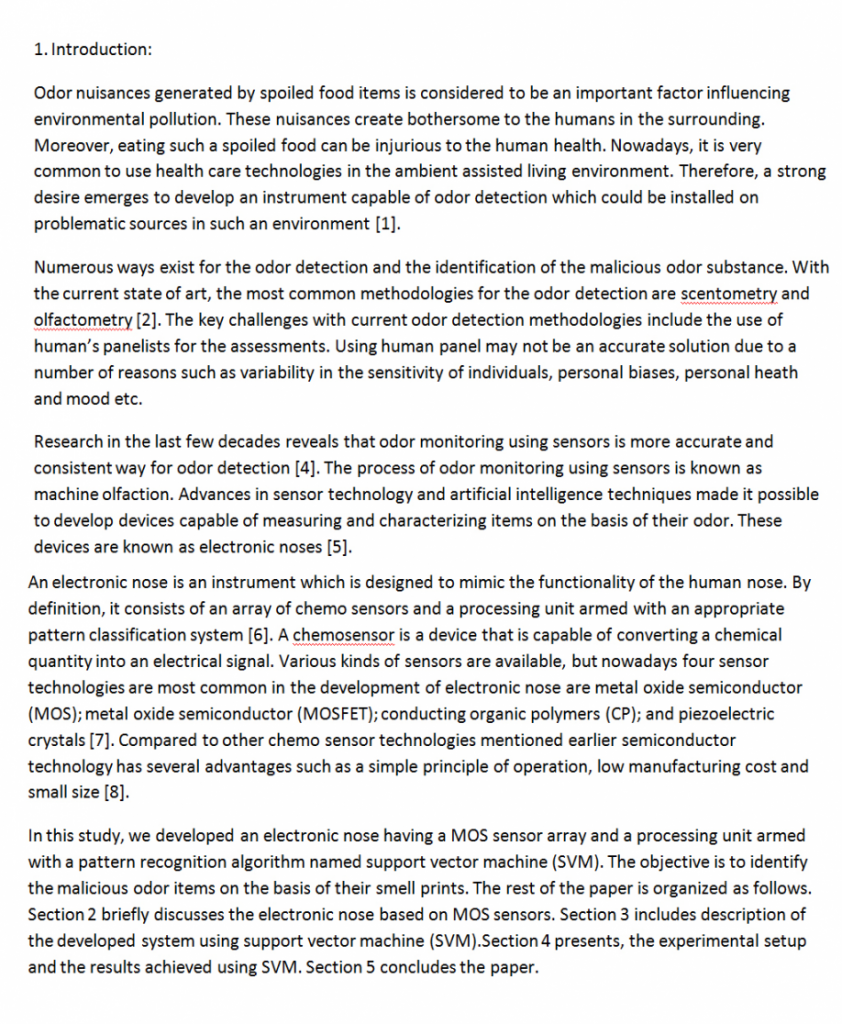
Size: 776 KB
The Process of Building Stonehenge Research Paper
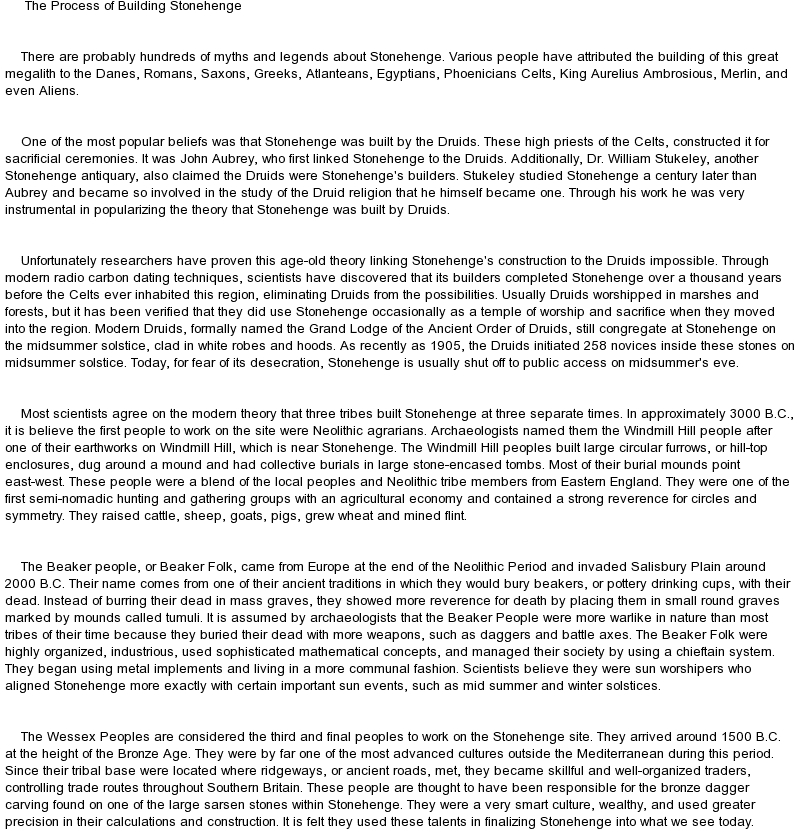
Size: 241 KB
Wrapping It Up
1. Mention the end product and what to do with it. At the last few minutes of the DIY video or the process essay, you can see that you are almost through making the said product. Now, there are some people who might already have an idea of what to do with them. For example, let us say that you are done making the recipe for the coffee jelly dessert. You can provide suggestions as what to do with the coffee jelly that you have made (e.g., After cutting the coffee jelly into cubes, pour it into a tall glass and pour some cold-brewed coffee to give it that extra flavor. And finally, top it off with some ice cream and place a spoon or straw. Best served chilled with family and friends). Here are some tips and examples that you might need when writing a thesis statement for your narrative .
2. Restate the importance of the task. Cooking has proven itself to be quite a challenge, especially when one has no background or experience in cooking. It can otherwise be daunting, and there will be times that you will feel like passing out or giving up. But if you hold on to the very reason as to why you are doing it in the first place, it will keep you focused on completing the task at hand quicker than expected. To be quite fair and frank, this is often utilized by marketing stunts everywhere even in making DIY arts and crafts projects for Father’s Day and Mother’s Day. Here are some examples of persuasive essays that can serve as a reference when writing essays.
3. A basic example of a newly-made dinner intended for your parents’ anniversary might be, “And there you have it! A delicious yet quick meal fit for the two of them to enjoy which looks complicated and sophisticated but is actually simple enough with enough practice. Next time, experiment with different herbs and spices to find your own spin on this classic dish.”
4. Check your essay for ease of reading. Now that you are through writing your essay, the next best logical thing to do would be to actually take some time to review them. If you think you are satisfied with the flow of the essay that you have written, then you may publish it with ease. But if you do not think you are comfortable or assume that there is something lacking in the process essay, take the time to double-check the content and add the necessary content to the essay. While you are in the middle of double-checking, try adding a few final touches to your essay for it to sound better. Lend your essay to a friend or family member to check if they had understood the whole process. Here are some examples of academic essays .
5. One tip would be to see if there are certain steps that you can eliminate or condense your instructions as not to take up too much space in the essay. A reader is more likely to finish directions that they can easily skim through.
6. Proofread your essay. Finally, proofread your essay. Don’t rely on spell-check alone, as it cannot account for context and doesn’t catch every error. But other than spell-checking your essay, make sure to also check for typographical errors in terms of grammar and preposition, subject-verb agreement, etc. Keep in mind that people from all over will be reading your essay, so make sure that it is written professionally in whatever language you will be using. Here are some examples of high school essays that you can refer to.
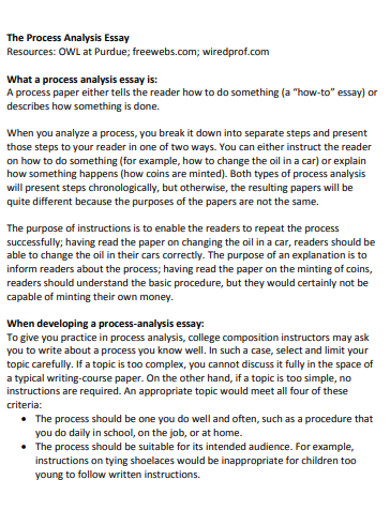
Size: 198 KB
Expository or Process Essay Example
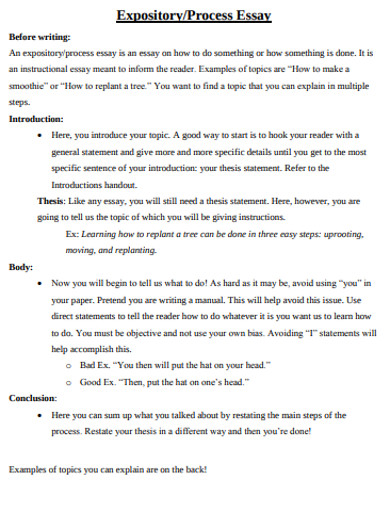
Size: 329 KB
Minimalist Process Essay Example
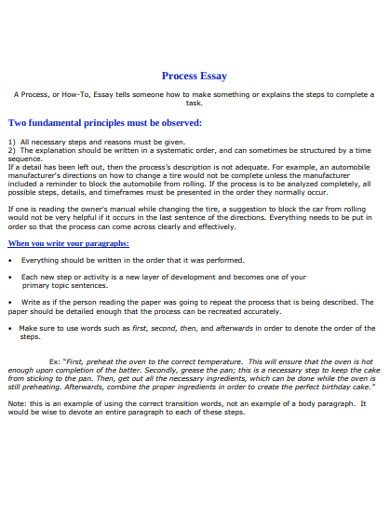
Size: 90 KB
Process Essay Example in PDF
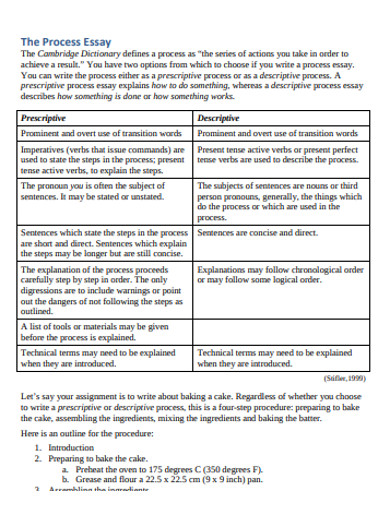
Size: 109 KB
Fundamental Process Essay Example

Size: 64 KB
Cheerleading Routine Process Essay Analysis Example
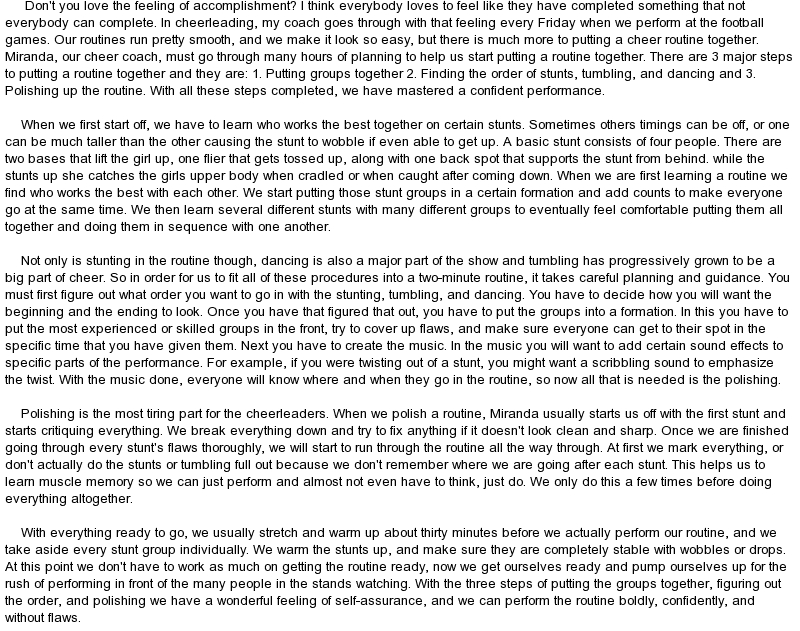
Size: 220 KB
Interesting Process Essay Ideas to Write in 2019
2019 is considered the “Year of the Earth Pig.” This could indicate laziness; however, it could also depict enthusiasm for some people. Considering that the usage of social media and the internet in this year is prevalent, people tend to view loads of various information that shape their own perspective. Moreover, this era strongly pushes the empowerment for every individual to showcase themselves, abling them to do what they want to do. Conclusively, the freedom of this age provides people a wide variety of interests.
A process essay explains the how-tos of a certain topic. Now that you already tackled the basics of this composition as well as the steps in making one, we are giving you in this section some exciting ideas that you can use in writing your own process essay for this year, 2019. According to your preference, you may consider selecting from these topics:
1. Technology-based ideas
2019 is a year that belongs to an era of rapidly innovating technology where gadgets and internet are major tools for almost everybody. Hence, it is not a surprise that people commonly ask some steps regarding technology. In writing your 2019 process essay, here are some examples of technology-based ideas:
- How to create your own Facebook account?
- How to reboot your phone?
- How to create your own Instagram account?
- How to upload several pictures on Facebook in 3 simple clicks?
- How to invite someone to play an online game?
- How to rank up in Mobile Legends?
- How to call someone via Messenger?
- How to use Snapchat as a newbie?
- Step-by-step guide in composing your first tweet
- How to perform a factory reset on your phone?
2. Smart aesthetic hack ideas
The presence of the internet also paved the way for beauty online influencers to showcase their own intelligent ideas. Consisted of mostly females, different channels and blogs fascinate their audience with their various mind-blowing hacks in grooming oneself. They also give some out-of-the-box solutions to the common aesthetic dilemmas. Basically, topics under this section range from fashion to beauty tips bonanza which include:
- How to transform a shirt into a skirt?
- How to rescue your shattered face powder?
- DIY T-shirt printing
- How to brush teeth the correct way?
- Alternative ways to curl hair
- How to make your own anime costume?
- How to make your own natural body scrub?
- How to do your full-face make-up in 3 easy steps?
- How to select the perfect sunglass for you?
- How to distinguish fake jewelry from genuine ones?
An important reminder, try to talk about processes that do not involve your audience’s health, especially if you are not a professional or your step is not yet widely studied.
3. Cooking hack ideas
Food is a basic necessity for each individual and just like the previous one, the internet also provided the cooking pros a medium to share their impressive easy-to-do recipes and strategies in preparing edibles. This extends from simple snacks and desserts to meals of rare occasions, turning simple white plates to something you can boast your friends of. These ideas may include:
- How to make a home-made chocolate fudge?
- Simple steps in making a no-bake cake
- How to slice onions the correct way?
- Impressive ways to plate your meal
- Easy-to-make soup recipes
- How to brine a turkey?
- How to make the perfect sandwich for your kids?
- How to boil eggs perfectly?
- How to remove avocado seed fast?
- Step-by-step guide in assembling cake layers
Text prompt
- Instructive
- Professional
Write a Process Essay on how to prepare for a high school exam.
Discuss the steps involved in writing a research paper for your Process Essay.
Step-By-Step Guide on How To Write A Process Essay (W/ Essay Example)
Aug 28, 2024 | 0 comments

Aug 28, 2024 | Blog | 0 comments
Table of Contents
Key Takeaways
- Process essays aim to provide a step-by-step guide on completing a task, which can range from general tasks to specific detailed processes in a variety of fields such as education, business, and technical industries.
- There are two main types of process essays: the Process Essay, which offers a general description and instructions, and the Process Analysis Essay, which delves into deeper analysis and details of the process.
- The benefits of writing a process essay include improving explanation skills, enhancing proofreading abilities, and strengthening overall writing skills, as it requires logical organization and clear instructions.
- The writing process involves several key steps: understanding the topic, crafting a strong thesis statement, drafting the introduction, writing detailed body paragraphs, creating a strong conclusion, and revising and editing the essay thoroughly.
- Choosing a familiar topic for your process essay is crucial for providing accurate and detailed instructions, ultimately guiding the reader effectively through the required steps.
Are you struggling with writing an effective process essay? Whether you’re a student needing help with an academic essay or just want to learn how to write a good process essay, understanding the writing process is essential. To effectively describe the process of completing a certain task, it’s important to know how to structure your essay in a way that flows logically and is easy for your audience to follow. In this step-by-step guide, we’ll show you how to write a process essay, complete with an essay example to help you understand the concept better. First, we’ll discuss the different types of process essays, such as the expository essay and the process analysis essay. Then, we’ll delve into the writing process, including how to create an outline, use transition words, and ensure your essay is in chronological order. By the end of this article, you’ll have the tools you need to start writing your process essay, no matter the subject.
People Also Read
- How to write a Spooky Essay on Halloween (With Example)
- How to Write a Diagnostic Essay: A Step-by-Step Guide (With Example)
- How to Structure an Informative Essay: A Step-by-Step Guide
What Is a Process Paper?
A process paper is a written guide that explains how to complete a certain task or achieve a specific goal. It provides detailed instructions and clear steps to follow to complete the process. Process papers are commonly used in a variety of fields including education, business, and technical industries. They are a valuable tool for providing clarity and guidance for individuals who may be unfamiliar with a particular process. By following the instructions laid out in a process paper, individuals can effectively accomplish their desired tasks or goals.
The difference between a Process Essay and a Process Analysis Essay
The main difference between a Process Essay and a Process Analysis Essay lies in the approach and focus. A Process Essay describes the process of how something is done or how something works, providing a step-by-step guide to the reader. It is often more general and can cover a wide range of topics. On the other hand, a Process Analysis Essay goes into much more detail and analysis, focusing on the specific steps and techniques involved in a particular process. It delves deeper into the intricacies of the process and aims to provide a thorough understanding of the topic at hand. Both essays aim to inform and educate, but they differ in the level of detail and analysis they provide.
Benefits of Writing a Process Essay
- Improves Explanation Skills: Writing a process essay requires breaking down a task or process step by step. By doing so, you become better at explaining complex concepts clearly and understandably. This skill can be impactful in various aspects of your life, from explaining instructions to others to clarifying procedures at work.
- Enhances Proofreading Abilities: Since process essays aim for clarity and conciseness, you’ll need to proofread your work meticulously. This practice helps you catch typos and grammar mistakes, ensuring your essay is error-free. Additionally, it teaches you to be careful with items that contain imperative sentences, ensuring they are precise and easy to follow.
- Strengthens Writing Skills: Writing a process essay follows the structure of an essay, including an introduction, body paragraphs, and a conclusion. Through this process, you refine your ability to organize your thoughts logically and cohesively. Each part of your essay must flow smoothly from one step to another, reinforcing the importance of structure in writing.
Process Essay Outline: Structuring Your Paper
How to Plan a Successful Party: A Step-by-Step Guide I. Introduction A. Explanation of what a party planning process essay is B. Importance of planning a successful party C. Overview of the steps to be covered in the essay II. Understanding the Party Planning Process A. Defining the purpose and type of party B. Setting a budget and determining the guest list C. Choosing a date, time, and location for the party III. Selecting a Theme and Décor A. Brainstorming theme ideas based on the occasion and preferences B. Selecting appropriate decorations, colors, and ambiance C. Planning for any specific decorations or props needed IV. Organizing Food and Drinks A. Planning the menu based on the theme and preferences of guests B. Creating a shopping list for ingredients and supplies C. Considering dietary restrictions and preferences of attendees V. Arranging Entertainment and Activities A. Deciding on music, games, or entertainment options B. Renting or purchasing any necessary equipment or supplies C. Planning for any special performances or activities VI. Sending Invitations and Confirmations A. Designing and sending out invitations with necessary details B. Following up with RSVPs and guest confirmations C. Providing directions or instructions for attending the party VII. Preparing the Venue and Setting Up A. Cleaning and decorating the party space B. Setting up tables, chairs, and other furniture as needed C. Arranging food and drink stations, entertainment areas, and seating arrangements VIII. Hosting the Party A. Welcoming guests and ensuring they feel comfortable B. Managing food and drink service throughout the event C. Facilitating entertainment and activities to keep guests engaged IX. Wrapping Up and Cleaning Up A. Thanking guests for attending and expressing gratitude B. Collecting feedback and suggestions for future parties C. Cleaning up the venue and disposing of any waste or leftover items X. Conclusion A. Recap of the key steps in planning a successful party B. Emphasis on the importance of thorough planning and attention to detail C. Encouragement to apply the process outlined for future party planning endeavors.
How to Write a Process Essay
Learning how to write a process essay is essential for effectively guiding readers through a series of steps to complete a task or understand a process. This comprehensive guide provides step-by-step instructions and practical tips to help you craft a clear, concise, and informative process essay.
Step 1: Understanding the Topic
Understanding the topic is the first crucial step in writing a process essay. Before diving into the writing process, you must have a clear grasp of the task or process you’re explaining. Here’s how to understand the topic effectively:
- Analyze the Assignment Prompt: Start by carefully reading the assignment prompt or guidelines. Pay attention to any specific instructions provided by your instructor regarding the topic, scope, and objectives of the process essay.
- Research and Gather Information: Conduct thorough research to gather information about the process you intend to explain. Utilize credible sources such as books, articles, websites, or personal experiences to gain a comprehensive understanding of the topic.
- Identify Key Steps and Components: Break down the process into its essential steps and components. Consider the chronological order of these steps and any additional details or variations that may be relevant to your audience.
- Consider the Audience Perspective: Put yourself in the shoes of your audience and consider what they already know about the topic. Tailor your explanations to their level of understanding and anticipate any questions or areas of confusion they may have.
- Clarify Ambiguous or Complex Concepts: If there are any ambiguous or complex aspects of the topic, take the time to clarify them. Use simple language and clear examples to ensure that your readers can follow along easily.
- Define Key Terms: Define any technical terms or jargon associated with the process to ensure clarity for your readers. Avoid assuming prior knowledge and provide explanations for terms that may be unfamiliar.
Process Essay Topics
- How to Bake a Perfect Chocolate Cake
- Planning a Budget-Friendly Vacation
- Organizing a Successful Garage Sale
- Crafting the Ideal Study Schedule
- Mastering Basic Cooking Techniques
- Building a DIY Birdhouse for Your Garden
- Creating a Personalized Workout Routine
- Growing Your Vegetable Garden
- Designing an Effective Resume for Job Applications
- Setting Up and Managing a Home Recycling System
- Establishing Healthy Sleep Habits for Better Rest
- Writing an Engaging Blog Post from Start to Finish
- Planning and Hosting a Memorable Movie Night
- Developing a Morning Routine for Productivity and Success
- Creating a Travel Itinerary for Your Dream Destination
Step 2: Crafting the Thesis Statement
Crafting a strong thesis statement is a crucial step in the process of writing a process essay. Your thesis statement serves as the roadmap for your essay, guiding readers on what to expect and helping you maintain focus throughout the writing process. Here’s how to tackle this step effectively:
- Importance of a Strong Thesis Statement: In a process essay, a robust thesis statement sets the tone and direction for the entire essay, providing clarity on the purpose and goal of the process being explained. It informs readers about the specific process they will learn about and why it is significant. Without a clear thesis statement, your essay may lack direction, leaving readers confused about the purpose of the essay and the steps involved in the process. A strong thesis statement ensures that your essay remains focused and cohesive, guiding readers through each step of the process with clarity and purpose.
- How to Formulate a Clear and Specific Thesis Statement: Start by identifying the main goal or objective of the process you are explaining. What is the result or outcome that readers should expect to achieve by following the process? Next, clearly state the specific process or task that your essay will explain. Be concise and specific, avoiding vague language or broad statements. Your thesis statement should clearly outline the steps involved in the process without providing unnecessary details. Lastly, consider the audience’s perspective and tailor your thesis statement to their level of understanding. Use language that is accessible and easy to follow, ensuring that readers know exactly what to expect from your essay.
Step 3: Drafting the Introduction
Drafting an engaging introduction is essential in capturing the reader’s attention and setting the stage for your process essay. Here’s how to approach this step effectively:
- Hooking the Reader’s Attention: Begin your introduction with an attention-grabbing hook that piques the reader’s curiosity and encourages them to continue reading. This could be a compelling question, an intriguing fact, a relevant anecdote, or a thought-provoking quote. The goal is to draw readers in and make them eager to learn more about the process you’ll be explaining in the essay. By sparking their interest from the outset, you set a positive tone for the rest of the essay.
- Introducing the Process to be Explained: After hooking the reader’s attention, provide a brief overview of the process that will be the focus of your essay. Clearly state what the process entails and why it is important or relevant. Keep this introduction concise and to the point, giving readers a clear understanding of what they can expect to learn from the essay. Avoid delving into too much detail at this stage, as that will be covered in the body paragraphs.
- Providing Some Background Information on the Process: Depending on the complexity of the process and the knowledge level of your audience, it may be helpful to provide some background information or context to help readers better understand the significance of the process. This background information should be brief and relevant, offering insights into why the process is important or how it fits into a larger context. However, be mindful not to overwhelm readers with unnecessary details at this stage. By hooking the reader’s attention, introducing the process, and providing some background information, your introduction sets the stage for the rest of the essay, laying the groundwork for a clear and engaging exploration of the process at hand.
Step 4: Writing the Body Paragraphs
Writing the body paragraphs is the core of your process essay, where you’ll provide detailed instructions for each step of the process. Here’s how to approach this step effectively:
- Organizing the Steps of the Process in a Logical Order: Begin by organizing the steps of the process in a logical and sequential order. Consider the natural progression of the process and arrange the steps accordingly. Each step should build upon the previous one, leading readers through the process clearly and systematically. Avoid jumping around or presenting steps out of order, as this can confuse readers.
- Using Transitional Words and Phrases to Guide the Reader Through the Process: Use transitional words and phrases to smoothly transition from one step to the next. Words like “first,” “next,” “then,” and “finally” can help signal the progression of the process. These transitions act as signposts for readers, guiding them through each step and helping them understand how the steps are connected.
- Including Clear and Detailed Explanations for Each Step: Provide clear and detailed explanations for each step of the process, ensuring that readers understand exactly what needs to be done at each stage. Use simple language, avoiding unnecessary jargon or technical terms that may confuse readers. Break down each step into manageable chunks and explain each part thoroughly.
- Integrating Visuals or Illustrations to Enhance Understanding (if applicable): If appropriate, consider including visuals or illustrations to complement your written instructions and enhance understanding. Visual aids such as diagrams, charts, or photographs can provide additional clarity and help readers visualize the steps of the process more effectively. Be sure to integrate visuals seamlessly into your essay and provide clear captions or explanations to accompany them.
Step 5: Creating the Conclusion
Creating a strong conclusion is essential for wrapping up your process essay effectively and leaving a lasting impression on your readers. Here’s how to approach this step:
- Reinforcing the Significance of the Process: Begin by reinforcing the significance of the process you’ve explained in your essay. Remind readers why the process is important or relevant, emphasizing its impact or benefits. This helps to underscore the value of the information they’ve gained from reading your essay and reinforces the importance of understanding and mastering the process.
- Summarizing the Key Points of the Essay: Next, summarize the key points of your essay, briefly revisiting each step of the process and highlighting its significance. Keep this summary concise and focused, providing a quick overview of the main ideas without delving into unnecessary detail. By summarizing the key points, you help reinforce the main takeaways of your essay and ensure that readers have a clear understanding of the process you’ve explained.
- Offering Final Thoughts or Potential Outcomes of the Process: Finally, offer some final thoughts or reflections on the process. Consider discussing potential outcomes or results that readers can expect if they follow the process successfully. B. You might also offer suggestions for further exploration or experimentation with the process, encouraging readers to apply what they’ve learned in their own lives or endeavors. By offering final thoughts or outcomes, you provide closure to your essay and leave readers with a sense of satisfaction and direction moving forward.
Step 6: Revising and Editing
Revising and editing your process essay is a critical step in ensuring its clarity, coherence, and overall effectiveness. Here’s how to approach this step:
- Reviewing the Essay for Clarity and Coherence: Start by reviewing your essay from start to finish, focusing on its overall clarity and coherence. Check that each step of the process is explained in a logical and easy-to-follow manner. Pay attention to the flow of your essay, ensuring that each section transitions smoothly into the next. Make any necessary revisions to improve the organization and coherence of your essay.
- Checking for Grammatical, Spelling, and Punctuation Errors: Next, carefully check your essay for grammatical, spelling, and punctuation errors. Look for common mistakes such as incorrect verb tense, subject-verb agreement errors, misspelled words, and misplaced punctuation. Proofread your essay multiple times, reading it aloud if necessary to catch any errors that may have been overlooked. Use grammar and spell-check tools as additional aids in identifying and correcting mistakes.
- Seeking Feedback from Peers or Instructors: Consider seeking feedback from peers or instructors who can provide valuable insights and suggestions for improving your essay. Share your essay with them and ask for their honest feedback on its clarity, organization, and effectiveness. Be open to constructive criticism and use it as an opportunity to make further revisions and improvements to your essay. Consider incorporating any helpful suggestions or recommendations that are offered.
Essay Example: “How to Bake a Perfect Chocolate Cake”
Get help with your process essay paper.
Are you struggling with your process essay? Don’t worry! Essay Freelance Writers is here to help. We’re the best in the industry when it comes to essay writing services. Place your order today by clicking the ORDER NOW button above to get our expert assistance with your process essay writing. Whether it’s crafting a clear thesis statement or organizing the steps of your process, we’ve got you covered. Trust us to deliver high-quality, custom-written essays that meet your every need.
Frequently Asked Questions about Process Essay
What is a process essay.
A process essay is a type of writing that explains a step-by-step process of doing something. It aims to guide the reader through the actions required to complete the task .
How is a process essay different from other types of essays?
A process essay , also known as a how-to essay , focuses on the process of doing something and the parts of the process . Unlike other types of essays, it emphasizes the step-by-step process rather than simply presenting information or arguments.
What is the main body of a process essay?
The main body of a process essay should detail each step-by-step process necessary to complete the task. Each paragraph should focus on a certain process and serve as a guide for the reader.
Why is it important to pick something you know well when writing a process essay?
It is important to pick something you are familiar with when writing a process essay because it allows you to provide detailed and accurate instructions. Your knowledge of the subject will help in explaining the step-by-step process effectively.
What is the goal of a process essay?
The goal of a process essay is to explain the step-by-step process clearly and concisely. It should provide the reader with a complete understanding of how to complete the task .
What are some common mistakes to avoid when writing a process essay?
Some common mistakes to avoid when writing a process essay include using ambiguous language like “next ” or “then ” instead of providing specific instructions, and not considering the reader’s level of knowledge on the topic. It is also important to ensure that the words like “next and “now used are appropriate for the type of paper .

With a passion for helping students navigate their educational journey, I strive to create informative and relatable blog content. Whether it’s tackling exam stress, offering career guidance, or sharing effective study techniques

Most Popular Articles
Racism thesis statement example, how to rephrase a thesis statement, capstone project topic suggestions, how to write an abortion essay, should students wear school uniforms essay, list causal essay topics write, respect essay, signal words, great synonyms, informative speech examples, essay writing guide, introduction paragraph for an essay, argumentative essay writing, essay outline templates, write an autobiographical essay, personal narrative essay ideas, descriptive essay writing, how to write a reflective-essay, how to write a lab report abstract, how to write a grant proposal, point of view in an essay, debate topics for youth at church, theatre research paper topics, privacy overview.
List of Topics for How-to Essays
Choosing the Right Topic Is Critical to Success
Blend Images / Getty Images
- Writing Essays
- Writing Research Papers
- English Grammar
- M.Ed., Education Administration, University of Georgia
- B.A., History, Armstrong State University
Selecting a how-to essay topic can sometimes feel tougher than writing the assignment. If you're like many students, you might feel as though you don't know anything well enough to teach others—but that's not true. All people have something that they can do so well that they don't even think about how to do it anymore—they just do it.
Choosing the Right Topic
When you read over the list of how-to examples below you will realize that you do know many things in depth, some well enough to teach. Typically, your inspiration will be based on lateral thinking. For example, from the list below, you may decide to write an essay on how to cook a Scottish egg after you see "Crack an egg" in the list. Or you may decide to write about how to make an Excel spreadsheet with all of your homework listed after seeing "Organize your homework" on the list.
Narrow your choices to a few topics , and then brainstorm for a few minutes about each one. Determine which has the most potential—one that can be divided into five to 10 clear paragraphs that you can explain well.
Writing Tips for How-To Essay Topics
Some topics are easier than others to explain. Straightforward processes versus ones with lots of contingencies will be much less complicated to write out, for instance. If you find that you've chosen a topic that's just too broad, pick one portion of it to explain. Remember, you want your reader to be able to follow your instructions to successfully complete the process.
In your drafting, err on the side of too much detail and description rather than too little. (It's easier to cut material that you don't need than to add it later.) If you're not allowed to use images with your instructions, choosing a topic that is aided by visuals makes writing the instructional process much more challenging, so consider your assignment parameters as you choose what to write about.
If you know your how-to essay topic so well that it comes naturally to you, it may be tough to write instructions for a beginner who has no knowledge of the topic, because you forget how much you didn't know when you first started. Have a partner try out your instructions during the drafting or revision phase (or both) to see what you've left out or what isn't explained clearly enough in your process essay .
How-to Essay Topics
- Raccoon-proof your campsite
- Make an obstacle course for squirrels
- Set a table
- Make a pet costume
- Start a band
- Make a piñata
- Make an omelet
- Start beekeeping
- Make a quilt
- Decorate a bedroom
- Create a podcast
- Start a recycling program
- Collect stamps
- Clean a bedroom
- Make a pizza
- Make a volcano
- Organize your homework
- Play the guitar
- Make a sock puppet
- Make a doll dress
- Write a letter to the editor
- Write a complaint
- Plan a party
- Plant a tree
- Create a cartoon character
- Improve your spelling
- Bake a layer cake
- Change a tire
- Drive a stick shift
- Make a Christmas stocking
- Learn to dance
- Do a magic trick
- Go bird watching
- Make a music video
- Make a candle
- Paint a picture
- Create art with crayons
- Create a web page
- Stay safe on the Internet
- Write a song
- Write a poem
- Make a handbag
- Tie a scarf
- Mow the lawn
- Make a hamburger
- Make pancakes
- Make a pillow
- Play football
- Make a sculpture
- Make a lamp
- Make shadow puppets
- Care for pets
- Build a tree house
- Play hide and seek
- Paint fingernails
- Make homemade slippers
- Tie macramé knots
- Make a sandwich
- Make chocolate milk
- Make hot chocolate
- Climb a tree
- Make a milkshake
- Sell old toys
- Ride a skateboard
- Eat crab legs
- Become a vegetarian
- Make a salad
- Design a jack-o-lantern
- Ride a horse
- Race turtles
- Catch lightning bugs
- Make a wildflower bouquet
- Cut paper dolls
- Eat an ice cream cone
- Change a diaper
- Make fruit punch
- Make a campaign poster
- Make a fake tattoo
- Interview a celebrity
- Catch a fish
- Make a snowman
- Make an igloo
- Make a paper fan
- Write a newsletter
- Crack an egg
- Make a necklace
- Tie a necktie
- Ride the subway
- Walk like a model
- Ride a motorcycle
- Pitch a tent
- Find something you've lost
- Curl your hair
- Saddle a horse
- Make a sandcastle
- Bob for apples
- Apply for a job
- Draw stick figures
- Open a bank account
- Learn a new language
- Ask for a later curfew
- Behave at a fancy dinner
- Ask somebody out
- Pose for a picture
- Wake up in a good mood
- Send Morse code messages
- Make a kite
- Hem your jeans
- Pitch a fastball
- Be a ghost hunter
- Make string art
- Mop a floor
- Peel an apple
- String popcorn
- Remix a song
- Walk a tightrope
- Stand on your head
- Find the Big Dipper
- Wrap a gift
- Roast a marshmallow
- Clean a window
- Make a campfire
- Have a yard sale
- Create a carnival in your yard
- Make balloon animals
- Plan a surprise party
- Wear eye makeup
- Invent a secret code
- Recognize animal tracks
- Train a dog to shake hands
- Make a paper airplane
- Pull a tooth
- Create playlists
- Play rock, paper, scissors
- Floss your teeth
- 100 Persuasive Essay Topics
- 50 Argumentative Essay Topics
- Examples of Great Introductory Paragraphs
- Complete List of Transition Words
- 67 Causal Essay Topics to Consider
- 501 Topic Suggestions for Writing Essays and Speeches
- How to Write a Narrative Essay or Speech (With Topic Ideas)
- How to Write a Great Process Essay
- Cause and Effect Essay Topics
- Structure of a Descriptive Essay
- What Is Expository Writing?
- Topical Organization Essay
- Personal Essay Topics
- Tips for Writing a "What I Did on Vacation" Essay
- Ecology Essay Ideas
- How to Outline and Organize an Essay

- Kindergarten
- Middle School
- High School
- Math Worksheets
- Language Arts
- Social Studies
Process Essay Examples
A process essay is an essay that explains or outlines the process for making something or completing a process or activity. Process essays are most often organized in a chronological or step-by-step manner, such that the reader is lead through the process of making something or completing an activity.
Because of the step-by-step nature of a process essay , transition words are critically important in the process essay. The reader has to know what to do first, next, and finally. The reader also has to know what to do "before" something else, "while" something else is happening, or even "eventually."
While they are not technically full essays, recipes are a good example of a process writing. Recipes include a step-by-step process for making a food or dish. Process essays have the same purpose as recipes-to lead the reader through the process.
This is an excerpt from an essay on how to make the best peanut butter and jelly sandwich.
Some people say that you should spread the peanut butter on one slice of bread and the jelly on the other. However, these people have never experienced the best peanut butter and jelly sandwich ever made.
You begin with a bowl-not too big, and not too small. You gather the ingredients-peanut butter, jelly, and white bread. The best peanut butter is the creamy kind, and make sure the bread is fresh and soft.
After gathering the ingredients, spoon a large clump of peanut butter into the bowl. Adjust the amount depending on the number of sandwiches you plan to make. Then, spoon a large clump of jelly into the bowl with the peanut butter. Using the spoon, mix the peanut butter and jelly together. You will need to stir briskly to mix the two. This is the secret to the best peanut butter and jelly!
| |
More Topics
- Handwriting
- Difference Between
- 2020 Calendar
- Online Calculators
- Multiplication
Educational Videos
- Coloring Pages
- Privacy policy
- Terms of Use
© 2005-2020 Softschools.com
Have a language expert improve your writing
Run a free plagiarism check in 10 minutes, generate accurate citations for free.
- Knowledge Base
- Academic writing
- A step-by-step guide to the writing process
The Writing Process | 5 Steps with Examples & Tips
Published on April 24, 2020 by Jack Caulfield . Revised on December 8, 2023.

Good academic writing requires effective planning, drafting, and revision.
The writing process looks different for everyone, but there are five basic steps that will help you structure your time when writing any kind of text.
Receive feedback on language, structure, and formatting
Professional editors proofread and edit your paper by focusing on:
- Academic style
- Vague sentences
- Style consistency
See an example

Table of contents
Step 1: prewriting, step 2: planning and outlining, step 3: writing a first draft, step 4: redrafting and revising, step 5: editing and proofreading, other interesting articles, frequently asked questions about the writing process.
Before you start writing, you need to decide exactly what you’ll write about and do the necessary research.
Coming up with a topic
If you have to come up with your own topic for an assignment, think of what you’ve covered in class— is there a particular area that intrigued, interested, or even confused you? Topics that left you with additional questions are perfect, as these are questions you can explore in your writing.
The scope depends on what type of text you’re writing—for example, an essay or a research paper will be less in-depth than a dissertation topic . Don’t pick anything too ambitious to cover within the word count, or too limited for you to find much to say.
Narrow down your idea to a specific argument or question. For example, an appropriate topic for an essay might be narrowed down like this:
Doing the research
Once you know your topic, it’s time to search for relevant sources and gather the information you need. This process varies according to your field of study and the scope of the assignment. It might involve:
- Searching for primary and secondary sources .
- Reading the relevant texts closely (e.g. for literary analysis ).
- Collecting data using relevant research methods (e.g. experiments , interviews or surveys )
From a writing perspective, the important thing is to take plenty of notes while you do the research. Keep track of the titles, authors, publication dates, and relevant quotations from your sources; the data you gathered; and your initial analysis or interpretation of the questions you’re addressing.
Prevent plagiarism. Run a free check.
Especially in academic writing , it’s important to use a logical structure to convey information effectively. It’s far better to plan this out in advance than to try to work out your structure once you’ve already begun writing.
Creating an essay outline is a useful way to plan out your structure before you start writing. This should help you work out the main ideas you want to focus on and how you’ll organize them. The outline doesn’t have to be final—it’s okay if your structure changes throughout the writing process.
Use bullet points or numbering to make your structure clear at a glance. Even for a short text that won’t use headings, it’s useful to summarize what you’ll discuss in each paragraph.
An outline for a literary analysis essay might look something like this:
- Describe the theatricality of Austen’s works
- Outline the role theater plays in Mansfield Park
- Introduce the research question: How does Austen use theater to express the characters’ morality in Mansfield Park ?
- Discuss Austen’s depiction of the performance at the end of the first volume
- Discuss how Sir Bertram reacts to the acting scheme
- Introduce Austen’s use of stage direction–like details during dialogue
- Explore how these are deployed to show the characters’ self-absorption
- Discuss Austen’s description of Maria and Julia’s relationship as polite but affectionless
- Compare Mrs. Norris’s self-conceit as charitable despite her idleness
- Summarize the three themes: The acting scheme, stage directions, and the performance of morals
- Answer the research question
- Indicate areas for further study
Once you have a clear idea of your structure, it’s time to produce a full first draft.
This process can be quite non-linear. For example, it’s reasonable to begin writing with the main body of the text, saving the introduction for later once you have a clearer idea of the text you’re introducing.
To give structure to your writing, use your outline as a framework. Make sure that each paragraph has a clear central focus that relates to your overall argument.
Hover over the parts of the example, from a literary analysis essay on Mansfield Park , to see how a paragraph is constructed.
The character of Mrs. Norris provides another example of the performance of morals in Mansfield Park . Early in the novel, she is described in scathing terms as one who knows “how to dictate liberality to others: but her love of money was equal to her love of directing” (p. 7). This hypocrisy does not interfere with her self-conceit as “the most liberal-minded sister and aunt in the world” (p. 7). Mrs. Norris is strongly concerned with appearing charitable, but unwilling to make any personal sacrifices to accomplish this. Instead, she stage-manages the charitable actions of others, never acknowledging that her schemes do not put her own time or money on the line. In this way, Austen again shows us a character whose morally upright behavior is fundamentally a performance—for whom the goal of doing good is less important than the goal of seeming good.
When you move onto a different topic, start a new paragraph. Use appropriate transition words and phrases to show the connections between your ideas.
The goal at this stage is to get a draft completed, not to make everything perfect as you go along. Once you have a full draft in front of you, you’ll have a clearer idea of where improvement is needed.
Give yourself a first draft deadline that leaves you a reasonable length of time to revise, edit, and proofread before the final deadline. For a longer text like a dissertation, you and your supervisor might agree on deadlines for individual chapters.
Now it’s time to look critically at your first draft and find potential areas for improvement. Redrafting means substantially adding or removing content, while revising involves making changes to structure and reformulating arguments.
Evaluating the first draft
It can be difficult to look objectively at your own writing. Your perspective might be positively or negatively biased—especially if you try to assess your work shortly after finishing it.
It’s best to leave your work alone for at least a day or two after completing the first draft. Come back after a break to evaluate it with fresh eyes; you’ll spot things you wouldn’t have otherwise.
When evaluating your writing at this stage, you’re mainly looking for larger issues such as changes to your arguments or structure. Starting with bigger concerns saves you time—there’s no point perfecting the grammar of something you end up cutting out anyway.
Right now, you’re looking for:
- Arguments that are unclear or illogical.
- Areas where information would be better presented in a different order.
- Passages where additional information or explanation is needed.
- Passages that are irrelevant to your overall argument.
For example, in our paper on Mansfield Park , we might realize the argument would be stronger with more direct consideration of the protagonist Fanny Price, and decide to try to find space for this in paragraph IV.
For some assignments, you’ll receive feedback on your first draft from a supervisor or peer. Be sure to pay close attention to what they tell you, as their advice will usually give you a clearer sense of which aspects of your text need improvement.
Redrafting and revising
Once you’ve decided where changes are needed, make the big changes first, as these are likely to have knock-on effects on the rest. Depending on what your text needs, this step might involve:
- Making changes to your overall argument.
- Reordering the text.
- Cutting parts of the text.
- Adding new text.
You can go back and forth between writing, redrafting and revising several times until you have a final draft that you’re happy with.
Think about what changes you can realistically accomplish in the time you have. If you are running low on time, you don’t want to leave your text in a messy state halfway through redrafting, so make sure to prioritize the most important changes.
Check for common mistakes
Use the best grammar checker available to check for common mistakes in your text.
Fix mistakes for free
Editing focuses on local concerns like clarity and sentence structure. Proofreading involves reading the text closely to remove typos and ensure stylistic consistency. You can check all your drafts and texts in minutes with an AI proofreader .
Editing for grammar and clarity
When editing, you want to ensure your text is clear, concise, and grammatically correct. You’re looking out for:
- Grammatical errors.
- Ambiguous phrasings.
- Redundancy and repetition .
In your initial draft, it’s common to end up with a lot of sentences that are poorly formulated. Look critically at where your meaning could be conveyed in a more effective way or in fewer words, and watch out for common sentence structure mistakes like run-on sentences and sentence fragments:
- Austen’s style is frequently humorous, her characters are often described as “witty.” Although this is less true of Mansfield Park .
- Austen’s style is frequently humorous. Her characters are often described as “witty,” although this is less true of Mansfield Park .
To make your sentences run smoothly, you can always use a paraphrasing tool to rewrite them in a clearer way.
Proofreading for small mistakes and typos
When proofreading, first look out for typos in your text:
- Spelling errors.
- Missing words.
- Confused word choices .
- Punctuation errors .
- Missing or excess spaces.
Use a grammar checker , but be sure to do another manual check after. Read through your text line by line, watching out for problem areas highlighted by the software but also for any other issues it might have missed.
For example, in the following phrase we notice several errors:
- Mary Crawfords character is a complicate one and her relationships with Fanny and Edmund undergoes several transformations through out the novel.
- Mary Crawford’s character is a complicated one, and her relationships with both Fanny and Edmund undergo several transformations throughout the novel.
Proofreading for stylistic consistency
There are several issues in academic writing where you can choose between multiple different standards. For example:
- Whether you use the serial comma .
- Whether you use American or British spellings and punctuation (you can use a punctuation checker for this).
- Where you use numerals vs. words for numbers.
- How you capitalize your titles and headings.
Unless you’re given specific guidance on these issues, it’s your choice which standards you follow. The important thing is to consistently follow one standard for each issue. For example, don’t use a mixture of American and British spellings in your paper.
Additionally, you will probably be provided with specific guidelines for issues related to format (how your text is presented on the page) and citations (how you acknowledge your sources). Always follow these instructions carefully.
If you want to know more about AI for academic writing, AI tools, or fallacies make sure to check out some of our other articles with explanations and examples or go directly to our tools!
- Ad hominem fallacy
- Post hoc fallacy
- Appeal to authority fallacy
- False cause fallacy
- Sunk cost fallacy
- Deep learning
- Generative AI
- Machine learning
- Reinforcement learning
- Supervised vs. unsupervised learning
(AI) Tools
- Grammar Checker
- Paraphrasing Tool
- Text Summarizer
- AI Detector
- Plagiarism Checker
- Citation Generator
Revising, proofreading, and editing are different stages of the writing process .
- Revising is making structural and logical changes to your text—reformulating arguments and reordering information.
- Editing refers to making more local changes to things like sentence structure and phrasing to make sure your meaning is conveyed clearly and concisely.
- Proofreading involves looking at the text closely, line by line, to spot any typos and issues with consistency and correct them.
Whether you’re publishing a blog, submitting a research paper , or even just writing an important email, there are a few techniques you can use to make sure it’s error-free:
- Take a break : Set your work aside for at least a few hours so that you can look at it with fresh eyes.
- Proofread a printout : Staring at a screen for too long can cause fatigue – sit down with a pen and paper to check the final version.
- Use digital shortcuts : Take note of any recurring mistakes (for example, misspelling a particular word, switching between US and UK English , or inconsistently capitalizing a term), and use Find and Replace to fix it throughout the document.
If you want to be confident that an important text is error-free, it might be worth choosing a professional proofreading service instead.
If you’ve gone over the word limit set for your assignment, shorten your sentences and cut repetition and redundancy during the editing process. If you use a lot of long quotes , consider shortening them to just the essentials.
If you need to remove a lot of words, you may have to cut certain passages. Remember that everything in the text should be there to support your argument; look for any information that’s not essential to your point and remove it.
To make this process easier and faster, you can use a paraphrasing tool . With this tool, you can rewrite your text to make it simpler and shorter. If that’s not enough, you can copy-paste your paraphrased text into the summarizer . This tool will distill your text to its core message.
Cite this Scribbr article
If you want to cite this source, you can copy and paste the citation or click the “Cite this Scribbr article” button to automatically add the citation to our free Citation Generator.
Caulfield, J. (2023, December 08). The Writing Process | 5 Steps with Examples & Tips. Scribbr. Retrieved August 29, 2024, from https://www.scribbr.com/academic-writing/writing-process/
Is this article helpful?

Jack Caulfield
Other students also liked, how to create a structured research paper outline | example, quick guide to proofreading | what, why and how to proofread, academic paragraph structure | step-by-step guide & examples, get unlimited documents corrected.
✔ Free APA citation check included ✔ Unlimited document corrections ✔ Specialized in correcting academic texts
Academic Editing and Proofreading
- Tips to Self-Edit Your Dissertation
- Guide to Essay Editing: Methods, Tips, & Examples
- Journal Article Proofreading: Process, Cost, & Checklist
- The A–Z of Dissertation Editing: Standard Rates & Involved Steps
- Research Paper Editing | Guide to a Perfect Research Paper
- Dissertation Proofreading | Definition & Standard Rates
- Thesis Proofreading | Definition, Importance & Standard Pricing
- Research Paper Proofreading | Definition, Significance & Standard Rates
- Essay Proofreading | Options, Cost & Checklist
- Top 10 Paper Editing Services of 2024 (Costs & Features)
- Top 10 Essay Checkers in 2024 (Free & Paid)
- Top 10 AI Proofreaders to Perfect Your Writing in 2024
- Top 10 English Correctors to Perfect Your Text in 2024
- Top 10 Essay Editing Services of 2024
- 10 Advanced AI Text Editors to Transform Writing in 2024
Academic Research
- Research Paper Outline: Templates & Examples
- How to Write a Research Paper: A Step-by-Step Guide
- How to Write a Lab Report: Examples from Academic Editors
- Research Methodology Guide: Writing Tips, Types, & Examples
- The 10 Best Essential Resources for Academic Research
- 100+ Useful ChatGPT Prompts for Thesis Writing in 2024
- Best ChatGPT Prompts for Academic Writing (100+ Prompts!)
- Sampling Methods Guide: Types, Strategies, and Examples
- Independent vs. Dependent Variables | Meaning & Examples
Academic Writing & Publishing
- Difference Between Paper Editing and Peer Review
- What are the different types of peer review?
- How to deal with rejection from a journal?
- Editing and Proofreading Academic Papers: A Short Guide
- How to Carry Out Secondary Research
- The Results Section of a Dissertation
- Checklist: Is my Article Ready for Submitting to Journals?
- Types of Research Articles to Boost Your Research Profile
- 8 Types of Peer Review Processes You Should Know
- The Ethics of Academic Research
- How does LaTeX based proofreading work?
- How to Improve Your Scientific Writing: A Short Guide
- Chicago Title, Cover Page & Body | Paper Format Guidelines
- How to Write a Thesis Statement: Examples & Tips
- Chicago Style Citation: Quick Guide & Examples
- The A-Z Of Publishing Your Article in A Journal
- What is Journal Article Editing? 3 Reasons You Need It
- 5 Powerful Personal Statement Examples (Template Included)
- Complete Guide to MLA Format (9th Edition)
- How to Cite a Book in APA Style | Format & Examples
- How to Start a Research Paper | Step-by-step Guide
- APA Citations Made Easy with Our Concise Guide for 2024
- A Step-by-Step Guide to APA Formatting Style (7th Edition)
- Top 10 Online Dissertation Editing Services of 2024
- Academic Writing in 2024: 5 Key Dos & Don’ts + Examples
- What Are the Standard Book Sizes for Publishing Your Book?
- MLA Works Cited Page: Quick Tips & Examples
- 2024’s Top 10 Thesis Statement Generators (Free Included!)
- Top 10 Title Page Generators for Students in 2024
- What Is an Open Access Journal? 10 Myths Busted!
- Primary vs. Secondary Sources: Definition, Types & Examples
- How To Write a College Admissions Essay That Stands Out
- How to Write a Dissertation & Thesis Conclusion (+ Examples)
- APA Journal Citation: 7 Types, In-Text Rules, & Examples
- What Is Predatory Publishing and How to Avoid It!
- What Is Plagiarism? Meaning, Types & Examples
- How to Write a Strong Dissertation & Thesis Introduction
- How to Cite a Book in MLA Format (9th Edition)
- How to Cite a Website in MLA Format | 9th Edition Rules
- 10 Best AI Conclusion Generators (Features & Pricing)
- Top 10 Academic Editing Services of 2024 [with Pricing]
- 100+ Writing Prompts for College Students (10+ Categories!)
- Additional Resources
- Plagiarism: How to avoid it in your thesis?
- Final Submission Checklist | Dissertation & Thesis
- 7 Useful MS Word Formatting Tips for Dissertation Writing
- How to Write a MEAL Paragraph: Writing Plan Explained in Detail
- Em Dash vs. En Dash vs. Hyphen: When to Use Which
- The 10 Best Citation Generators in 2024 | Free & Paid Plans!
- 2024’s Top 10 Self-Help Books for Better Living
- The 10 Best Free Character and Word Counters of 2024
- Know Everything About How to Make an Audiobook
- Citation and Referencing
- Citing References: APA, MLA, and Chicago
- How to Cite Sources in the MLA Format
- MLA Citation Examples: Cite Essays, Websites, Movies & More
- Citations and References: What Are They and Why They Matter
- APA Headings & Subheadings | Formatting Guidelines & Examples
- Formatting an APA Reference Page | Template & Examples
- Research Paper Format: APA, MLA, & Chicago Style
- How to Create an MLA Title Page | Format, Steps, & Examples
- How to Create an MLA Header | Format Guidelines & Examples
- MLA Annotated Bibliography | Guidelines and Examples
- APA Website Citation (7th Edition) Guide | Format & Examples
- APA Citation Examples: The Bible, TED Talk, PPT & More
- APA Header Format: 5 Steps & Running Head Examples
- APA Title Page Format Simplified | Examples + Free Template
- How to Write an Abstract in MLA Format: Tips & Examples
- 10 Best Free Plagiarism Checkers of 2024 [100% Free Tools]
- 5 Reasons to Cite Your Sources Properly | Avoid Plagiarism!
- Dissertation Writing Guide
- Writing a Dissertation Proposal
- The Acknowledgments Section of a Dissertation
- The Table of Contents Page of a Dissertation
- The Introduction Chapter of a Dissertation
- The Literature Review of a Dissertation
- The Only Dissertation Toolkit You’ll Ever Need!
- 5 Thesis Writing Tips for Master Procrastinators
- How to Write a Dissertation | 5 Tips from Academic Editors
- The 5 Things to Look for in a Dissertation Editing Service
- Top 10 Dissertation Editing & Proofreading Services
- Why is it important to add references to your thesis?
- Thesis Editing | Definition, Scope & Standard Rates
- Expert Formatting Tips on MS Word for Dissertations
- A 7-Step Guide on How to Choose a Dissertation Topic
- 350 Best Dissertation Topic Ideas for All Streams in 2024
- A Guide on How to Write an Abstract for a Research Paper
- Dissertation Defense: What to Expect and How to Prepare
- Creating a Dissertation Title Page (Examples & Templates)
- Essay Writing Guide
- Essential Research Tips for Essay Writing
- What Is a Mind Map? Free Mind Map Templates & Examples
- How to Write an Essay Outline: 5 Examples & Free Template
- How to Write an Essay Header: MLA and APA Essay Headers
- What Is an Essay? Structure, Parts, and Types
How to Write an Essay in 8 Simple Steps (Examples Included)
- 8 Types of Essays | Quick Summary with Examples
- Expository Essays | Step-by-Step Manual with Examples
- Narrative Essay | Step-by-Step Guide with Examples
- How to Write an Argumentative Essay (Examples Included)
- Guide to a Perfect Descriptive Essay [Examples & Outline Included]
- How to Start an Essay: 4 Introduction Paragraph Examples
- How to Write a Conclusion for an Essay (Examples Included!)
- How to Write an Impactful Personal Statement (Examples Included)
- Literary Analysis Essay: 5 Steps to a Perfect Assignment
- Compare and Contrast Essay | Quick Guide with Examples
- Top AI Essay Writers in 2024: 10 Must-Haves
- 100 Best College Essay Topics & How to Pick the Perfect One!
- College Essay Format: Tips, Examples, and Free Template
- Structure of an Essay: 5 Tips to Write an Outstanding Essay
- 10 Best AI Essay Outline Generators of 2024
- The Best Essay Graders of 2024 That You Can Use for Free!
- Top 10 Free Essay Writing Tools for Students in 2024
Still have questions? Leave a comment
Add Comment
Checklist: Dissertation Proposal
Enter your email id to get the downloadable right in your inbox!
Examples: Edited Papers
Need editing and proofreading services.

- Tags: Academic Writing , Essay , Essay Writing
Knowing how to write an essay can help you out significantly in both, your academic and professional life. An essay is a highly versatile nonfiction piece of writing that not only tests your knowledge of a topic but also your literary and argumentative skills.
Each essay requires the same basic process of planning, writing, and editing. Naturally, we’ve used these stages to group our steps on how to write an essay. So w ithout further ado, let’s get into it! Here are the eight steps to write an essay:
Stage 1: Planning
1. Pick an appropriate research topic
In certain cases, your teacher or professor may assign you a topic. However, in many cases, students have the freedom to select a topic of their choice. Make sure you choose a topic that you’re well versed in and have significant knowledge of.
Having prior knowledge of the topic will help you determine the subsequent steps to write an essay. It will also make your research process considerably easier.
2. Form an appropriate thesis statement
A thesis statement is the central idea or premise your essay is based on. It is usually a sentence or two long and is included in the introduction of the essay. The scope of your thesis statement depends on the type of your essay and its length.
For instance, the scope of the thesis statement for a 500–1000 word school essay will be narrower than a 1000–5000 word college essay. A rule of thumb is that your essay topic should be broad enough to gather enough information, but narrow enough to address specific points and not be vague. Here’s an example:
The invention of the airplane by the Wright Brothers in 1903 revolutionized transportation and paved the way for modern aviation. It represents a monumental achievement in human history that forever changed the course of human civilization.
3. Create an essay outline
Creating a well-organized essay outline not only gives structure and flow to your essay but also makes it more impactful and easy to understand. The idea is to collect the main points of information that support or elaborate on your thesis statement. You can also include references or examples under these main points.
For example, if your thesis statement revolves around the invention of the airplane, your main points will include travel before the invention of the airplane, how it was invented, and its effects on modern-day travel. Take a look:
The Wright Brothers’ invention had a massive impact on modern-day travel. The subsequent growth of the aviation industry led to increased accessibility of air travel to the general public.
Stage 2: Writing
4. Write a comprehensive introduction
After creating the basic outline, it is important to know how to write an essay. Begin your essay by introducing your voice and point of view to the reader. An introduction is usually a paragraph or two long and consists of three main parts:
- Background information
- Thesis statement
Let’s better understand this with the help of an example:
The Wright Brothers’ invention of the airplane in 1903 revolutionized the way humans travel and explore the world. Prior to this invention, transportation relied on trains, boats, and cars, which limited the distance and speed of travel. However, the airplane made air travel a reality, allowing people to reach far-off destinations in mere hours. This breakthrough paved the way for modern-day air travel, transforming the world into a smaller, more connected place. In this essay, we will explore the impact of the Wright Brothers’ invention on modern-day travel, including the growth of the aviation industry, increased accessibility of air travel to the general public, and the economic and cultural benefits of air travel.
Let’s understand how to construct each of these sections in more detail.
A. Construct an attractive hook
The opening sentence of an essay, also known as the hook, should include a powerful or startling statement that captures the reader’s attention. Depending on the type of your essay, it can be an interesting fact, a surprising statistic, or an engaging anecdote.
B. Provide relevant background information
While writing the introduction, it’s important to provide context or background information before including the thesis statement. The background information may include the time before a groundbreaking invention, the pros and cons of a significant discovery, or the short- and long-term effects of an event.
C. Edit the thesis statement
If you’ve constructed your thesis statement during the outlining stage, it’s time to edit it based on the background information you’ve provided. Observe the slight changes we’ve made to the scope of the thesis statement in the example above. This accommodates the bits of information we’ve provided in the background history.
5. Form relevant body paragraphs
Body paragraphs play a crucial role in supporting and expanding the central argument presented in the thesis statement. The number of body paragraphs depends on the type of essay as well as the scope of the thesis statement.
Most school-level essays contain three body paragraphs while college-level essays can vary in length depending on the assignment.
A well-crafted body paragraph consists of the following parts:
- A topic sentence
- Supporting information
- An analysis of the information
- A smooth transition to the next paragraph
Let’s understand this with the help of an example.
The Wright Brothers’ invention of the airplane revolutionized air travel. They achieved the first-ever successful powered flight with the Wright Flyer in 1903, after years of conducting experiments and studying flight principles. Despite their first flight lasting only 12 seconds, it was a significant milestone that paved the way for modern aviation. The Wright Brothers’ success can be attributed to their systematic approach to problem-solving, which included numerous experiments with gliders, the development of a wind tunnel to test their designs, and meticulous analysis and recording of their results. Their dedication and ingenuity forever changed the way we travel, making modern aviation possible.
Here’s a detailed overview of how to construct each of these sections.
A. Construct appropriate topic sentences
A topic sentence is the title of the body paragraph that elaborates on the thesis statement. It is the main idea on which the body paragraph is developed. Ensure that each topic sentence is relevant to the thesis statement and makes the essay flow seamlessly.
The order of topic sentences is key in creating an impactful essay. This order varies depending on the type of essay you choose to write. These sentences may be arranged chronologically, in the order of importance, or in a cause-and-effect format.
B. Provide supporting information
It is necessary to provide relevant supporting information and evidence to validate your topic statement. This may include examples, relevant statistics, history, or even personal anecdotes.
You should also remember to cite your sources wherever you use them to substantiate your arguments. Always give researchers and authors credit for their work!
C. Analyze the supporting information
After presenting the appropriate evidence, the next step is to conduct an in-depth analysis. Establish connections and provide additional details to strengthen the link between your topic sentence and the supporting information.
Depending on the type of essay, this step may also involve sharing your subjective opinions and key takeaways.
D. Create a smooth transition
In case you plan to create multiple body paragraphs, it is crucial to create a seamless transition between them. Transitional statements not only make the essay less jarring to read but also guide the reader in the right direction.
However, these statements need not be too lengthy and complicated. Use words such as “however”, “in addition to”, and “therefore” to convey transitions.
6. Construct an impactful conclusion
An impactful conclusion creates a lasting impression on the mind of the reader. Although it varies in length depending on the specific essay, the conclusion is typically a paragraph long.
It consists of
- A restated thesis statement
- Summary of the main points
- The broader implications of the thesis statement
Here’s an example of a well-structured conclusion:
The Wright Brothers’ invention of the airplane forever changed history by paving the way for modern aviation and countless aerospace advancements. Their persistence, innovation, and dedication to problem-solving led to the first successful powered flight in 1903, sparking a revolution in transportation that transformed the world. Today, air travel remains an integral part of our globalized society, highlighting the undeniable impact of the Wright Brothers’ contribution to human civilization.
Let’s take a closer look at how to construct each of these sections.
A. Restate the thesis statement
Your conclusion should call back to your original argument or thesis statement.
However, this does not mean repeating the thesis statement as is. The essence of your argument should remain the same, but it should also be modified and evolved as per the information presented in your essay.
B. Summarize important points
A powerful conclusion not only lingers in the reader’s mind but also provokes thought. You can create a strong impression on the reader by highlighting the most impactful points of your essay.
C. State the greater implications
End your essay with the most powerful and impactful part: the larger perspective. This can include a question you’d like to leave the reader with, the broader implications and impact of your thesis statement, or the long-term, lingering effects of your experience.
Make sure to include no new evidence or arguments, or to undermine your findings in any way.
Stage 3: Editing
7. Review your essay
Knowing how to write an essay is just one part of essay writing. Properly reviewing and editing your essay is just as important. Make sure to spend enough time going over your essay and adding any bits of information that you’ve missed.
This is also a good time to make minor structural changes in your essay.
8. Thoroughly proofread your essay
After making the necessary structural changes, recheck your essay word by word. It is important to not only correct major grammatical and spelling errors but also minor errors regarding the phrasing or tone of voice.
You can either choose to do this by yourself, ask a friend for assistance, or hire an essay proofreading service to go over your writing. To construct a fool-proof, error-free essay, it is helpful to have a trained pair of eyes go over it. Professional proofreaders can spot errors that are not visible to most people and set the right tone for your essay.
Now that you know the basics of how to write an essay, it’s time to learn about the specifics. Feel free to dig into the articles below and keep reading!
- How to Write an Essay Header in 4 Steps
- How to Write an Essay Outline
- What is an Expository Essay?
- How to Start an Essay
Frequently Asked Questions
What are the steps to write an essay, what is the best essay writing style, how do i start an essay introduction, what are the tips for effective essay writing, what makes a good essay.
Found this article helpful?
One comment on “ How to Write an Essay in 8 Simple Steps (Examples Included) ”
This is really help ful
Leave a Comment: Cancel reply
Your email address will not be published.
Your vs. You’re: When to Use Your and You’re
Your organization needs a technical editor: here’s why, your guide to the best ebook readers in 2024, writing for the web: 7 expert tips for web content writing.
Subscribe to our Newsletter
Get carefully curated resources about writing, editing, and publishing in the comfort of your inbox.
How to Copyright Your Book?
If you’ve thought about copyrighting your book, you’re on the right path.
© 2024 All rights reserved
- Terms of service
- Privacy policy
- Self Publishing Guide
- Pre-Publishing Steps
- Fiction Writing Tips
- Traditional Publishing
- Academic Writing and Publishing
- Partner with us
- Annual report
- Website content
- Marketing material
- Job Applicant
- Cover letter
- Resource Center
- Case studies

How I Got Into Wharton – An Interview with Trevor Higginson
A recent admit to Wharton's MBA program talks about his application, including how to tackle the Wharton essays, the Wharton TBD, the GMAT vs. GRE decision, the letters of recommendation, and more.
Posted August 27, 2024
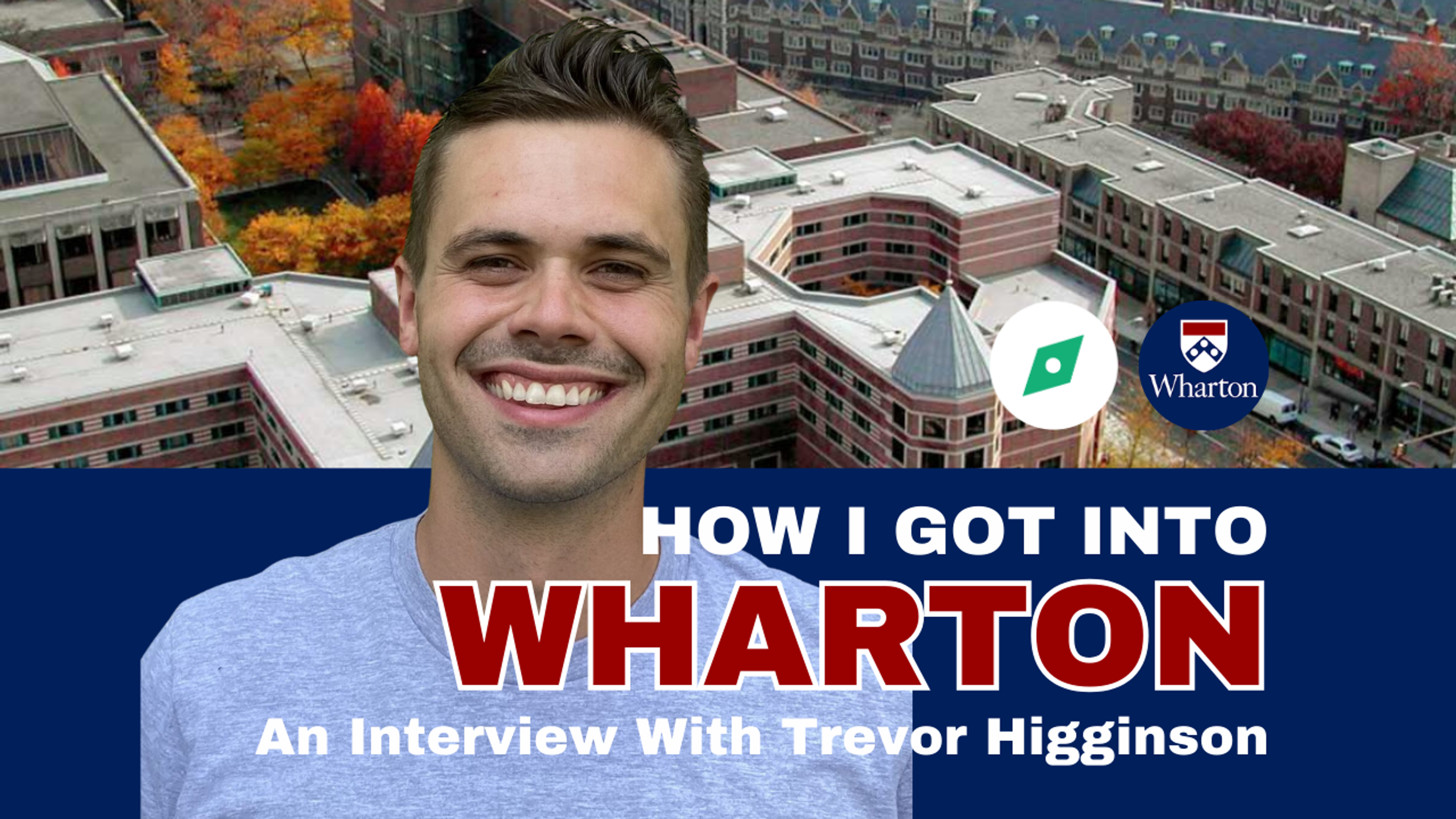
Featuring Matt P.
Planning Your MBA Application
Starting friday, september 6.
12:00 AM UTC · 45 minutes
Table of Contents
Introduction: meet trevor.
I’m Trevor Higginson, originally from Salt Lake City, Utah. I studied finance at the University of Utah and started my career in finance at Ernst & Young. After that, I transitioned to investment banking at a Japanese bank called Mizuho and then moved into secondary private equity investing at Lexington. More recently, I joined a tech startup in Salt Lake City called Aumni, which served the VC space by helping monitor investments and manage legal and economic terms. Last year, Aumni was acquired by J.P. Morgan, and I ended up there as a PM before deciding to pursue my MBA at Wharton.
The application process was grueling and intense, but with the massive help of the Leland community, particularly my coach Chas , along with support from friends and family, I was able to get into Wharton after applying to Harvard, Stanford, and Wharton!
See other admit stories:
How I Got Into Chicago Booth Scholars (Deferred MBA) – An Interview With Bruce Erickson
How i got into stanford gsb as a deferred applicant – an interview with dj fernandez.
- Defining a Narrative of Capability: To Harvard Business School and Beyond
Watch Trevor's Video
Why did you choose to pursue an mba and why wharton.
Many people think of an MBA only in terms of its short-term benefits, like switching industries or climbing the ranks in their current field. But I believe the value of an MBA stretches much further, impacting your career over the next 10, 20, or even 30 years. I wanted to transition from working in a startup that got acquired to a big tech company, specifically in product management. I’ve seen what it’s like to work in a startup, and now I want to experience working in a large organization. Ultimately, I also have ambitions to start my own tech company in the future.
When it came to choosing a school, I only applied to Harvard, Stanford, and Wharton. My mindset was that if I didn’t get into one of these three, I’d continue advancing in my career as a product manager without an MBA. I was drawn to Wharton because of its strong academics, robust recruiting opportunities, and vibrant social and extracurricular scene. I appreciated Wharton’s mix of lecture-style classes, team-based learning, and case studies. This blended approach worked well for me as an undergrad and was something I wanted in my MBA experience.
Read: The Wharton School — MBA Program & Application Overview
How did you decide what schools to apply to?
For me, it was about quality over quantity. Having gone through various roles at different companies, from consulting at EY to investment banking and private equity, I had a clearer sense of where I wanted to go. I was already in product management, and I was happy with that path. So, it made sense to only aim for the top three schools that I felt would give me the best brand, network, and future opportunities. I wasn’t desperate for an MBA; it was more about enhancing my path, not defining it.
Read: How to Choose an MBA Program: The Discerning Student's Guide
Free trial!

From 134 top coaches
Access a library of videos, templates, and examples curated by Leland’s top coaches.
Example essays.
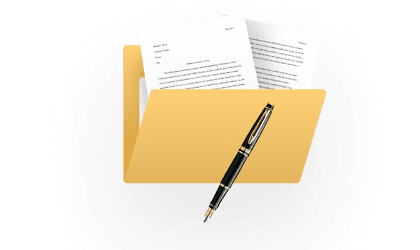
Example Resumes
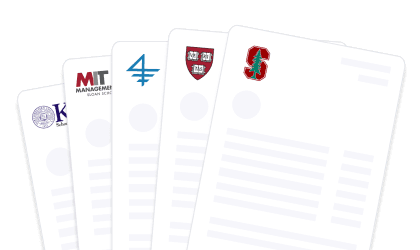
Application Prep

Video Courses

The MBA Application Process
Did you take the gmat or gre how did you decide.
I initially considered taking the GMAT right after undergrad, which is pretty common for people with finance backgrounds. However, I was overwhelmed and decided to wait. When I did start the test prep process, I chose the GRE over the GMAT. This decision came down to my strengths. I realized quickly that the GMAT’s focus on integrated reasoning and certain quant sections didn’t play to my strengths, whereas the GRE had a stronger emphasis on verbal skills and vocabulary, which I was more comfortable with.
I highly recommend taking practice tests for both the GMAT and GRE to see which one aligns better with your strengths. There’s no reason to choose the GMAT just because it’s the traditional route for business school. Play to your strengths and pick the test that suits you best.
Read: GMAT vs. GRE for an MBA—Which Should You Take (and How to Ace Both)
How did you tackle the Wharton essays?
First, I spent a lot of time getting to know Wharton because it’s very student-driven, with many clubs and other initiatives led by students. I looked at Wharton’s website to understand the clubs , courses , and other opportunities they offered. I also spoke to alumni and current students to understand the culture and how it aligned with my goals. This research helped me craft essays that were specific to my background and aspirations, showing how Wharton could bridge the gap between where I am and where I want to be.
Read: Wharton MBA Application Essays: Prompts & Expert Tips
How did you navigate the letters of recommendation?
To decide on my recommenders, I worked with my coach and created a short list of people from my last two jobs who I had worked closely with and who understood my abilities. I chose two recommenders from different employers to provide varied perspectives. With the help of my coach, Chas , I prepared a prompt document for my recommenders, outlining key attributes and anecdotes they could highlight. This made the process easier for them and ensured that their letters complemented my application narrative.
Read: MBA Recommender Questions and Criteria for the Top 10 Business Schools and How to Get the Perfect MBA Letter of Recommendation—With Examples

MBA Recommender Prep Doc
Template and example prep doc to help you guide your recommenders
The Wharton TBD Interview
Wharton’s Team-Based Discussion (TBD) interview is quite different from other MBA interviews. You’re grouped with other applicants to discuss a prompt, and the admissions team observes how you interact. To prepare, I participated in a mock TBD through Leland, which was invaluable. We received detailed feedback on how to handle different roles, like being a timekeeper or ensuring everyone had a chance to speak. Wharton values collaboration, so they want to see you work well in a team, not just dominate the conversation.
Make sure to sign up for Leland to stay in the loop for future mock Wharton TBDs and lots of free events.
Read: Wharton MBA Interview Guide: The Team-Based Discussion (TBD)
Wharton Application: Challenges & Tips
What were the biggest challenges you faced during the application process.
Every part of the process was challenging in its own way. The GRE preparation was grueling, and writing essays that effectively conveyed my story and motivations was tough. Having a coach and a support system made a huge difference. The introspection required to write compelling essays that were true to me and highlighted my unique qualities took a lot of effort and multiple iterations.
What is your top piece of advice for all future MBA applicants, and Wharton applicants more specifically?
The best advice I can give is to start early and give yourself enough time to go deep into the process. Be intentional about why you want an MBA and be prepared to articulate that clearly. A great coach is invaluable—they provide guidance, feedback, and support that can make a real difference.
For Wharton specifically, really understand what makes the program unique. Get to know the culture, the student experience, and how you can contribute. Wharton values a collaborative community, so make sure that comes across in your application.
Wharton MBA Tuition & Fees Breakdown
- MBA Admissions Rounds: When to Apply to Business School
- The MBA Application Timeline—With Chart
- The Ultimate MBA Application Guide (2024)
- How to Craft the Ultimate MBA Resume—With Examples
- Top 25 Business Schools' Acceptance Rates & Class Profiles (2024)
Browse hundreds of expert coaches
Leland coaches have helped thousands of people achieve their goals. A dedicated mentor can make all the difference.
Browse Related Articles

February 3, 2023
How I Got Into Wharton as an International Applicant
How one Leland client got into a top business school as an international applicant from an overrepresented group, plus his advice for others going through the application process.

March 12, 2024
From Biochemistry to Wharton Business School
A Leland customer shares how she went from an undergrad at UPenn studying Biochemistry to Boston Consulting Group and Wharton.

August 27, 2024
How I Got Into Wharton - An Interview With Darrell Hanks
How one applicant who attended a non-target school ended up at one of the best business schools in the world, including an overview of his application process and advice for future MBA candidates.
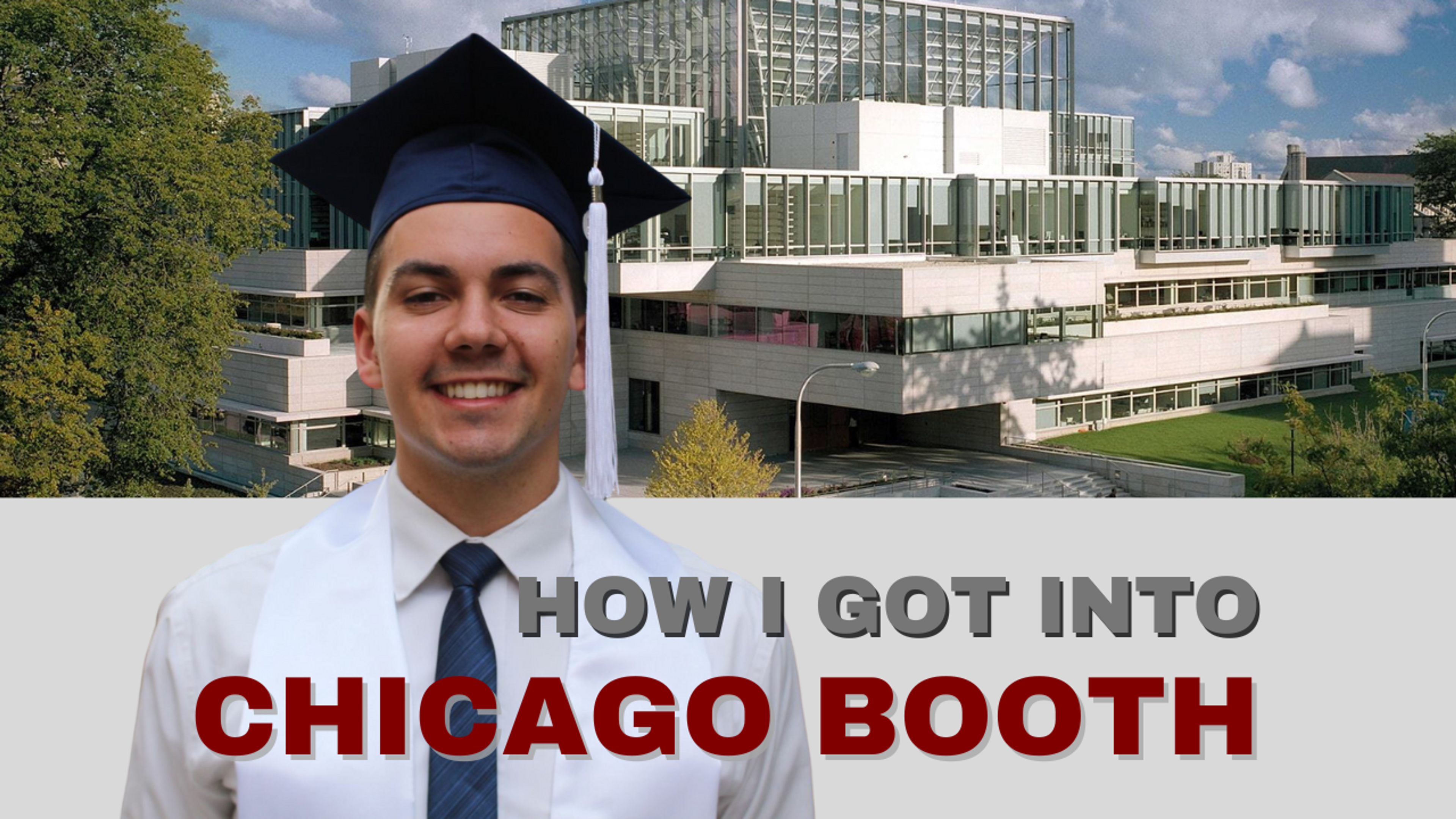
A recent admit to Chicago Booth's deferred MBA program talks about his application, including the challenges, what made his story stand out, how to navigate the interviews, approaching the essays, overcoming imposter syndrome, and more.

January 31, 2024
Discover the ins and outs of Wharton MBA tuition and fees in this comprehensive breakdown.

The Wharton School — MBA Program & Application Overview
Perfect your MBA Application with this guide curated by the best MBA admissions coaches in the world on how to navigate the application process and get into the Wharton MBA program.
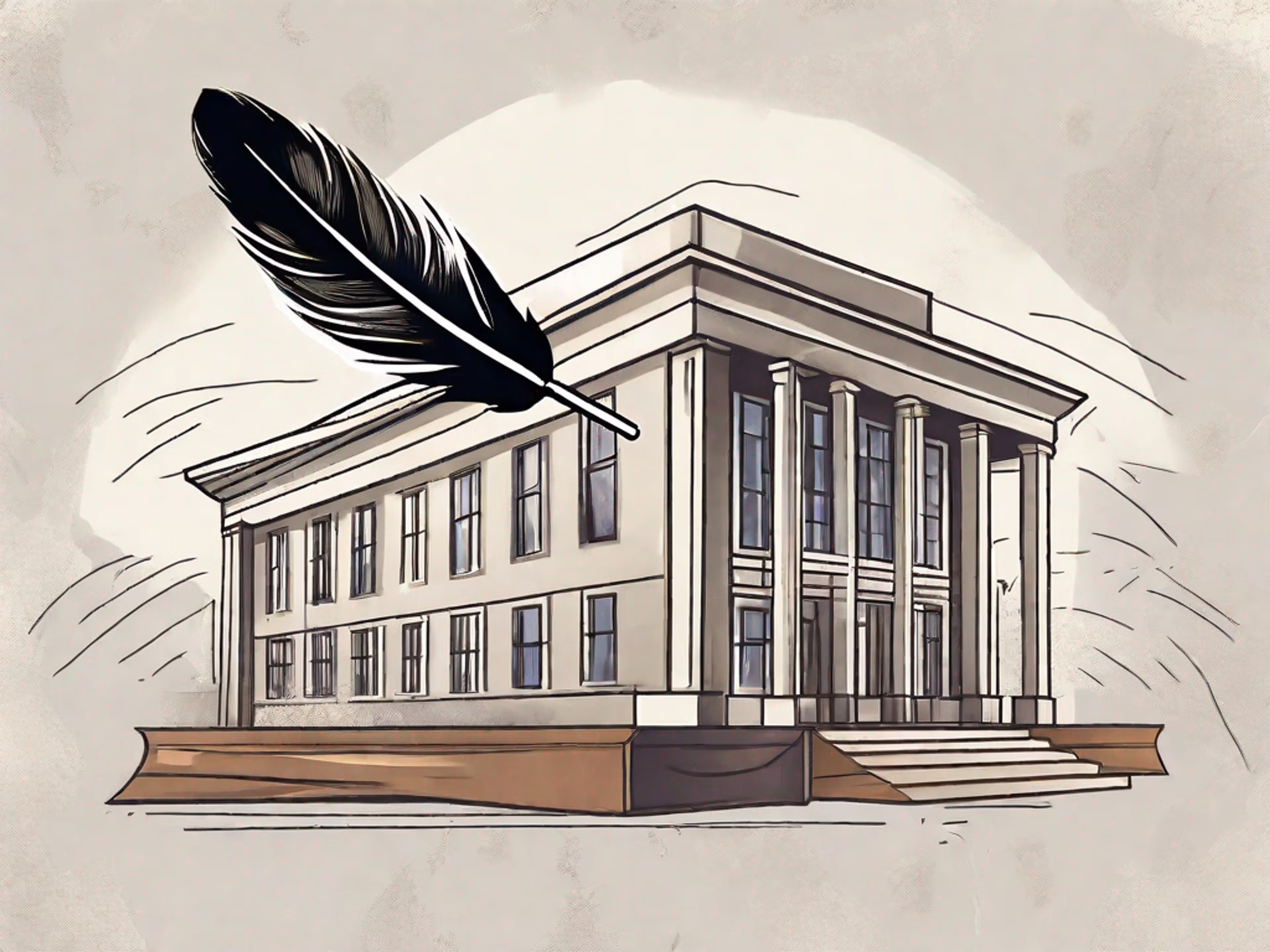
January 10, 2024
Wharton MBA Letters of Recommendation Guide - Questions, Tips, & Examples
Learn how to navigate the Wharton MBA letters of recommendation process with our comprehensive guide.

January 9, 2024
Wharton MBA Acceptance Rates
Discover the latest Wharton MBA acceptance rates and gain valuable insights into the competitive admissions process at one of the world's top business schools.

An admit to Stanford GSB's deferred MBA program talks about his application, including the challenges, what made his story stand out, how to navigate the interviews, approaching the essays, whether to take the GMAT or GRE, and more.

February 1, 2024
The Wharton School – MBA Waitlist Strategy
Learn effective strategies for navigating the MBA waitlist at The Wharton School.

How to Nail the "Why Wharton" MBA Essay
Learn how to craft a compelling 'Why Wharton' MBA essay that sets you apart from the competition. Elevate your application to stand out.

February 2, 2024
Wharton MBA Curriculum Overview - Concentrations, Core, and Electives
Discover the dynamic and comprehensive Wharton MBA curriculum, exploring the diverse range of concentrations, core courses, and elective options.
- Career Exploration
- Arts, Communications, & Media
- Education, Nonprofit, & Public Health
- Business, Consulting, Finance, & Marketing
- Government, International Affairs, Law, & Public Policy
- Health Professions Advising
- Career Essentials Resources
- Graduate School
- Application Support
- Short Internship Projects (SHIPs)
- Fellowships for Undergraduates
- Fellowships for Graduates
- Class of 2025 Fellowship Planning
- Fellowships for International Students
- Civic Engagement
Writing a Personal Statement

Preparing to Write
Brainstorming, don't forget, sample prompts.
A personal statement is a narrative essay that connects your background, experiences, and goals to the mission, requirements, and desired outcomes of the specific opportunity you are seeking. It is a critical component in the selection process, whether the essay is for a competitive internship, a graduate fellowship, or admittance to a graduate school program. It gives the selection committee the best opportunity to get to know you, how you think and make decisions, ways in which past experiences have been significant or formative, and how you envision your future. Personal statements can be varied in form; some are given a specific prompt, while others are less structured. However, in general a personal statement should answer the following questions:
- Who are you?
- What are your goals?
- How does this specific program/opportunity help you achieve your goals?
- What is in the future?
A personal statement is not:
- A variation of your college admissions essay
- An academic/research paper
- A narrative version of your resume
- A creative writing piece (it can be creative, though)
- An essay about somebody else
Keep in mind that your statement is only a portion of the application and should be written with this in mind. Your entire application package will include some, possibly all, of the materials listed below. You will want to consider what these pieces of the application communicate about you. Your personal statement should aim to tie everything together and fill in or address any gaps. There will likely be some overlap but be sure not to be too repetitive.
- Personal Statement(s)
- Transcripts
- Letters of recommendations
- Sample of written work
- Research proposal
For a quick overview of personal statements, you might begin by watching this "5 Minute Fellowships" video!
If you are writing your first personal statement or working to improve upon an existing personal statement, the video below is a helpful, in-depth resource.
A large portion of your work towards completing a personal statement begins well before your first draft or even an outline. It is incredibly important to be sure you understand all of the rules and regulations around the statement. Things to consider before you begin writing:
- How many prompts? And what are they? It is important to know the basics so you can get your ideas in order. Some programs will require a general statement of interest and a focused supplementary or secondary statement closely aligned with the institution's goals.
- Are there formatting guidelines? Single or double spaced, margins, fonts, text sizes, etc. Our general guideline is to keep it simple.
- How do I submit my statement(s)? If uploading a document we highly suggest using a PDF as it will minimize the chances of accidental changes to formatting. Some programs may event ask you to copy and paste into a text box.
- When do I have to submit my statement(s)? Most are due at the time of application but some programs, especially medical schools, will ask for secondary statements a few months after you apply. In these instances be sure to complete them within two weeks, any longer is an indication that you aren't that interested in the institution.
Below is a second 5 Minute Fellowships video that can help you get started!
Before you start writing, take some time to reflect on your experiences and motivations as they relate to the programs to which you are applying. This will offer you a chance to organize your thoughts which will make the writing process much easier. Below are a list of questions to help you get started:
- What individuals, experiences or events have shaped your interest in this particular field?
- What has influenced your decision to apply to graduate school?
- How does this field align with your interests, strengths, and values?
- What distinguishes you from other applicants?
- What would you bring to this program/profession?
- What has prepared you for graduate study in this field? Consider your classes at Wellesley, research and work experience, including internships, summer jobs and volunteer work.
- Why are you interested in this particular institution or degree program?
- How is this program distinct from others?
- What do you hope to gain?
- What is motivating you to seek an advanced degree now?
- Where do you see yourself headed and how will this degree program help you get there?
For those applying to Medical School, if you need a committee letter for your application and are using the Medical Professions Advisory Committee you have already done a lot of heavy lifting through the 2017-2018 Applicant Information Form . Even if you aren't using MPAC the applicant information form is a great place to start.
Another great place to start is through talking out your ideas. You have a number of options both on and off campus, such as: Career Education advisors and mentors ( you can set up an appointment here ), major advisor, family, friends. If you are applying to a graduate program it is especially important to talk with a faculty member in the field. Remember to take good notes so you can refer to them later.
When you begin writing keep in mind that your essay is one of many in the application pool. This is not to say you should exaggerate your experiences to “stand out” but that you should focus on clear, concise writing. Also keep in mind that the readers are considering you not just as a potential student but a future colleague. Be sure to show them examples and experiences which demonstrate you are ready to begin their program.
It is important to remember that your personal statement will take time and energy to complete, so plan accordingly. Every application and statement should be seen as different from one another, even if they are all the same type of program. Each institution may teach you the same material but their delivery or focus will be slightly different.
In addition, remember:
- Be yourself: You aren’t good at being someone else
- Tragedy is not a requirement, reflection and depth are
- Research the institution or organization
- Proofread, proofread, proofread
- How to have your personal statement reviewed
The prompts below are from actual applications to a several types of programs. As you will notice many of them are VERY general in nature. This is why it is so important to do your research and reflect on your motivations. Although the prompts are similar in nature the resulting statements would be very different depending on the discipline and type of program, as well as your particular background and reasons for wanting to pursue this graduate degree.
- This statement should illustrate your academic background and experiences and explain why you would excel in the Department of Civil and Environmental Engineering (UMass Amherst - M.S. in Civil Engineering).
- Describe your academic and career objectives and how the Yale School of Forestry and Environmental Studies can help you achieve them. Include other considerations that explain why you seek admissions to the Yale School of Forestry and Environmental Studies and your interests in the environmental field (Yale - Master of Environmental Management).
- Please discuss your academic interests and goals. Include your current professional and research interests, as well as your long-range professional objectives. Please be as specific as possible about how your objectives can be met at Clark and do not exceed 800 words (Clark University - M.A. in International Development and Social Change).
- Write a 500- to 700-word statement that describes your work or research. Discuss how you came to focus on the medium, body of work, or academic area you wish to pursue at the graduate level. Also discuss future directions or goals for your work, and describe how the Master of Fine Arts in Studio (Printmedia) is particularly suited to your professional goals (School of the Art Institute of Chicago - MFA in Studio, Printmaking).
- Your statement should explain why you want to study economics at the graduate level. The statement is particularly important if there is something unusual about your background and preparation that you would like us to know about you (University of Texas at Austin - Ph.D in Economics).
- Your personal goal statement is an important part of the review process for our faculty members as they consider your application. They want to know about your background, work experience, plans for graduate study and professional career, qualifications that make you a strong candidate for the program, and any other relevant information (Indiana University Bloomington - M.S.Ed. in Secondary Education).
- Your autobiographical essay/personal statement is a narrative that outlines significant experiences in your life, including childhood experiences, study and work, your strengths and aspirations in the field of architecture, and why you want to come to the University of Oregon (University of Oregon - Master of Architecture).
- Personal history and diversity statement, in which you describe how your personal background informs your decision to pursue a graduate degree. You may refer to any educational, familial, cultural, economic or social experiences, challenges, community service, outreach activities, residency and citizenship, first-generation college status, or opportunities relevant to your academic journey; how your life experiences contribute to the social, intellectual or cultural diversity within a campus community and your chosen field; or how you might serve educationally underrepresented and underserved segments of society with your graduate education (U.C. Davis - M.A. in Linguistics).
- A Personal Statement specifying your past experiences, reasons for applying, and your areas of interest. It should explain your intellectual and personal goals, why you are interested in pursuing an interdisciplinary degree rather than a more traditional disciplinary one, and how this degree fits into your intellectual and personal future (Rutgers University - Ph.D in Women’s and Gender Studies).
- Your application requires a written statement to uploaded into your application and is a critical component of your application for admission. This is your opportunity to tell us what excites you about the field of library and information science, and what problems you want to help solve in this field. Please also tell us how your prior experiences have prepared you for this next step toward your career goals and how this program will help you achieve them (University of North Carolina Chapel Hill - Master of Science in Library Science).
- After watching the video, please describe what strengths and preferences as a learner you have that will facilitate your success in this innovative curriculum. What challenges in our curriculum do you anticipate and what strategies might you use to address these challenges? (MGH Institute of Health Professions PT - They recently redesigned their curriculum)
- Your personal goal statement should briefly describe how you view the future of the field, what your goals are to be part of that future, and what brought you to pursue an advanced education degree in your chosen field. You may include any other information that you feel might be useful. (Northeastern PT)
- Personal Statement: In 500 words or less, describe a meaningful educational experience that affected your professional goals and growth and explain how it impacted you. The educational experience does not need to be related to this degree. Focus on the educational experience and not why you think you would be a good professional in this field. (Simmons PT)
- Personal Statement (500 word minimum): State your reasons for seeking admission to this program at this institution. Include your professional goals, why you want to pursue a career in this field and how admission to this program will assist you in accomplishing those goals. (Regis College Nursing)
- “Use the space provided to explain why you want to go to this type of program.” (AMCAS)
- Address the following three questions(Though there is no set limit, most statements are 1–2 pages, single-spaced.): What are your reasons for pursuing this degree? Why do you wish to pursue your degree at this institution? How do you intend to leverage your degree in a career of this field? (Boston University MPH)
- Please submit a personal statement/statement of purpose of no more than 500 words for the department/degree of choice. Professional degree essays require a clear understanding of the _______ field and how you hope to work within the field. Be sure to proofread your personal statement carefully for spelling and grammar. In your statement, be sure to address the following: what interests you in the field of _____ what interests you in a specific degree program and department at this institution and what interests you in a particular certificate (if applicable). Please also describe how you hope to use your ________ training to help you achieve your career goals. (Columbia PhD in Public Health - Epidemiology)
- Because each Home Program requires significant original research activities in fulfillment of the requirements for the degree, we are interested in obtaining as much information as possible about your previous research experiences. Those who already have such experience are in a better position to know whether they are truly interested in performing ______ research as part of a graduate program. Please include specific information about your research experience in your Statement of Purpose. You may also use the Statement to amplify your comments about your choice of Home Program(s), and how your past experiences and current interests are related to your choice. Personal Statements should not exceed two pages in length (single spaced). Make sure to set your computer to Western European or other English-language setting. We cannot guarantee the ability to access your statement if it is submitted in other fonts. (Stanford Biosciences PhD)
- Your statement of purpose should describe succinctly your reasons for applying to the Department of ____ at ___ University. It would be helpful to include what you have done to prepare for this degree program. Please describe your research interests, past research experience, future career plans and other details of your background and interests that will allow us to evaluate your ability to thrive in our program. If you have interests that align with a specific faculty member, you may state this in your application. Your statement of purpose should not exceed two pages in length (single spaced). (Stanford Bioengineering PhD)
- Statement of purpose (Up to one page or 1,000 words): Rather than a research proposal, you should provide a statement of purpose. Your statement should be written in English and explain your motivation for applying for the course at this institution and your relevant experience and education. Please provide an indication of the area of your proposed research and supervisor(s) in your statement. This will be assessed for the coherence of the statement; evidence of motivation for and understanding of the proposed area of study; the ability to present a reasoned case in English; and commitment to the subject. (Oxford Inorganic Chemistry - DPhil)
Related resources
Calculate for all schools
Your chance of acceptance, your chancing factors, extracurriculars, application process for military colleges.
Okay, so I've decided I want to apply to military colleges. But, I'm kinda lost. Is the application process any different than for civilian colleges? How competitive are these schools?
The application process to military colleges can be a little more involved compared to standard civilian colleges. In addition to the common application, an essay, teacher recommendations, and high school transcript, you'll often need to pass a physical fitness exam and secure a nomination from a Congressman or Senator in your state. It's a good idea to start this process early.
How competitive these schools are can vary, but in general, they can be quite selective. For example, the United States Military Academy (West Point) and the United States Naval Academy have acceptance rates of around 10%, making them as competitive as many Ivy League institutions.
Keep in mind that these schools are not just looking for academic prowess, but also physical strength and leadership potential. Therefore, your extracurriculars can play a significant role — particularly those that demonstrate teamwork, leadership, or athletic endeavors.
Furthermore, West Point and the Naval Academy each require a commitment of several years of active service after graduation, so it's important to be sure about your decision to pursue this path. It's not just about the education, but also about your future career and obligations to serve in the military after graduation.
Overall, if you're passionate about serving your country and prepared for the physical and leadership demands of the program, military colleges can be an excellent choice. Just be aware that the application process is unique and requires early preparation and commitment.
About CollegeVine’s Expert FAQ
CollegeVine’s Q&A seeks to offer informed perspectives on commonly asked admissions questions. Every answer is refined and validated by our team of admissions experts to ensure it resonates with trusted knowledge in the field.
Numbers, Facts and Trends Shaping Your World
Read our research on:
Full Topic List
Regions & Countries
- Publications
- Our Methods
- Short Reads
- Tools & Resources
Read Our Research On:
Key things to know about U.S. election polling in 2024

Confidence in U.S. public opinion polling was shaken by errors in 2016 and 2020. In both years’ general elections, many polls underestimated the strength of Republican candidates, including Donald Trump. These errors laid bare some real limitations of polling.
In the midterms that followed those elections, polling performed better . But many Americans remain skeptical that it can paint an accurate portrait of the public’s political preferences.
Restoring people’s confidence in polling is an important goal, because robust and independent public polling has a critical role to play in a democratic society. It gathers and publishes information about the well-being of the public and about citizens’ views on major issues. And it provides an important counterweight to people in power, or those seeking power, when they make claims about “what the people want.”
The challenges facing polling are undeniable. In addition to the longstanding issues of rising nonresponse and cost, summer 2024 brought extraordinary events that transformed the presidential race . The good news is that people with deep knowledge of polling are working hard to fix the problems exposed in 2016 and 2020, experimenting with more data sources and interview approaches than ever before. Still, polls are more useful to the public if people have realistic expectations about what surveys can do well – and what they cannot.
With that in mind, here are some key points to know about polling heading into this year’s presidential election.
Probability sampling (or “random sampling”). This refers to a polling method in which survey participants are recruited using random sampling from a database or list that includes nearly everyone in the population. The pollster selects the sample. The survey is not open for anyone who wants to sign up.
Online opt-in polling (or “nonprobability sampling”). These polls are recruited using a variety of methods that are sometimes referred to as “convenience sampling.” Respondents come from a variety of online sources such as ads on social media or search engines, websites offering rewards in exchange for survey participation, or self-enrollment. Unlike surveys with probability samples, people can volunteer to participate in opt-in surveys.
Nonresponse and nonresponse bias. Nonresponse is when someone sampled for a survey does not participate. Nonresponse bias occurs when the pattern of nonresponse leads to error in a poll estimate. For example, college graduates are more likely than those without a degree to participate in surveys, leading to the potential that the share of college graduates in the resulting sample will be too high.
Mode of interview. This refers to the format in which respondents are presented with and respond to survey questions. The most common modes are online, live telephone, text message and paper. Some polls use more than one mode.
Weighting. This is a statistical procedure pollsters perform to make their survey align with the broader population on key characteristics like age, race, etc. For example, if a survey has too many college graduates compared with their share in the population, people without a college degree are “weighted up” to match the proper share.
How are election polls being conducted?
Pollsters are making changes in response to the problems in previous elections. As a result, polling is different today than in 2016. Most U.S. polling organizations that conducted and publicly released national surveys in both 2016 and 2022 (61%) used methods in 2022 that differed from what they used in 2016 . And change has continued since 2022.
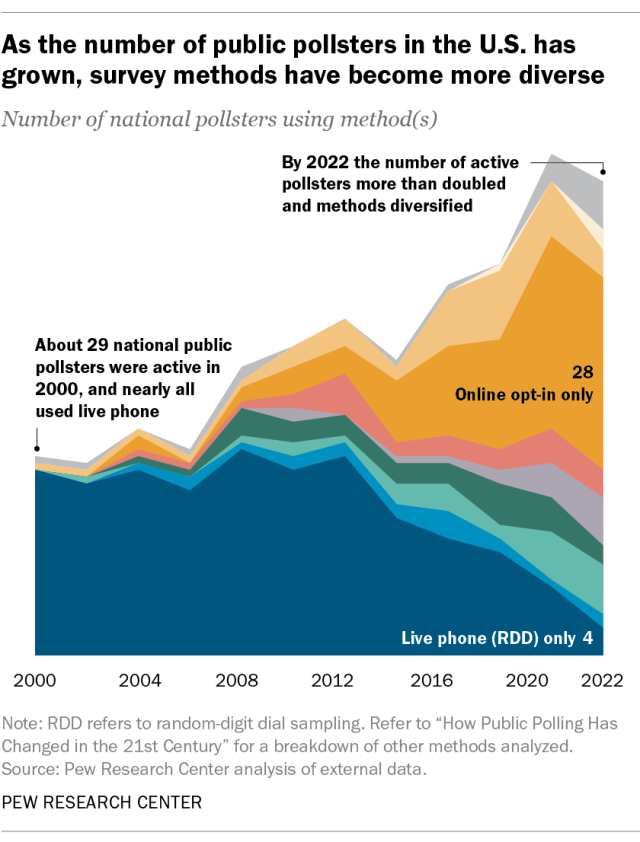
One change is that the number of active polling organizations has grown significantly, indicating that there are fewer barriers to entry into the polling field. The number of organizations that conduct national election polls more than doubled between 2000 and 2022.
This growth has been driven largely by pollsters using inexpensive opt-in sampling methods. But previous Pew Research Center analyses have demonstrated how surveys that use nonprobability sampling may have errors twice as large , on average, as those that use probability sampling.
The second change is that many of the more prominent polling organizations that use probability sampling – including Pew Research Center – have shifted from conducting polls primarily by telephone to using online methods, or some combination of online, mail and telephone. The result is that polling methodologies are far more diverse now than in the past.
(For more about how public opinion polling works, including a chapter on election polls, read our short online course on public opinion polling basics .)
All good polling relies on statistical adjustment called “weighting,” which makes sure that the survey sample aligns with the broader population on key characteristics. Historically, public opinion researchers have adjusted their data using a core set of demographic variables to correct imbalances between the survey sample and the population.
But there is a growing realization among survey researchers that weighting a poll on just a few variables like age, race and gender is insufficient for getting accurate results. Some groups of people – such as older adults and college graduates – are more likely to take surveys, which can lead to errors that are too sizable for a simple three- or four-variable adjustment to work well. Adjusting on more variables produces more accurate results, according to Center studies in 2016 and 2018 .
A number of pollsters have taken this lesson to heart. For example, recent high-quality polls by Gallup and The New York Times/Siena College adjusted on eight and 12 variables, respectively. Our own polls typically adjust on 12 variables . In a perfect world, it wouldn’t be necessary to have that much intervention by the pollster. But the real world of survey research is not perfect.

Predicting who will vote is critical – and difficult. Preelection polls face one crucial challenge that routine opinion polls do not: determining who of the people surveyed will actually cast a ballot.
Roughly a third of eligible Americans do not vote in presidential elections , despite the enormous attention paid to these contests. Determining who will abstain is difficult because people can’t perfectly predict their future behavior – and because many people feel social pressure to say they’ll vote even if it’s unlikely.
No one knows the profile of voters ahead of Election Day. We can’t know for sure whether young people will turn out in greater numbers than usual, or whether key racial or ethnic groups will do so. This means pollsters are left to make educated guesses about turnout, often using a mix of historical data and current measures of voting enthusiasm. This is very different from routine opinion polls, which mostly do not ask about people’s future intentions.
When major news breaks, a poll’s timing can matter. Public opinion on most issues is remarkably stable, so you don’t necessarily need a recent poll about an issue to get a sense of what people think about it. But dramatic events can and do change public opinion , especially when people are first learning about a new topic. For example, polls this summer saw notable changes in voter attitudes following Joe Biden’s withdrawal from the presidential race. Polls taken immediately after a major event may pick up a shift in public opinion, but those shifts are sometimes short-lived. Polls fielded weeks or months later are what allow us to see whether an event has had a long-term impact on the public’s psyche.
How accurate are polls?
The answer to this question depends on what you want polls to do. Polls are used for all kinds of purposes in addition to showing who’s ahead and who’s behind in a campaign. Fair or not, however, the accuracy of election polling is usually judged by how closely the polls matched the outcome of the election.
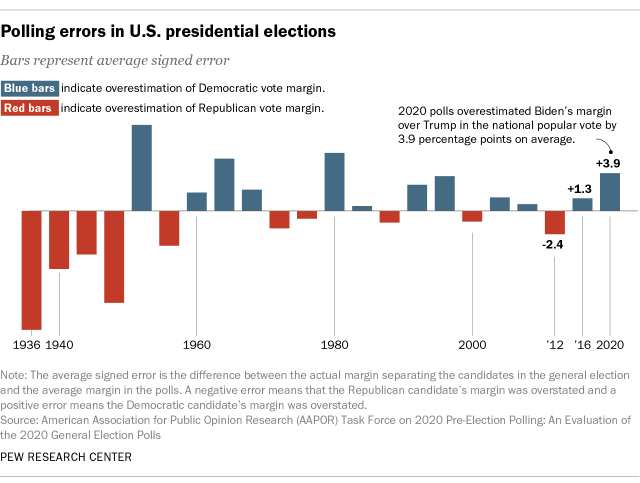
By this standard, polling in 2016 and 2020 performed poorly. In both years, state polling was characterized by serious errors. National polling did reasonably well in 2016 but faltered in 2020.
In 2020, a post-election review of polling by the American Association for Public Opinion Research (AAPOR) found that “the 2020 polls featured polling error of an unusual magnitude: It was the highest in 40 years for the national popular vote and the highest in at least 20 years for state-level estimates of the vote in presidential, senatorial, and gubernatorial contests.”
How big were the errors? Polls conducted in the last two weeks before the election suggested that Biden’s margin over Trump was nearly twice as large as it ended up being in the final national vote tally.
Errors of this size make it difficult to be confident about who is leading if the election is closely contested, as many U.S. elections are .
Pollsters are rightly working to improve the accuracy of their polls. But even an error of 4 or 5 percentage points isn’t too concerning if the purpose of the poll is to describe whether the public has favorable or unfavorable opinions about candidates , or to show which issues matter to which voters. And on questions that gauge where people stand on issues, we usually want to know broadly where the public stands. We don’t necessarily need to know the precise share of Americans who say, for example, that climate change is mostly caused by human activity. Even judged by its performance in recent elections, polling can still provide a faithful picture of public sentiment on the important issues of the day.
The 2022 midterms saw generally accurate polling, despite a wave of partisan polls predicting a broad Republican victory. In fact, FiveThirtyEight found that “polls were more accurate in 2022 than in any cycle since at least 1998, with almost no bias toward either party.” Moreover, a handful of contrarian polls that predicted a 2022 “red wave” largely washed out when the votes were tallied. In sum, if we focus on polling in the most recent national election, there’s plenty of reason to be encouraged.
Compared with other elections in the past 20 years, polls have been less accurate when Donald Trump is on the ballot. Preelection surveys suffered from large errors – especially at the state level – in 2016 and 2020, when Trump was standing for election. But they performed reasonably well in the 2018 and 2022 midterms, when he was not.
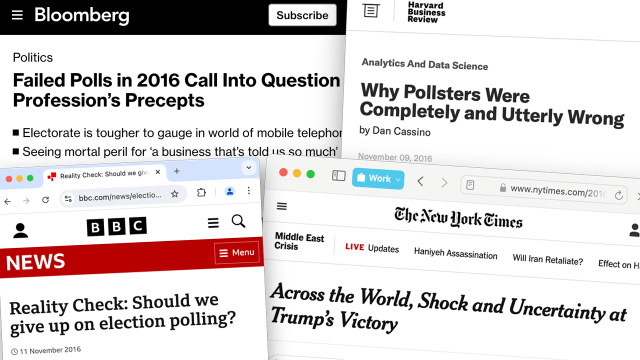
During the 2016 campaign, observers speculated about the possibility that Trump supporters might be less willing to express their support to a pollster – a phenomenon sometimes described as the “shy Trump effect.” But a committee of polling experts evaluated five different tests of the “shy Trump” theory and turned up little to no evidence for each one . Later, Pew Research Center and, in a separate test, a researcher from Yale also found little to no evidence in support of the claim.
Instead, two other explanations are more likely. One is about the difficulty of estimating who will turn out to vote. Research has found that Trump is popular among people who tend to sit out midterms but turn out for him in presidential election years. Since pollsters often use past turnout to predict who will vote, it can be difficult to anticipate when irregular voters will actually show up.
The other explanation is that Republicans in the Trump era have become a little less likely than Democrats to participate in polls . Pollsters call this “partisan nonresponse bias.” Surprisingly, polls historically have not shown any particular pattern of favoring one side or the other. The errors that favored Democratic candidates in the past eight years may be a result of the growth of political polarization, along with declining trust among conservatives in news organizations and other institutions that conduct polls.
Whatever the cause, the fact that Trump is again the nominee of the Republican Party means that pollsters must be especially careful to make sure all segments of the population are properly represented in surveys.
The real margin of error is often about double the one reported. A typical election poll sample of about 1,000 people has a margin of sampling error that’s about plus or minus 3 percentage points. That number expresses the uncertainty that results from taking a sample of the population rather than interviewing everyone . Random samples are likely to differ a little from the population just by chance, in the same way that the quality of your hand in a card game varies from one deal to the next.
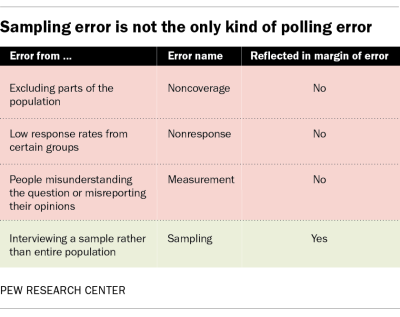
The problem is that sampling error is not the only kind of error that affects a poll. Those other kinds of error, in fact, can be as large or larger than sampling error. Consequently, the reported margin of error can lead people to think that polls are more accurate than they really are.
There are three other, equally important sources of error in polling: noncoverage error , where not all the target population has a chance of being sampled; nonresponse error, where certain groups of people may be less likely to participate; and measurement error, where people may not properly understand the questions or misreport their opinions. Not only does the margin of error fail to account for those other sources of potential error, putting a number only on sampling error implies to the public that other kinds of error do not exist.
Several recent studies show that the average total error in a poll estimate may be closer to twice as large as that implied by a typical margin of sampling error. This hidden error underscores the fact that polls may not be precise enough to call the winner in a close election.
Other important things to remember
Transparency in how a poll was conducted is associated with better accuracy . The polling industry has several platforms and initiatives aimed at promoting transparency in survey methodology. These include AAPOR’s transparency initiative and the Roper Center archive . Polling organizations that participate in these organizations have less error, on average, than those that don’t participate, an analysis by FiveThirtyEight found .
Participation in these transparency efforts does not guarantee that a poll is rigorous, but it is undoubtedly a positive signal. Transparency in polling means disclosing essential information, including the poll’s sponsor, the data collection firm, where and how participants were selected, modes of interview, field dates, sample size, question wording, and weighting procedures.
There is evidence that when the public is told that a candidate is extremely likely to win, some people may be less likely to vote . Following the 2016 election, many people wondered whether the pervasive forecasts that seemed to all but guarantee a Hillary Clinton victory – two modelers put her chances at 99% – led some would-be voters to conclude that the race was effectively over and that their vote would not make a difference. There is scientific research to back up that claim: A team of researchers found experimental evidence that when people have high confidence that one candidate will win, they are less likely to vote. This helps explain why some polling analysts say elections should be covered using traditional polling estimates and margins of error rather than speculative win probabilities (also known as “probabilistic forecasts”).
National polls tell us what the entire public thinks about the presidential candidates, but the outcome of the election is determined state by state in the Electoral College . The 2000 and 2016 presidential elections demonstrated a difficult truth: The candidate with the largest share of support among all voters in the United States sometimes loses the election. In those two elections, the national popular vote winners (Al Gore and Hillary Clinton) lost the election in the Electoral College (to George W. Bush and Donald Trump). In recent years, analysts have shown that Republican candidates do somewhat better in the Electoral College than in the popular vote because every state gets three electoral votes regardless of population – and many less-populated states are rural and more Republican.
For some, this raises the question: What is the use of national polls if they don’t tell us who is likely to win the presidency? In fact, national polls try to gauge the opinions of all Americans, regardless of whether they live in a battleground state like Pennsylvania, a reliably red state like Idaho or a reliably blue state like Rhode Island. In short, national polls tell us what the entire citizenry is thinking. Polls that focus only on the competitive states run the risk of giving too little attention to the needs and views of the vast majority of Americans who live in uncompetitive states – about 80%.
Fortunately, this is not how most pollsters view the world . As the noted political scientist Sidney Verba explained, “Surveys produce just what democracy is supposed to produce – equal representation of all citizens.”
- Survey Methods
- Trust, Facts & Democracy
- Voter Files

Scott Keeter is a senior survey advisor at Pew Research Center .

Courtney Kennedy is Vice President of Methods and Innovation at Pew Research Center .
How do people in the U.S. take Pew Research Center surveys, anyway?
How public polling has changed in the 21st century, what 2020’s election poll errors tell us about the accuracy of issue polling, a field guide to polling: election 2020 edition, methods 101: how is polling done around the world, most popular.
901 E St. NW, Suite 300 Washington, DC 20004 USA (+1) 202-419-4300 | Main (+1) 202-857-8562 | Fax (+1) 202-419-4372 | Media Inquiries
Research Topics
- Email Newsletters
ABOUT PEW RESEARCH CENTER Pew Research Center is a nonpartisan fact tank that informs the public about the issues, attitudes and trends shaping the world. It conducts public opinion polling, demographic research, media content analysis and other empirical social science research. Pew Research Center does not take policy positions. It is a subsidiary of The Pew Charitable Trusts .
© 2024 Pew Research Center

IMAGES
VIDEO
COMMENTS
Hook sentence. Background information. Thesis statement. Step 1: Begin with the basics. Describe the initial steps or preparations required. Explain any tools, materials, or ingredients needed. Provide safety precautions if necessary. Step 2: Break Down the Process. Divide the process into clear, sequential steps.
A process essay is a type of essay that explains a process step by step and gives guidance for a certain process, working mechanism, procedure, etc. Process essays range from very simple ones, such as instructions for how to ride a bicycle, to more complex ones, such as a chemistry lab report of an oxidative reaction experiment.
Be accountable. 2. How something works. By contrast, this is an informative type of writing that aims to achieve one goal - explain the principle of work behind some process. Unlike the mentioned above type, this process essay type does not encourage a reader to take an action and do something step by step. However, you must make sure that by ...
Start by Brainstorming. The first step in writing your how-to essay is brainstorming. Here are tips to help you: Draw a line down the middle of a sheet of paper to make two columns. Label one column "materials" and the other column "steps." Write down every item and every step you can think of that will be needed to carry out your task.
5 Process Essay Examples. Written by Chris Drew (PhD) | January 18, 2024. A process essay is a type of essay that explains a process in detail. Good process essays don't just explain the process but provides details about common mistakes to avoid as well as tips and methods to achieve success. Below are some example essays:
A process essay is a step-by-step guide on how to do or make something. It is important to include every step of the process, even if something appears self-explanatory. Your audience might not be as familiar on the topic as you are. What may be equally important, and is often overlooked, is what not to do. For example, the process of making ...
2. Make a list of the materials needed. Go through the process from start to finish and write down every single item that someone would need to complete the task. Include everything from the common to the unusual. Then, keep the list by you as you write and check off each item as you mention it.
Process Essay. Process is a rhetorical style that provides step-by-step directions or guidance. You may encounter quite a few process essays of various types in academic writing—everything from a traditional process essay in which you choose a topic and describe the process to a lab report in which you describe the process of conducting a lab ...
Definition. A process essay is a typical "how-to" paper that describes some process or workflow, hence the name. The primary idea behind this type of essay is to give a step-by-step explanation of a process that leads to a planned or expected outcome. The paper may revolve around a concrete or precise and an abstract process.
Learn how to describe a process clearly and concisely with these process analysis essay examples and tips for structuring your essay.
Process Essay Examples. If you want some practice at writing your own process essays, here are some example topics: How to train your dog to sit. How to send a text message. How to start a small business online. How to change the oil in your car. If you don't know how to do any of these things, you'll need to research first.
The process essay is writing that explains how to do something or how something works by giving a step-by-step explanation. There are three keys to a process essay: present the essential steps in the process, explain the steps in detail, and present the steps in logical order (usually chronological).
1. Focus on Simplicity. As a guide on doing something, most probably for the first time, a process essay should be easy to follow and understand. Use simple language with clear directions on how to perform all the processes. The choice of words and the construction of sentences must meet the reader's understanding.
For example, you may write in your process paper: "Making sushi takes 30 minutes of preparation time and 10 minutes of cooking.". The next action is to write a thesis statement. It is one sentence that describes the research problem to be considered in the paper. It can be the last sentence of the introduction.
A process essay gives reader a sense of complete how-to-do process of making or creating some objects or things. Readers, after going through the essay, are able to create and make things. Although it is not like imperative instructions, it gives full details in a descriptive or prescriptive mode. It is because its major objective is not to ...
A process analysis essay is a kind of expository essay that explains the process or actions someone needs to take to complete a task. You can think of it like a recipe, stating all of the necessary ingredients and steps, allowing the reader to follow along in logical order. A process analysis essay can be written about a wide scope of topics, from highly technical processes to cleaning and ...
The topic of a process analysis essay needs to be as specific as possible, and the tone of the essay must be clear and straightforward. A writer's main goal when crafting a process analysis essay should be to make a process easy to follow. ... Examples of Great Introductory Paragraphs. How to Write a Descriptive Paragraph. 50 Argumentative ...
Before you even begin to write your essay, you have to understand the parts that comprise an essay. For example, a process essay intended for professional chefs could probably skip a description of how to chop carrots and just say, "Finely chop the carrots," instead. 2. Make a list of the materials needed.
Step 2: Crafting the Thesis Statement. Crafting a strong thesis statement is a crucial step in the process of writing a process essay. Your thesis statement serves as the roadmap for your essay, guiding readers on what to expect and helping you maintain focus throughout the writing process.
When you read over the list of how-to examples below you will realize that you do know many things in depth, some well enough to teach. Typically, your inspiration will be based on lateral thinking. For example, from the list below, you may decide to write an essay on how to cook a Scottish egg after you see "Crack an egg" in the list. Or you ...
A process essay is an essay that explains or outlines the process for making something or completing a process or activity. Process essays are most often organized in a chronological or step-by-step manner, such that the reader is lead through the process of making something or completing an activity.. Because of the step-by-step nature of a process essay, transition words are critically ...
Table of contents. Step 1: Prewriting. Step 2: Planning and outlining. Step 3: Writing a first draft. Step 4: Redrafting and revising. Step 5: Editing and proofreading. Other interesting articles. Frequently asked questions about the writing process.
Make sure you choose a topic that you're well versed in and have significant knowledge of. Having prior knowledge of the topic will help you determine the subsequent steps to write an essay. It will also make your research process considerably easier. 2. Form an appropriate thesis statement.
Your essay should have one central theme or focus. You should provide examples and anecdotes that link to the central theme. Structuring the Essay . You should create an essay outline consisting of an introduction, body paragraphs, and a conclusion. Set more free-writing timers to write the body and conclusion.
The GRE preparation was grueling, and writing essays that effectively conveyed my story and motivations was tough. Having a coach and a support system made a huge difference. The introspection required to write compelling essays that were true to me and highlighted my unique qualities took a lot of effort and multiple iterations.
A personal statement is a narrative essay that connects your background, experiences, and goals to the mission, requirements, and desired outcomes of the specific opportunity you are seeking. It is a critical component in the selection process, whether the essay is for a competitive internship, a graduate fellowship, or admittance to a graduate school program.
How to Start Writing a Law School Essay To get started on a personal statement, brainstorm your best stories and don't stunt the writing process. Gabriel Kuris Aug. 5, 2024
The application process to military colleges can be a little more involved compared to standard civilian colleges. In addition to the common application, an essay, teacher recommendations, and high school transcript, you'll often need to pass a physical fitness exam and secure a nomination from a Congressman or Senator in your state. It's a good idea to start this process early.
All good polling relies on statistical adjustment called "weighting," which makes sure that the survey sample aligns with the broader population on key characteristics. Historically, public opinion researchers have adjusted their data using a core set of demographic variables to correct imbalances between the survey sample and the population.